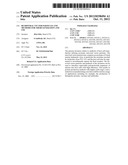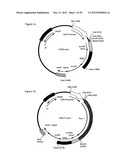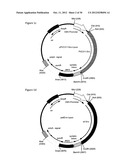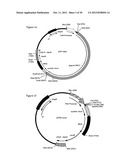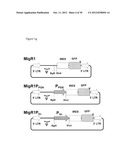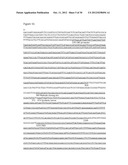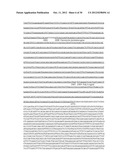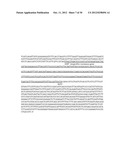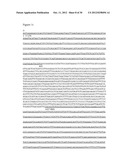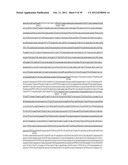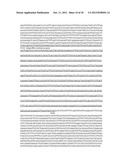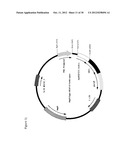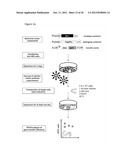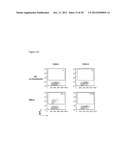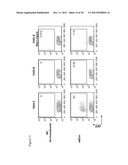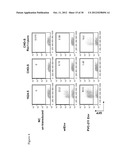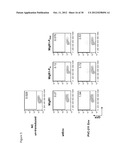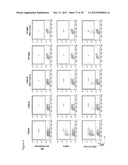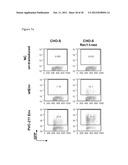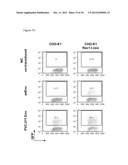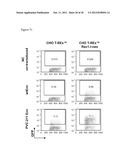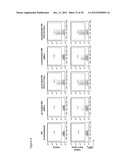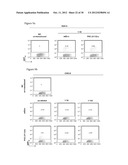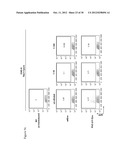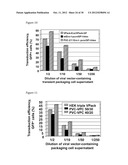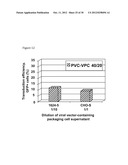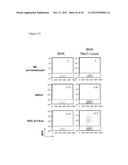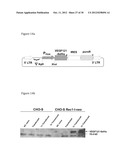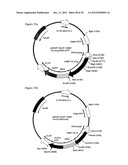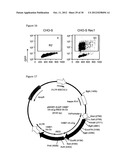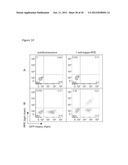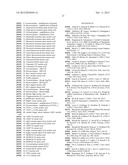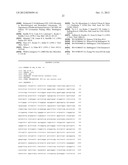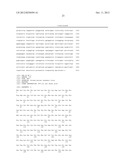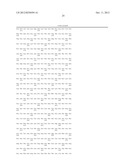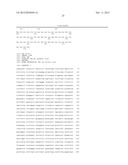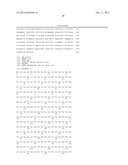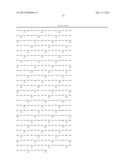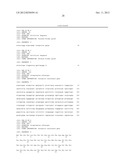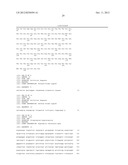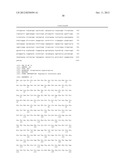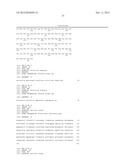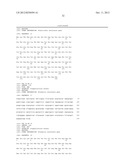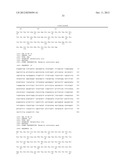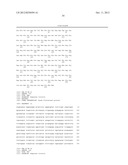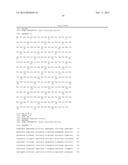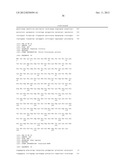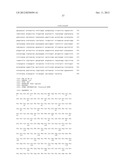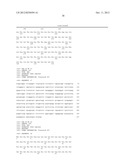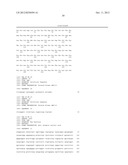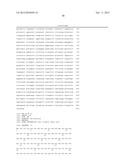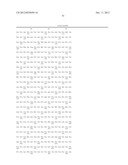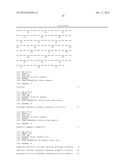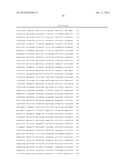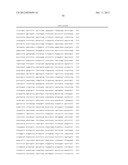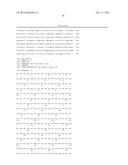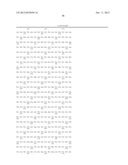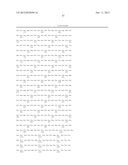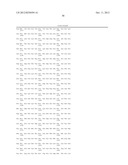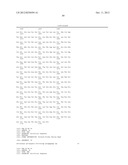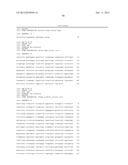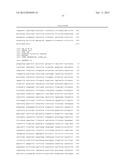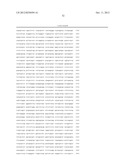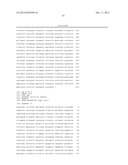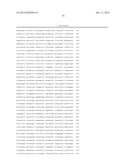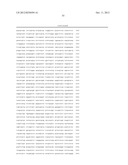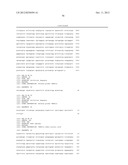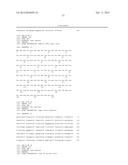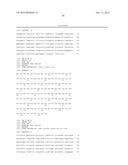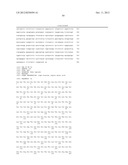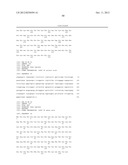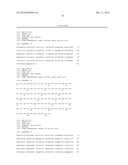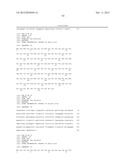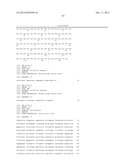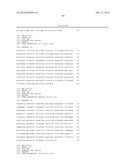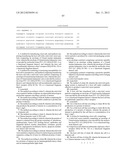Patent application title: Retroviral Vector Particles and Methods for their Generation and Use
Inventors:
Jörn Stitz (Basel, CH)
Assignees:
4-Anitbody AG
IPC8 Class: AC12N15867FI
USPC Class:
435 693
Class name: Micro-organism, tissue cell culture or enzyme using process to synthesize a desired chemical compound or composition recombinant dna technique included in method of making a protein or polypeptide antigens
Publication date: 2012-10-11
Patent application number: 20120258494
Abstract:
The present invention relates to methods of host cell transduction
utilising ecotropic retroviral vector particles. The retroviral vector
particle may comprise an envelope of Friend murine leukaemia virus, in
particular the envelope encoded by molecular clone PVC-211 and the host
cell may be engineered to recombinantly express the Reel receptor. The
retroviral vector particles and methods of the invention can be used to
introduce expressible polynucleotide sequences of interest into host
cells with high efficiency. This results in protein production methods
with higher yield (mg/L) and a reduction in manufacturing costs that
could be used in a range of applications including for example, the
production of therapeutic proteins, vaccines and antibodies.Claims:
1. A method for transducing a host cell, said method comprising
transducing the host cell with a retroviral vector particle comprising an
envelope of Friend murine leukaemia virus, wherein the envelope of Friend
murine leukaemia virus is encoded by molecular clone PVC-211 (SEQ ID NO:
1) or a functional fragment thereof, and wherein the host cell
recombinantly expresses a Rec1 receptor (SEQ ID No: 32) or a functional
fragment thereof.
2. A method for conferring or increasing susceptibility of a host cell to transduction, said method comprising transducing the host cell with a retroviral vector particle comprising an envelope of Friend murine leukaemia virus, wherein the envelope of Friend murine leukaemia virus is encoded by molecular clone PVC-211 (SEQ ID NO: 1) or a functional fragment thereof, and wherein the host cell recombinantly expresses a Rec1 receptor (SEQ ID No: 32) or a functional fragment thereof.
3. (canceled)
4. The method according to claim 1, wherein the retroviral vector particle further comprises an expressible heterologous nucleotide sequence encoding a protein of interest.
5. The method according to claim 4, further comprising the step of culturing the host cell under conditions to produce the protein of interest.
6. The method according to claim 5, wherein said culturing step produces the protein of interest at a concentration of at least 1 mg/L.
7. The method according to claim 1, wherein the host cell is a hamster cell.
8. The method according to claim 1, wherein the host cell is a Chinese hamster ovary (CHO) cell.
9. The method according to claim 4, wherein the protein of interest is selected from the group consisting of: interferons, erythropoietin, Factor VIII, clotting factors, antibodies and fragments thereof, insulin, chemokines, cytokines, growth factors, angiogenesis modulatory factors, apoptosis modulatory factors and vaccines.
10. The method according to claim 4, wherein the retroviral vector particle comprises at least two heterologous nucleotide sequences coding for at least two different proteins of interest.
11. The method according to claim 10, wherein the at least two proteins of interest are an immunoglobulin heavy chain and an immunoglobulin light chain.
12. The method according to claim 1, wherein the retroviral vector particle is produced by a retroviral packaging system comprising: a) an envelope construct comprising a promoter operably linked to an envelope coding sequence of a Friend murine leukaemia virus, wherein the envelope of Friend murine leukaemia virus is encoded by molecular clone PVC-211 (SEQ ID NO: 1) or a functional fragment thereof; and b) a packaging construct comprising a promoter operably linked to a nucleotide sequence encoding a retroviral gag and pol; and c) a retroviral transfer vector.
13. (canceled)
14. The method of claim 12, wherein the retroviral packaging system is expressed in a host cell under conditions effective to produce a retroviral vector particle.
15. (canceled)
16. A host cell line transduced with a retroviral vector particle comprising an envelope of Friend murine leukaemia virus encoded by the molecular clone PVC-211 (SEQ ID No: 1) or a functional fragment thereof, wherein the host cell line recombinantly expresses a Rec1 receptor.
17. (canceled)
18. Use of the host cell line according to claim 16 for the production of a protein of interest.
19. Use of the host cell line according to claim 16 for the production of a protein of interest, wherein the protein of interest is produced by the cell line at a concentration of at least 1 mg/L.
20. A system for transducing a host cell, comprising: a) a retroviral vector particle comprising an envelope of Friend murine leukaemia virus encoded by the molecular clone PVC-211 (SEQ ID No: 1) or a functional fragment thereof; and b) a target host cell which recombinantly expresses a Rec1 receptor (SEQ ID No: 32) or a functional fragment thereof.
21. The host cell line of claim 16, wherein the cell is a hamster cell.
22. The host cell line of claim 21, wherein the hamster cell is a Chinese hamster ovary (CHO) cell.
Description:
FIELD OF THE INVENTION
[0001] The present invention describes methods for the generation of retroviral vector particles facilitating enhanced gene transfer efficiency upon transduction of host cells. In particular, the present invention relates to methods for retroviral transduction using ecotropic murine leukaemia virus (MLV)-derived vector particles and methods for modifying host cells to further increase gene transfer efficiency.
BACKGROUND
[0002] Over the last decade, the research work of many pharmaceutical and biotechnology companies has focused on the generation of biological products using recombinant DNA technology. Such biopharmaceutical products include e.g. enzymes, synthetic hormones, vaccines, monoclonal antibodies, cytokines. Whilst simple proteins can be produced using bacterial cultures, more complex proteins with a requirement for carbohydrate modification, e.g. glycosylation, assembly of different subunits, correct folding and functionality need to be produced in mammalian cells. Mammalian cell cultures are traditionally used for the production of glycosylated recombinant protein products and commonly used cell lines include, Chinese hamster ovary (CHO) cells, 293 Human embryonic Kidney (HEK) cells, COS cells, Baby Hamster Kidney (BHK) cells, PER.C6® and mouse myeloma cell lines such as NS0 or Sp2/0.
[0003] Since recombinant proteins for the therapy of human diseases need to have natural folding and post-translational modification and because they need to remain pharmacologically active for a defined shelf-life, supply of recombinant proteins for clinical studies and therapy requires the development of a highly reproducible and controlled production process. Such a process should ensure high quality and stability of the product in accordance with the quality obligations of the regulatory authorities at an acceptable cost of goods.
[0004] Mammalian cell lines, which allow the production of therapeutic proteins, are required to have high productivities and stable phenotypic and genotypic product expression profiles. The introduction of genetic information into a host cell genome by the process of DNA transfection is acknowledged to be an inefficient process. Therefore the present invention addresses this problem by utilising a method of retroviral transduction to achieve highly efficient transfer of genetic information into the genome of host cells. A current method of retroviral expression of recombinant proteins in the only industry approved production cell line utilises a pantropic vector with the ability to infect all species and therefore requires a Bio safety level 2 (BSL2) system (Bleck, 2005). This is a potential safety concern for the generation of therapeutic proteins resulting in higher costs during production to ensure staff safety and comply with the associated regulations. These drawbacks can be overcome by the use of an ecotropic retrovirus vector particle as described in the present invention, which has a restricted host cell infectivity and can therefore be used without safety concerns, resulting in lower production costs.
SUMMARY OF THE INVENTION
[0005] An embodiment of the present invention provides a method for transducing a host cell utilising a retroviral vector particle. The retroviral vector particle can comprise or be pseudotyped with an envelope of an ecotropic murine leukaemia virus (MLV) or a portion of the envelope that enables the pseudotyped retroviral vector particle to retain the host range and infectivity conferred by the full length envelope. Preferably the envelope is from Friend murine leukaemia virus (Fr-MLV), and more preferably the envelope is from a variant of Fr-MLV known as PVC-211 MLV. The envelope of PVC-211 (encoded by the nucleic acid of SEQ ID No: 1) displays the host range and infectivity of the native retrovirus (e.g. ecotropic MLV or Fr-MLV) but has not been used before for the generation of retroviral vector particles for the transduction of host cells. Since an ecotropic MLV envelope is used, the infectivity of the retroviral vector particle is limited to the same species and therefore these retroviral vector particles can only infect rodent species. Hence use of these retroviral vector particles in laboratory work requires only BSL 1 conditions, resulting in negligible safety concerns and significantly reduced costs, when compared to working under BSL2 conditions for example.
[0006] Host cells previously resistant to transfection or transduction with a retroviral vector particle comprising a wild type envelope (wtEnv) of Moloney murine leukaemia virus (Mo-MLV) show susceptibility or increased susceptibility to transduction when the retroviral vector particle comprises a Fr-MLV envelope. Preferably, the Fr-MLV envelope is from PVC-211. As such, the present invention provides a method for conferring or increasing susceptibility of a host cell to transduction comprising use of a retroviral vector particle comprising an envelope of Fr-MLV. In a preferred embodiment, the envelope of Fr-MLV is encoded by molecular clone PVC-211 (SEQ ID No: 1) or a fragment thereof, which when expressed has the same function as the full length PVC-211 envelope protein.
[0007] In one embodiment, said PVC-211 functional fragment effects transfection or transduction of a retroviral vector particle comprising an envelope of an ecotropic MLV into a host cell (e.g. a rodent cell). In one embodiment, said host cell is a host cell (e.g. a rodent cell) that is not (or is only poorly) susceptible to transfection or transduction with a retroviral vector particle comprising a wtEnv of Mo-MLV. In one embodiment, a functional fragment comprises a nucleotide sequence that has at least 80% (e.g. at least 85%, at least 90%, at least 92%, at least 94%, at least 96%, at least 98%, at least 99%) sequence identity to a nucleotide sequence consisting of at least 1500 contiguous nucleotides (eg. at least 1600 contiguous nucleotide, at least 1700 contiguous nucleotides, at least 1800 contiguous nucleotides, at least 1900 contiguous nucleotides, at least 2000 contiguous nucleotides) of SEQ ID NO: 1.
[0008] Use of a retroviral vector particle of the invention (e.g. comprising an envelope of PVC-211) results in much higher transduction efficiencies than the use of a retroviral vector particle comprising a wild type envelope of Mo-MLV.
[0009] Transduction efficiency can be further increased by the recombinant expression of the receptor for ecotropic MLV known as Rec1 (SEQ ID No: 32) or a functional fragment of this receptor sequence, in the target host cell. By expression of this receptor, host cells that were previously resistant to infection by ecotropic MLV particles become permissive to infection.
[0010] In one embodiment, expression of said Rec1 functional fragment in a host cell effects (e.g. facilitates or enhances) transfection or transduction of a retroviral vector particle comprising an envelope of an ecotropic MLV into said host cell (e.g. a rodent cell). In one embodiment, said host cell is a host cell (e.g. a rodent cell) that is not (or is only poorly) susceptible to transfection or transduction with a retroviral vector particle comprising a wtEnv of Mo-MLV. In one embodiment, a functional fragment comprises an amino acid sequence that has at least 80% (e.g. at least 85%, at least 90%, at least 92%, at least 94%, at least 96%, at least 98%, at least 99%) sequence identity to an amino acid sequence consisting of at least 400 contiguous amino acid residues (eg. at least 450 contiguous amino acid residues, at least 500 contiguous amino acid residues, at least 550 contiguous amino acid residues, at least 600 contiguous amino acid residues) of SEQ ID NO: 32.
[0011] The present invention therefore provides a method for increasing transduction efficiency comprising transducing a host cell with a retroviral vector particle comprising an ecotropic envelope of MLV, wherein the host cell recombinantly expresses the Rec1 receptor. Preferably the host cell is a hamster cell, more preferably the host cell is a Chinese hamster ovary (CHO) cell. Preferably the envelope of MLV is from a Fr-MLV, more preferably the envelope is encoded by molecular clone PVC-211 (SEQ ID No: 1) or a functional fragment thereof. The present invention demonstrates very high levels of transduction efficiency due to the synergistic effect resulting from the transduction of a host cell recombinantly expressing the Rec1 receptor with a retroviral vector particle comprising the envelope of PVC-211. The retroviral vector particles of the present invention can therefore be utilised to provide protein production methods with higher yields and a reduction in manufacturing costs, which could be used in a range of applications including for example, the production of therapeutic proteins, vaccines and antibodies. It has been demonstrated for the present invention that protein can be produced at a concentration of at least 1 mg/L in host cells recombinantly expressing the Rec1 receptor, transduced with a retroviral vector particle comprising the envelope of PVC-211.
[0012] In a further embodiment, the present invention provides a retroviral packaging cell for producing a retroviral vector particle comprising:
a) an envelope construct comprising a promoter operably linked to an envelope coding sequence of a Fr-MLV, wherein the envelope of Fr-MLV is encoded by molecular clone PVC-211 (SEQ ID NO: 1) or a functional fragment thereof; and b) a packaging construct comprising a promoter operably linked to a nucleotide sequence encoding a retroviral gag and pol.
[0013] In addition to the envelope and packaging constructs, the packaging cell may also comprise a retroviral transfer vector. The transfer vector may comprise the components of a retroviral 5' LTR, a retroviral packaging sequence distal to the 5' LTR and a retroviral 3' LTR. In addition, the transfer vector may also comprise an internal ribosome entry site (IRES) and/or a marker gene such as a fluorescent protein, for example, GFP. Furthermore, the transfer vector may also comprise a heterologous nucleotide sequence, which encodes a protein of interest.
[0014] In an embodiment of the present invention, the packaging cell and transfer vector as described above can be coexpressed in a host cell under conditions effective to produce a retroviral vector particle. Suitable host cells can be selected from any mammalian or human cell line.
[0015] The retroviral vector particle generated by the above method can be used to transduce a target host cell so that the nucleotide sequence coding for a protein of interest is integrated into the host cell genome and the protein encoded by the gene is subsequently expressed by the host cell. Preferably the host cell is a hamster cell, more preferably a CHO cell.
[0016] Methods according to the present invention may be used to transduce host cells to produce a protein of interest. The transduced host cells are cultured under conditions so that a protein encoded by the gene of interest is expressed and then the expressed protein can be isolated from the culture and purified. The concentration of purified protein produced is preferably at a level of 1 mg/L or more.
[0017] The retroviral vector particle may encode at least one gene of interest, preferably at least two genes of interest. Preferably two genes of interest comprise an immunoglobulin heavy chain and an immunoglobulin light chain. However, in an alternative embodiment two genes of interest may be located on separate retroviral vector particles so that one retroviral vector particle comprises a gene that codes for an immunoglobulin heavy chain and another retroviral vector particle comprises a gene that code for an immunoglobulin light chain.
DESCRIPTION OF THE FIGURES
[0018] FIG. 1 shows schematic designs of expression constructs that can be used in the present invention. The drawings depict the schematic design of expression cassettes in a standard DNA cloning backbone (closed black line), containing the ampicilin-resistance gene (AmpR) and the bacterial origin of replication (ori). All non-retroviral expression vectors shown (FIGS. 1a to f) contain a poly-adenylation signal (polyA signal; black and white dashed box), an internal ribosome entry site (IRES; black box), a synthetic intron (black and white dotted box), and a promoter driving the expression of the transgene inserted 5' of the synthetic intron. In FIGS. 1(a) to 1(e), the promoter is derived from human cytomegalovirus (CMV; white arrow). In FIG. 1(f), the promoter originates from the murine phospho-glycerol kinase housekeeper gene (Ppgk; grey dashed box).
[0019] FIG. 1a: The construct pIRES-puro contains the reporter gene puromycin-resistance (puroR) flanked by the restriction-sites for XmaI and XbaI. This parental vector does not encompass any other transgene. The multiple cloning site 3' of the CMV-promoter includes unique restriction-sites for ClaI, NotI, EcoRI and BamHI in the multiple cloning site (MCS) for convenient insertion of an open reading frame (coding region) of choice.
[0020] FIG. 1b: pRec1-I-puro is derived from pIRES-puro and was modified by the insertion of the coding region of the receptor of ecotropic murine leukaemia virus (MLV) Rec1 using the restriction-sites NotI and BamHI.
[0021] FIG. 1c: pPVC-211 Env-I-puro was constructed by insertion of the envelope coding region of the molecular clone PVC-211 of ecotropic MLV into the recipient vector pIRES-puro using the sites in the MCS for NotI and EcoRI.
[0022] FIG. 1d: pwtEnv-I-puro was generated as for pPVC-211 Env-I-puro above, but encompasses the envelope coding region of wild type ecotropic MLV.
[0023] FIG. 1e: In contrast to FIGS. 1c and 1d, pIRES-bleo served as the recipient vector for the generation of the packaging construct pGP-1-bleo. In this vector, the selectable marker gene bleomycin-resistance (bleoR) is flanked by the restriction-sites XbaI and XmaI which allows for the controlled selection of transfected and bleomycin-resistant cells that will also express the structural genes of gag/pol of MLV (gag-pol (MLV)) inserted into the MCS employing NotI and EcoRI.
[0024] FIG. 1f: pPpgk-I-puro contains the murine phospho glycerol kinase gene promoter (Ppgk promoter) flanked by the restriction-sites MluI and ClaI replacing the CMV-promoter in the afore-mentioned constructs. The puromycin-resistance gene serves as a selectable marker (puroR).
[0025] FIG. 1g: Schematic illustration of the retroviral transfer vectors MigR1 and its derivates MigR1Ppgk and MigR1Pv.sub.κ. The parental vector MigR1 encompasses the flanking long terminal repeats (5' and 3' LTR), the packaging signal (psi/Ψ) required for the packaging of mRNA-transcripts of the transfer vector into MLV-derived vector particles, an internal ribosome entry site (IRES) and the reporter gene of green fluorescence protein (GFP). Unique restriction-sites for BglII and XhoI 5' of the IRES are indicated and were used for the insertion of the promoter of the murine phospho glycerol kinase gene (Ppgk) or the human promoter of the variable kappa chain genes (Pv.sub.κ). A black arrow indicates the position of the stop codon of the reporter gene.
[0026] FIG. 1h: Nucleotide sequence of the pIRES-puro construct (1-5021 base pairs (bp)), shown in FIG. 1a. The vector components are at the positions as indicated in FIG. 1h and as listed herein: CMV promoter (230-820 bp), Multiple cloning site (MCS; 909-971 bp), Synthetic intron (974-1269 bp), IRES (1295-1881 bp), puromycin resistance gene (1888-2487 bp), poly A signal (2489-2773 bp) and ampicillin resistance gene (4087-4603 bp).
[0027] FIG. 1i: Nucleotide sequence of the MigR1 vector (6231 bp), shown schematically in FIG. 1g. The vector components are at the positions as indicated in FIG. 1h and as listed herein: 5'LTR (1-400 bp), IRES (1437-2012), GFP (2025-2744), 3'LTR (3050-3550) and ampicillin resistance gene (5362-4505).
[0028] FIG. 1j: The construct MigR1Ppgk-VEGF121-6×HIS-I-puro contains the murine Ppgk promoter flanked by the restriction sites for BgIII and XhoI. This promoter drives the expression of the human variant of VEGF121, flanked by the restriction sites NotI and EcoRI, which harbours a His-tag consisting of six histidine residues at the C-terminus, and the puromycin resistance gene. An IRES located between both genes couples their expression from the same mRNA transcript. This transcript is flanked by 5' and 3' LTRs.
[0029] FIG. 2a: Schematic illustration of the standard experimental procedure to test retroviral vector particle-mediated transduction of target cells. The retroviral vector components; envelope construct, packaging construct and transfer vector encoding the reporter gene GFP are transiently transfected into HEK cells. Two days post transfection, cell-free viral vector particle-containing supernatants are harvested and subjected to spin-infection of target cells. Upon continuous culture for at least one additional day, cells are analyzed for the expression of the reporter gene GFP using fluorescence-activated cell sorting (FACS).
[0030] FIG. 2b: FACS-analysis of transduced murine 1624-5 pre-B and Chinese hamster ovary CHO-S cells using MLV-based vector particles displaying the envelope wtEnv of ecotropic MLV (Mo-MLV). Untransduced cells served as negative controls (NC). The expression of the transduced reporter gene GFP is detected.
[0031] FIG. 3: FACS-analysis of transduced murine 1624-5 pre-B cells, CHO-S cells and CHO-S cell transfectants, expressing the recombinant receptor of ecotropic MLV Red (CHO-S Rec1-I-puro). MLV-based vector particles displaying the envelope wtEnv of ecotropic MLV were used. Untransduced cells served as negative controls (NC). The expression of the transduced reporter gene GFP is detected.
[0032] FIG. 4: FACS-analysis of the expression of the reporter gene GFP in transduced murine 1624-5 pre-B cells, CHO-S cells and CHO-S cell transfectants, expressing the recombinant receptor of ecotropic MLV Rec1 (CHO-S Rec1-I-puro). MLV-based vector particles displaying either the envelope wtEnv of ecotropic MLV, or the envelope of the molecular clone PVC-211 were used, as indicated. Untransduced cells served as negative controls (NC).
[0033] FIG. 5: Comparison of GFP reporter gene expression in transduced CHO-S cells using different MigR1-based retroviral expression vectors. MLV-based vector particles displaying the envelope wtEnv of ecotropic MLV or the envelope of the molecular clone PVC-211 were used. Untransduced cells served as negative controls (NC). The transfer vectors MigR1, MigR1Ppgk and MigR1Pv.sub.κ were employed as indicated.
[0034] FIG. 6: FACS-analysis of murine preB cell line 1624-5, CHO-S, CHO-S Rec1-I-puro, non-permissive human fibrosarcoma HT1080 and HT1080 Rec1-I-neo cells expressing the recombinant ecotropic receptor of MLV for the expression of the reporter gene GFP. MLV-based vector particles displaying the envelope wtEnv of ecotropic MLV or the envelope of the molecular clone PVC-211 were used as indicated. Untransduced cells served as negative controls (NC).
[0035] FIG. 7: FACS-analysis of the expression of the reporter gene GFP in different CHO-derived transduced cell lines, (a) CHO-S, (b) CHO-K1, (c) and CHO T-REx®, in the presence or absence of recombinant expression of the ecotropic receptor Rec1 (Rec1-I-neo). MLV-based vector particles displaying either the envelope wtEnv of ecotropic MLV, or the envelope of the molecular clone PVC-211 were used, as indicated. Untransduced cells served as negative controls (NC).
[0036] FIG. 8: Comparison of transduction efficiency with untreated or concentrated retroviral vector particle-containing cell culture supernatants, analysed by FACS for the expression of the transduced reporter gene GFP. Particles were concentrated using ultra-filtration. MLV-based vector particles either displaying the envelope wtEnv of ecotropic MLV, or the envelope of the molecular clone PVC-211 were used, as indicated. Untransduced cells served as negative controls (NC).
[0037] FIG. 9: FACS-analysis for the expression of the transduced reporter gene GFP using titrated vector containing supernatants in (a) 1624-5 cells, (b) CHO-S cells and (c) CHO-S Rec1-I-puro. Cells were exposed to vector preparations with similar multiplicity of infection (MOI) using different dilutions (undiluted, 1/10 and 1/100) and different envelopes. MLV-based vector particles displaying the envelope wtEnv of ecotropic MLV or the envelope of the molecular clone PVC-211 were used. Untransduced cells served as negative controls (NC).
[0038] FIG. 10: Transduction efficiencies (% GFP positive cells) using serial dilutions of retroviral vector particle containing cell culture supernatant in 1624-5 target cells using different vector component expression constructs for transient HEK-based packaging cell and vector particle generation as indicated. MigR1Ppgk served as a transfer vector in all three cases.
[0039] FIG. 11: Transduction efficiencies (% GFP positive cells) using serial dilutions of retroviral vector particle containing cell culture supernatant in 1624-5 target cells using VPack-vector component system (grey) for transient HEK-based packaging cell and vector particle generation or the stable packaging cell lines PVC-VPC 50/30 (black) and PVC-VPC 40/20 (dashed) as indicated. MigR1 served as a transfer vector in all three cases.
[0040] FIG. 12: Transduction efficiencies (% GFP positive cells) using different dilutions of retroviral vector particle containing cell culture supernatant in 1624-5 and CHO-S target cells from the stable packaging cell line PVC-VPC 40/20 as indicated. Vector particle-containing supernatants were employed for transduction either undiluted (1/1) or diluted 1/10 as indicated. MigR1Zeo served as a transfer vector.
[0041] FIG. 13: Comparison of transduction efficiencies of MLV-based vector particles either displaying the envelope wtEnv of ecotropic MLV or the envelope of the molecular clone PVC-211 on BHK cells and BHK cells expressing the recombinant receptor of ecotropic MLV Rec1 (BHK Rec1-I-puro), as indicated. Transduction efficiencies were analyzed by FACS for the GFP reporter gene. Untransduced cells served as negative controls (NC).
[0042] FIG. 14: Utilization of MLV vector particles displaying the PVC-211 envelope for the generation of highly efficient protein producer cell lines. (a) Schematic illustration of the retroviral transfer vector pMigR1Ppgk-VEGF121-6×His-I-puro. The promoter of the murine Ppgk (dashed arrow, flanked by restriction sites of BglII and XhoI) drives the expression of the human variant of VEGF121, which harbours a His-tag consisting of six histidine residues at the C-terminus (VEGF121-6×His; dark grey box) and the puromycin-resistance gene (puroR; light grey box). An IRES (white box) located between both genes couples their expression from the same mRNA transcript. This transcript is flanked by LTRs (white arrows) at the 5'- and 3'-ends. The packaging signal (psi/0 facilitates the packaging of the mRNA into MLV-based particles. (b) Western Blot-analysis of supernatants of puromycin-resistant VEGF121-6×His producer cell lines. The apparent molecular weight of 19.4 kD and the signal of detected VEGF121-6×His proteins (arrow) are indicated.
[0043] FIG. 15: Shown in FIG. 15a is the construct pMigR1-EnhP-146B7-Vh-sCg-IRES-GFP containing the murine kappa intron enhancer element (KiE) and the murine Vkappa promoter (Pv.sub.κ). This promoter drives the expression of the heavy chain of an anti-IL-15 antibody 146B7 comprising the Vh coding region, flanked by the restriction sites for HindIII and Eco471II, and the IgH constant region (sCg). An IRES located between the 146B7-Vh-sCg and the GFP gene couples their expression from the same mRNA transcript. This transcript is flanked by 5' and 3' LTRs.
[0044] FIG. 15b shows the construct pMigR1-EnhP-146B7-Vk-Ck-IRES-bcl2 containing the murine kappa intron enhancer element (KiE) and the murine Vkappa promoter (Pv.sub.κ). This promoter drives the expression of the light chain of an anti-Il-15 antibody 146B7 comprising the Vk coding region, flanked by the restriction sites for HindIII and EcoRI, and the kappa constant region (Ck). An IRES located between the 146B7-Vk-Ck and the bcl2A gene couples their expression from the same mRNA transcript. This transcript is flanked by 5' and 3' LTRs.
[0045] FIG. 16: Comparison of transduction efficiencies 72 h after transduction of MLV-based vector particles displaying the envelope of the molecular clone PVC-211 on CHO-S cells (negative control) and CHO-S cells expressing the recombinant receptor of ecotropic MLV Rec1 (CHO-S Rec1-neo), as indicated. Transduction efficiencies of retroviral particles coding for recombinant antibody heavy chain were analyzed by FACS for GFP reporter gene expression. 63% of the target cells were transduced.
[0046] FIG. 17: This figure shows the construct pMigR1-EnhP-146B7-Vh-sCg-IRES-Vk-Ck, a bicistronic vector containing the murine kappa intron enhancer element (KiE) and the murine Vkappa promoter (Pv.sub.κ). This promoter drives the expression of the heavy and light chain of an anti-1'-15 antibody 146B7. An IRES located between the 146B7-Vh-sCg and the 146B7-Vk-Ck couples their expression from the same mRNA transcript. This transcript is flanked by 5' and 3' LTRs.
[0047] FIG. 18: This figure confirms the expression of anti IL-1β B cell receptor (BCR) on the cell surface of CHO-S Rec1-hygro target cells. After co-transduction with retroviral vectors 14% (Row B, right hand column) of the co-transduced CHO-S Rec1-hygro target cells expressed BCRs on their surface as indicated by GFP and RPE double positive cells. Row A shows the negative control of untransduced CHO-S Rec1-hygro cells. Row B shows CHO-S Rec1-hygro cells co-transduced with the transfer vectors pMigR1-EnhP-SK48E26-Vh-sCg-IRES-GFP and pMigR1-EnhP-SK48E26-Vk-Ck-IRES-bcl2.
Terminology
[0048] Retroviral vector particle: A retroviral vector particle is a replication deficient retroviral particle that contains two copies of retroviral RNA (the transcript of the transfer vector), usually containing expression cassettes for a gene of interest. A retroviral vector particle is generated upon expression of helper virus constructs such as a packaging construct (providing the structural proteins Gag and Pol) and an envelope construct (providing the structural protein Env), wherein the constructs may or may not include a packaging signal, or a packaging construct providing all three structural proteins combined on one construct without a packaging signal, together with a transfer vector in one cell in a stable or transient fashion. A retroviral vector particle can be used to target delivery of a gene of interest encoded on the vector once only into target cells, a process called transduction.
[0049] A replication competent full-length retroviral genome is not used for the generation of retroviral vector particles and therefore the particles do not transfer full-length retroviral genomes and do not establish productive infection resulting in the generation of new infectious retroviral particles upon transduction into permissive or susceptible cells. Retroviral vector particles upon target cell entry deliver only transfer vector mRNA (the vector particle genome) comprising the long terminal repeats (LTRs) and the packaging signal psi (ψ), in addition to other nucleic acid sequences of choice, for example, reporter genes, IRES and/or coding regions of a gene of interest.
[0050] Retroviral vector particles can be derived from all members of the retrovirus family including Lentivirus, Spumavirus and Onco-retrovirus.
[0051] Retrovirus envelope proteins or Env proteins: the retroviral proteins found on the surface of the virion. The env gene typically encodes the envelope proteins/envelope of retroviruses. The native retroviral env gene product is generally a polyprotein precursor (in MLV it is referred to as gp85, a precursor protein) that is proteolytically cleaved during transport to yield two polypeptides. These two proteolytic cleavage products are (1) the surface protein (also referred to as SU protein and gp70) and (2) the transmembrane protein, TM or pl5E. The SU protein is responsible for recognizing and binding to cellular receptors. The TM protein is involved in mediating the fusion of viral and cellular membranes necessary for virion entry and infection of the target cell.
[0052] Pseudotyped retrovirus: a retroviral vector comprising a heterologous envelope protein i.e. an envelope protein derived from a different retrovirus or virus.
[0053] Packaging cell/Packaging cell line: an engineered cell/cell line that does not produce a replication-competent retroviral genome but which provides the structural and functional Gag, Pol and Env proteins required for packaging of a replication-defective retroviral vector for the production of retroviral vector particles in the cell culture supernatant of the packaging cell/cell line.
[0054] Transfecting/Transfection: In the context of eukaryotic cells this is the process of introducing nucleic acid sequences into eukaryotic cells, usually associated with using chemical and/or physical methods.
[0055] Transforming/Transformation: In the context of eukaryotic cells this is the process of immortalizing a cell for the establishment of a continuously proliferating cell line.
[0056] Transducing: The process of delivering retroviral genomes into vertebrate host cells via the use of retroviral vector particles. For this, a packaging cell line, expressing structural proteins for viral particles (Gag, Pol and Env) is transfected with a recombinant viral vector construct comprising the regulatory elements for packaging of the viral vector construct into a retroviral vector particle. The produced retroviral vector particles can be used to transduce host cells leading to the stable integration of the retroviral vector encoded genetic information into the host cell genome.
[0057] Vector/Construct: A nucleic acid sequence which can be used to clone and to amplify genetic sequences and which allows the shuttling of genetic information between different organisms and species for further amplification and functional analysis.
DETAILED DESCRIPTION
[0058] Recombinant proteins can be produced in various expression systems such as prokaryotic (e.g. E. coli), eukaryotic (e.g. yeast, insect, vertebrate, mammalian), and in vitro expression systems.
[0059] Most commonly used methods for the large-scale production of protein-based biologics rely on the introduction of genetic material into host cells (production cells) by transfection of DNA vectors. While this leads to a transient expression of recombinant proteins, the transfected DNA vectors are rapidly degraded or get diluted upon culture of the production cells. Therefore, it is necessary to screen or to select for those host cells into which the transfected vector is stably maintained. However, only a small percentage of transfected cells will have integrated the foreign genetic material into their genome and so the process of identifying stable, high expressing cell lines is normally laborious and time consuming.
[0060] An alternative method for the insertion of genetic material into cells is the process of transduction, which utilises a viral vector. This process can result in almost 100% cell infectivity without severely affecting cell viability and some viruses can integrate into the host cell genome enabling stable expression of the foreign genetic material. A number of different viruses are commonly used, which include retroviruses, lentiviruses, adenoviruses and adeno-associated viruses. An object of the present invention is to provide a retroviral expression system for efficient and safe gene transfer into host cells for the production of protein-based biologics and an associated increase in yield of expressed protein.
[0061] As mentioned above, recombinant proteins can be produced in various expression systems. Recent developments include platforms such as yeast and plants but there are a number of drawbacks associated with these expression systems that need to be overcome before such systems can be approved for the production of recombinant proteins for therapeutic use in humans. Processing of yeast glycoproteins for example is different to that of mammalian glycoproteins, giving high-mannose type N-glycosylation, which results in a short circulatory half live in vivo and the possibility of altered protein activity (Wildt & Gerngross, 2005). For plant expression systems, the shortcomings relate to poor protein yields, poor protein stability and laborious downstream processing of the plant-derived proteins (Fischer et al., 2004).
[0062] Traditionally, recombinant proteins applicable for the treatment of human disease, like antibodies, have been expressed in mammalian cells such as rodent or human cells. A number of expression systems from these species have been approved by regulatory authorities for the production of clinical-grade therapeutic protein. However, vertebrate and mammalian cell based expression systems using the above-mentioned stable transfection of DNA vectors require long-time frames to establish stably producing cell lines and clones, and an efficient and controlled genetic modification of such cells is often not trivial. These systems have therefore been the focus of most major developments to improve product yield and developmental time lines. Such developments include novel or modified genetic elements to improve transcription rate, high throughput screening concepts to obtain highly productive clones and host cell lines that grow to densities in serum-free chemically defined media that have achieved specific productivities of values about 50 pg/cell/day (Bergmann et al., 2007). For example, use of the CHO DG-44 high producer cell line (BI HEX® CHO; Boehringer Ingelheim) can result in a constant specific productivity of a monoclonal antibody of 55 pg/cell/day for 120 days in culture. This cell line combines an efficient vector system with novel genetic elements for high-level product expression and the enrichment of high producers (Bergmann et al., ibid).
[0063] A further mammalian expression system that is well known in the art utilises a robust viral promoter and selection via glutamine metabolism to provide rapid development of high-yielding and stable cell lines. In the absence of glutamine in the growth medium, the glutamine synthetase (GS) enzyme plays an essential role in the survival of mammalian cells in culture. Some mammalian cell lines, such as mouse myeloma lines, do not express sufficient GS to survive without added glutamine. With these cell lines, a transfected GS gene can function as a selectable marker by permitting growth in a glutamine-free medium (WO 91/006657 A1; WO 89/010404 A1; WO 86/005807 A1). Other cell lines, such as CHO cell lines, express sufficient GS to survive without exogenous glutamine. In these cases, the GS inhibitor, methionine sulphoximine, can be used to inhibit endogenous GS activity such that only transfectants with additional GS activity can survive (WO 87/004462 A1). Maximum expression levels attainable depend on the product but cell lines producing over 5 g/L of recombinant antibody have been created, with specific production rates in the range 15-65 pg/cell/day.
[0064] Whilst the above mammalian expression systems have focused on the improvement of recombinant product expression by the use of genetic elements such as strong promoters and selection systems, the present invention describes an approach to increase recombinant protein expression by transferring the gene of interest into a mammalian host cell in a highly efficient manner by utilising retroviral vector particles.
[0065] The tropism of a retrovirus or retroviral vector particle is determined by the Env proteins on the surface of the virion. However, in addition to the amino acid sequence of the Env protein, retroviral Env proteins also undergo glycosylation by cellular enzymes in the lumen of the rough endoplasmic reticulum that attach oligosaccharides to N-linked glycosylation sites. Such carbohydrate moieties play a role in glycoprotein biosynthesis, transport and stability, and may, for example, mask susceptible residues from proteolytic enzymes. Glycosylation may even reduce the immunogenicity of the protein by masking immunogenic three dimensional epitope structures (Elder et al., 1986).
[0066] Hamster cells, in particular Chinese hamster ovary (CHO) cells, are highly resistant to transduction of a retroviral vector pseudotyped by ecotropic MLV under normal conditions. In fact, the ecotropic glycoprotein-binding site appears to be masked or modified by the presence of an oligosaccharide side chain resulting from N-linked glycosylation-dependent modification of the receptor Rec1. This can be shown by treatment of CHO-K1 or BHK21 cells with the glycosylation inhibitor tunicamycin, which renders the cells sensitive to infection (Wilson & Eiden, 1991; Miller & Miller, 1992).
[0067] Masuda and colleagues have characterised a neuropathogenic variant, a molecular clone, of the Fr-MLV, termed PVC-211 (SEQ ID Nos: 1 & 2), which causes rapidly progressive neurodegenerative disease in susceptible rodents. This ecotropic MLV variant has been shown to infect cells (rat brain endothelial cells) that are resistant to infection by Fr-MLV and other ecotropic MLVs (Masuda et al., 1993). The rat brain cell tropism was shown to be attributable to two amino acid changes: Glu to Gly at position 116 and Glu to Lys at position 129 in the putative receptor-binding domain of the envelope SU protein (Masuda et al., 1996a). Further work by Masuda et al (1996b) determined an expanded host range in addition to the expanded cellular tropism of PVC-211 MLV, in which this variant was shown to be highly infectious for CHO-K1 cells and could also efficiently infect other cell lines derived from Chinese and Syrian hamsters.
[0068] Whilst the work of Matsuda and colleagues has shown the high infectivity of PVC-211, this virus strain has not been used before to alter the host cell tropism of replication incompetent viral particles. The present invention teaches for the first time the use of ecotropic retroviral particles that utilise the envelope protein of PVC-211 (SEQ ID No: 2). It is also possible that a portion of this protein (SEQ ID No: 2) may be used in the present invention, providing that on expression, a functional envelope protein is produced, which confers infectivity on the viral particles for rodent host cells. In addition, the present invention demonstrates that PVC-211 pseudotyped retroviral vector particles are infective for rodent cells but are not infective for cells of other non-rodent species, such as humans. In a preferred embodiment of the present invention, the rodent host cells are Chinese hamster ovary (CHO) cells, for example but not limited to, CHO-K1, CHO-S, CHO-T-REx®, CHO-GS, A2, A2H, CHO/dhFr-, GRL101, M1WT3, P22, RR-CHOK1, UT-1, XrS6 and other CHO cell lines that can be found in the cell collections of ECACC and/or ATCC.
[0069] Retroviral expression vectors are known in the art and have been used as a tool to transfer genes of interest into a wide variety of host cells. Bleck and colleagues have developed a system (GPEx®) that utilises replication-defective retroviral vectors derived from MLV that are pseudotyped with vesicular stomatitis virus G protein (VSV-G) to stably insert single copies of genes into dividing cells (Bleck, 2005). Since the envelope of VSV-G is used, these vectors are therefore pantropic and can infect all known species including humans. Whilst initially this may appear to be an advantageous feature of this system, the use of a pantropic virus also has drawbacks. For example, use of a pantropic virus in the laboratory means that Bio safety level (BSL) 2 conditions apply and work must be performed in laboratories that are of BSL2 standard. In addition, staff require special training to work with BSL2 level organisms.
[0070] The present invention, besides providing means for increasing retroviral transduction efficiency and increased protein yield utilises ecotropic retroviral particles, which means that host cell infectivity is restricted to rodent cells and therefore only BSL1 conditions i.e. standard laboratory conditions are required for work with these particles.
[0071] The retroviral vector particles and constructs for their manufacture of the present invention can be used to introduce gene sequences of interest into host cells for subsequent expression. The retroviral vector particles are enveloped virion particles that contain an expressible polynucleotide sequence and are capable of binding to and penetrating a target host cell to deliver the expressible sequence into the cell. The enveloped particle may have a wild type (wt) envelope of Moloney MLV (Mo-MLV; often written as just MLV) or may be pseudotyped with a wild type or engineered envelope protein from another viral species. Use of a non-native envelope protein can alter the host range and infectivity of the native retrovirus. The pseudotype envelope may be from a non-retroviral species or from a retroviral species. In a preferred embodiment of the present invention, the envelope protein is from MLV and is a variant of the Friend MLV (F-MLV), termed PVC-211 (Masuda et al., 1996a). Use of this envelope in retroviral vector particles, as described in the Examples has resulted in an increase in transduction efficiency of up to 13 fold when compared to retroviral vector particles utilising a wild type envelope.
[0072] The retroviral vector particles of the present invention can be used in a wide range of applications including, for example, protein production. Examples of such proteins include therapeutic proteins (cytokines, hormones, growth factors), vaccines and monoclonal antibodies.
[0073] Also encompassed by the present invention are a number of retroviral vector components, which contain the elements useful for producing a functional retroviral vector particle in a compatible host cell and packaging it into an expressible heterologous sequence. These components include an envelope construct, a packaging construct and a transfer vector and are described in more detail below.
[0074] The envelope construct may comprise a heterologous promoter operably linked to an envelope coding sequence. By the term `operably linked`, it is meant that the promoter is positioned in such a way that it can drive transcription of the recited coding sequences for the viral envelope. The envelope polypeptide is displayed on the viral surface and as discussed earlier is involved in the recognition and infection of host cells by a virus particle. The host range and specificity can be changed by modifying or substituting the envelope polypeptide, for example, with an envelope expressed by a different (heterologous) viral species by the process of pseudotyping (Yee et al., 1994). Common envelope polypeptides include VSV-G, HIV gp20, MLV (including native and modified forms), murine mammary tumour virus, gibbon ape leukaemia virus, Rous sarcoma virus, hepatitis viruses, influenza viruses. In an embodiment of the present invention, the envelope protein is from a Friend murine leukaemia virus (Fr-MLV). Preferably the envelope protein is from a variant strain of Fr-MLV known as PVC-211 (Kai & Furuta, 1984; Hoffman et al., 1992; Remington et al., 1992; Masuda et al., 1992; 1993; 1996;). A viral envelope protein can be modified or engineered to contain polypeptide sequences that allow the vector particle to target and infect host cells outside its normal range or more specifically limit transduction to a cell or tissue type. For example, the envelope protein can be joined in frame with targeting sequences, such as receptor ligands, antibodies (using an antigen-binding portion of an antibody or a recombinant antibody-type molecule, such as a single chain antibody), and polypeptide moieties or modifications thereof (e.g., where a glycosylation site is present in the targeting sequence) that, when displayed on the vector particle coat, facilitate directed delivery of the virion particle to a target cell of interest. Furthermore, envelope proteins can further comprise sequences that modulate cell function and/or mediate additional host-cell protein recognition. Modulating cell function with a transducing vector may increase or decrease transduction efficiency for certain cell types in a mixed population of cells. Examples include e.g. antibodies (e.g. single-chain antibodies that are specific for a cell-type) and essentially any antigen (including receptors) that is specific for such tissues as lung, liver, pancreas, heart, endothelial, smooth, breast, prostate, epithelial, vascular cancer, etc.
[0075] A promoter can be utilized to drive expression of the viral envelope coding sequence when operably linked to it. The promoter may be a constitutive promoter such as the promoter present in the 5'LTR or a heterologous promoter such as a promoter derived from human cytomegalovirus (CMV), murine phospho glycerin kinase (Ppgk) promoter, murine V-kappa gene promoter (Pv.sub.κ), β-actin promoter, EF-1α promoter, EF-1α-HTLV-1 hybrid promoter, ferritin promoters, inducible promoters, constitutive promoters, and other promoters mentioned herein. Inducible promoters, like the tetracycline-inducible promoter (Gossen & Bujard, 1992), may either upregulate or downregulate expression by addition or removal of tetracycline or other antibiotics and derivatives thereof, like doxycycline. Preferably the promoter used in a construct of the present invention is the CMV promoter.
[0076] In addition, the envelope construct can further comprise transcription termination signals, such as a polyA signal that is effective to terminate transcription driven by the promoter sequence. Any suitable polyA sequence can be utilized, e.g., sequences from beta globin (mammalian, human, rabbit, etc), thymidine kinase, bovine growth hormone, SV40, and many others.
[0077] The packaging construct may comprise sequences coding for structural proteins (e.g. gag precursor) and/or processing proteins (e.g. pol precursor). The Gag-Pol sequences can be native or modified Gag-Pol sequences. These modifications include chimeric Gag-Pol, where the Gag and Pol sequences are obtained from different viruses (e.g., different species, subspecies, strains) and/or where the sequences have been modified to improve transcription and/or translation and/or reduce recombination. In other embodiments of the present invention, the sequences coding for the gag and pol precursors can be separated and placed on different vector constructs. For these vector constructs, each sequence has its own expression signals, for example, additional promoter and enhancer sequences can be placed upstream of the gag/pol in order to increase, improve or enhance transcription of the gag/pol precursor. Examples of promoters include, mammalian promoters (e.g., constitutive, inducible, tissue-specific), CMV, RSV, LTR from other retroviral species and other promoters as mentioned above and below.
[0078] In addition, the packaging construct can further comprise transcription termination signals, such as a polyA signal that is effective to terminate transcription driven by the promoter sequence, as described above.
[0079] Although the components described above contain the envelope and gag-pol precursor on different constructs, they can, if desired, be placed on the same construct or utilise a separate construct for each protein.
[0080] The transfer vector may comprise the polynucleotide sequences, which are packaged into the transducing retroviral vector particles. The transfer vectors, when comprising 5' LTR and 3' LTR, can be used for the production of vector particles that are capable of integrating into the host genome. A suitable vector backbone, which can be used for the preparation of a transfer vector of the present invention, is that of the MigR1 vector (Pear et al., 1998; http://www.lablife.org/p?a=vdb_view&id=g2.531Ogh0E_Yc2k4vlr3OZM.EUaXE-; FIG. 1i; SEQ ID No: 43). The retroviral transfer vector may comprise one or more of the following elements, for example, a retroviral 5' LTR, a packaging signal (psi/Ψ) distal to the 5'LTR and a retroviral 3' LTR. At least one expressible heterologous polynucleotide sequence can be inserted into the transfer vector between the packaging sequence and the U5 region of the 3' LTR.
[0081] Any suitable retroviral 5' LTR can be used in the transfer vector including an LTR obtained from any retrovirus species, sub-species or strain. The retroviral 5' LTR comprises signals utilized in gene expression, including enhancer, promoter, transcription initiation (capping), transcription terminator and polyadenylation. They are typically described as having U3, R, and U5 regions. The U3 region of the LTR contains enhancer, promoter and transcriptional regulatory signals, including RBEIII, NF-kB, SpI, AP-I and/or GABP motifs. The TATA box is located about 25 base pairs from the beginning of the R sequence, depending on the species and strain from which the 5' LTR was obtained. A completely intact 5' LTR can be used or a modified copy.
[0082] A packaging sequence (psi/Ψ) distal to the 5' LTR can also be present in the transfer vector. This sequence, which is recognized by the nucleocapsid (NC) domain of the Gag, is utilized in cis to facilitate encapsulation of the heterologous sequence of interest into the transducing vector (Lever et al., 1989). The psi packaging sequence (Ψ) is relatively autonomous of neighbouring sequences and its position in the transfer vector can be determined routinely (Mann & Baltimore, 1985).
[0083] Furthermore, a primer binding site (PBS) can also be located downstream of the 5' LTR.
[0084] The transfer vector can also include a retroviral 3' LTR comprising U3, R and U5 regions. The 3' LTR can be intact and native or it can be modified. Modifications can include those to produce an LTR that retains a minimal amount of functional activity e.g. transcriptional (promoter-enhancer) functional activity as seen with self-inactivating (SIN) vectors (Yu et al., 1986).
[0085] The transfer vector may also comprise an internal ribosome entry site (IRES) inserted for example between the packaging signal and the 3'LTR. Preferably the IRES is located between an expressible polynucleotide such as a reporter gene and/or a protein of interest. The use of an IRES element allows translation of multiple coding regions from a single promoter (Adam et al., 1991). When located between open reading frames in an RNA, IRES elements allow efficient translation of the downstream open reading frame by promoting entry of the ribosome at the IRES element followed by downstream initiation of translation. IRES elements from but not limited to poliovirus, encephalomyocarditis virus and swine vesicular disease virus can be used in retroviral vectors of the present invention.
[0086] An expressible heterologous polynucleotide sequence can be inserted into the transfer vector, for example, between the packaging sequence and the 3' LTR. The expressible sequence is the sequence which is packaged into the viral transfer vector, and which is expressed by the host cells after transduction with retroviral vector particles. Any heterologous sequence of interest can be inserted into the transfer vector providing the sequence size is less than approximately 8-12 kb. Heterologous sequences that can be inserted include those coding for therapeutic proteins, enzymes, antibodies and fragments thereof, reporter genes, siRNA, anti-sense, microRNAs, aptamers, ribozymes, cell surface receptors, proteins involved in DNA repair, proteins involved in RNA synthesis, any gene inhibitory or silencing sequence and any sequence which is to be delivered to a host cell via a retroviral transducing vector.
[0087] The transfer vector may also comprise a selection marker. Selection markers, conferring resistance to antibiotics useful for the selection of mammalian cells, include, but are not limited to, e.g. genes for puromycin, neomycin, hygromcin B, mycophenolic acid, histidinol, bleomycin, zeomycin and phleomycin resistance. For the expression of multimeric proteins, like antibodies, encoded by separate retroviral constructs, it is preferable that expression of different polypeptide chains are linked to different selection markers, thereby allowing separate, sequential or double selection for the stable transduction of corresponding expression constructs.
[0088] The 5' LTR can be operably linked to a polynucleotide sequence coding for a reporter or marker gene. Marker genes, allowing monitoring of retroviral transduction into host cells include, but are not limited to genes, conferring fluorescence to transduced cells, like e.g., but not limited to green fluorescent protein (GFP), enhanced green fluorescent protein (EGFP), yellow fluorescent protein (YFP), blue fluorescent protein (BFP) and red fluorescent protein (RFP). Alternatively, cell surface markers could be used such as CD4, CD7 or truncated variants thereof, CD34 or truncated variants thereof, or low affinity nerve growth factor receptor or truncated variants thereof. In a preferred embodiment the expression of these antibiotic selection markers, fluorescence markers or cell surface markers is coupled to the expression of the recombinant binding protein via an IRES, which in vertebrate cells allows the coupled co-expression of two genes from a single promoter element. However, the expression of a selection and/or marker gene from a separate expression cassette contained in the retroviral construct, driven by an additional promoter element is also encompassed by the present invention. For the expression of multimeric proteins, like immunoglobulins, from separate retroviral vectors, it is preferred that different binding protein chains are linked to different selection and/or screening markers, thereby allowing separate monitoring for the stable transduction of the different expression constructs.
[0089] In case the expression of the recombinant binding protein is driven by a separate promoter, as outlined above, any selection or screening marker gene can also be cloned downstream of the 5'LTR and downstream of the 5'LTR and ψ packaging signal, such that its expression is driven by the 5'LTR promoter.
[0090] To increase the flexibility of the transfer vector and to create a modular vector system, multiple cloning sites (MCS) can further be incorporated into the vector that facilitate the insertion of a heterologous sequences of interest. This MCS facilitates the introduction of, for example, any promoter, a single gene, two genes etc.
[0091] Any of the sequences which are present in the retroviral vector components of the present invention can be modified from their native form, e.g. to improve transcription, to improve translation, to reduce or alter secondary RNA structure, and/or to decrease recombination. Modifications include, e.g., nucleotide addition, deletion, substitution, and replacements. For example, coding sequences for gag and pol can be modified by replacing naturally occurring codons with non-naturally-occurring codons, e.g., to improve translation in a host cell by substituting them with codons that are translated more effectively in the host cell. The host cell can be referred to as a compatible cell, e.g. to indicate the sequence modification has its effect when the sequence is expressed in a particular host cell type. In addition, sequences can be modified to remove regulatory elements such as the packaging sequence. Sequences can also be altered to eliminate recombination sites.
[0092] The present invention also provides retroviral packaging systems for producing retroviral vector particles. A packaging system can comprise a plurality of constructs that are useful for manufacturing fully enveloped and functional retroviral vector particles. These include, for example, an envelope construct, a packaging construct and a transfer vector as described in detail above. The envelope construct and the packaging construct may be present as different constructs or together on the same construct such that the envelope protein and the gag-pol proteins are on the same construct. Such a construct is also known in the art as a helper construct.
[0093] A further embodiment of the present invention is a retroviral vector particle and a method of producing a retroviral vector particle. The retroviral vector components described above can be used transiently in host cells to produce vector particles. Examples of host cells that can be used to produce vector particles include any mammalian or human cell line or primary cell. Non-limiting examples include HEK 293, HT1080, NIH 3T3, Jurkat, and SupTlcells. Other examples include HeLa, VERO, L929, COS-1, COS-7, BHK, MRC-5, BAE-I, HEP-G2, NSO, U937, Namalwa, HL60, WEHI 231, YAC 1, U 266B1, SH-SY5Y and CHO (e.g. CHO-K1).
[0094] The present invention provides a method for producing a retroviral vector particle comprising, for example, transfecting a host cell with retroviral vector components (envelope construct, packaging construct and transfer vector) to produce a packaging cell line and culturing said transformed packaging cell under conditions effective to produce a retroviral vector particle. Any suitable transfection methods can be used in the vector particle manufacturing process including electroporation, calcium phosphate transfection, PEI polymer mediated transfection, fecturin or lipid-based transfection methods. A preferred transfection method uses the lipid transfection reagent FuGENE® 6 from Roche (Jacobsen et al., 2004). Cells can be co-transfected (i.e., using both helper and transfer vectors), or they can be transfected in separate steps, where each step involves the introduction of a different vector component. Alternatively, host cells can be stably transfected and selected for the expression of the helper vectors.
[0095] The cell line used to manufacture the retroviral vector particle can be modified to enhance vector particle production. For example sequences that code for cellular or viral enhancers can be engineered into cell lines (e.g. using additional plasmid vectors), to enhance the level of virus product, or sequences for cellular transactivator proteins including e.g. NF-κB, UV light responsive factors and T cell activation factors.
[0096] Cells are cultured under conditions effective to produce retroviral vector particles such as appropriate buffers, oxidizing agents, reducing agents, pH, co-factors, temperature, ion concentrations, suitable age and/or stage of cell (such as, in particular part of the cell cycle, or at a particular stage where particular genes are being expressed) where cells are being used, culture conditions (including cell media, substrates, oxygen, carbon dioxide, glucose and other sugar substrates, serum, growth factors, etc.).
[0097] The retroviral vector particle is preferably secreted into the cell culture medium where it can be recovered and optionally enriched or purified using centrifugation and/or filtration methods such as flow-through ultracentrifugation, high-speed centrifugation or tangential flow filtration.
[0098] The present invention also provides method of manufacturing polypeptides using retroviral vector particles such as those described herein. Generally the method comprises the steps of transducing a host target cell with a retroviral vector particle to form a transduced host cell, wherein the vector particle comprises an expressible heterologous polynucleotide coding for a heterologous polypeptide of interest, culturing the transduced host cell under conditions effective to produce the polypeptide of interest; isolating the polypeptide from the host cell e.g. from the culture medium when a polypeptide is secreted into the culture medium. The heterologous polynucleotide sequence coding for the polypeptide can comprise any further sequences necessary for transcription, translation and/or secretion into the medium (e.g. secretory sequences). Any host cell can be transduced in accordance with the present invention. In general, these host cells are capable of growth and survival when placed in either monolayer culture or in suspension culture in a medium containing the appropriate nutrient and growth factors, as described in more detail below. Typically, the cells are capable of expressing and secreting large quantities of a particular protein of interest into the culture medium. Examples of suitable mammalian host cells include, but are not limited to: CHO, bovine mammary epithelial cells, monkey kidney CV1 line transformed by SV40 (COS-7, ATCC CRL 1651), HEK 293 (Graham et al., 1977), baby hamster kidney cells (BHK, ATCC CCL 10), mouse sertoli cells (TM4; Mather et al., 1980), monkey kidney cells (CV1, ATCC CCL 70), African green monkey kidney cells (VERO-76, ATCC CRL-1587), human cervical carcinoma cells (HELA, ATCC CCL 2), canine kidney cells (MDCK, ATCC CCL 34), buffalo rat liver cells (BRL 3A, ATCC CRL 1442), human lung cells (W138, ATCC CCL 75), human liver cells (Hep G2, HB 8065), mouse mammary tumour (MMT 060562, ATCC CCL 51), TR1 cells (Mather et al., 1982), MRC 5 cells, FS4 cells, rat fibroblasts (208F cells), a human hepatoma line (Hep G2) and MDBK cells, providing that these host cells express the Rec1 receptor either ectopically or recombinantly. In a preferred embodiment of the present invention, the host cell line is a rodent cell line, preferably CHO (including CHO-S, CHO-K1, CHO-GS, CHO DG44, CHO T-REx®, CHO/-DHFR etc) or the cell line BHK.
[0099] In a further embodiment of the present invention, the host cell is engineered to over express the ecotropic MLV receptor Rec1. This can be achieved by transfecting the host cell of choice with a vector particle comprising the gene coding for the Rec1 receptor (GenBank: M26687.1) or a portion of this coding sequence that results in the generation of a functional Rec1 receptor. The nucleic acid and amino acid sequences for Rec1 receptor are shown in the attached sequence listing and have SEQ ID Nos: 31 and 32, respectively. As a result, host cells that are resistant to infection by ecotropic MLV will become permissive to infection by this virus on expression of the Rec1 receptor.
[0100] Siess et al (1996) reported that over expression of Rec1 (mCAT-1) in CHO cells and exposure to non-infectious ecotropic MLV particles produced by a packaging cell line, resulted in cell syncytia formation and subsequent cell death. However, this has not been observed for CHO cells recombinantly expressing Rec1 when exposed to retroviral vector particles of the present invention.
[0101] In a preferred embodiment of the present invention, the host cells are transfected with a Rec1 receptor expression construct, so that the Rec1 receptor is recombinantly expressed.
[0102] Retroviral vector particles according to the present invention can be prepared routinely and as described above. In one embodiment, the envelope protein of the vector particle is selected for its ability to recognise a target host cell expressing the Rec1 receptor. In a preferred embodiment, the envelope protein is from PVC-211 MLV.
[0103] As shown in the Examples, an increase in transduction efficiency of over 100 fold can be achieved when transducing a host cell line expressing the Rec1 receptor with a retroviral vector comprising the PVC-211 MLV envelope. The Rec1 receptor may already be expressed by the host cells and/or the cell line can be engineered to express the Rec1 receptor. A method of the present invention utilises a host cell expressing the Red receptor. A host cell engineered to over express the Red receptor i.e. recombinant expression, is also encompassed within the present invention, for use in methods of the invention.
[0104] Any suitable or desired heterologous sequence can be expressed using a method of the present invention, including, e.g. but not limited to, vaccines, interferons, erythropoietin, Factor VIII, clotting factors, antibodies and fragments thereof (e.g., including single chain, Fab and humanized), insulin, chemokines, cytokines, growth factors, angiogenesis modulatory factors, apoptosis modulatory factors.
[0105] A preferred embodiment of the present application provides methods of producing antibodies. For example, methods are provided to produce monoclonal antibodies (e.g., human, mouse, and other mammalian types) without the need for hybridomas or animal models. In a non-limiting example (e.g. Example 16), two retroviral vector particles are engineered, one expressing the heavy antibody chain and the second expressing the light antibody chain. The constant areas of the genes are derived from the human (or other species if desired) immunoglobulin gene (e.g. IgG, IgH, IgM or other type of Ig), either allowing secreted (e.g. sIgH) or allowing membrane bound antibody expression. The variable areas of the genes can be modified or degenerated to create diversity. The degenerate sequence can be obtained by any suitable techniques that is known in the art and cloned into the retroviral transfer vector particle to create a library of vector particles that express either the heavy or light immunoglobulin molecules. The antibodies can be produced by transducing host cells with both vector particles to produce functional antibodies that contain both heavy and light chains, either simultaneously or sequentially, in any order. Alternatively, the heavy and light chains of an antibody can be cloned into the same retroviral vector particle by utilising a bicistronic vector (see Example 17).
[0106] To increase yield or expression levels of the protein of interest in host cells, the retroviral vector particles of the present invention can be used to transduce host cells multiple times. It is demonstrated in Examples 15 and 17 using host cells recombinantly expressing the Red receptor, that transduction of host cells three times can result in a significant increase in protein yield compared to target cells transduced only once. Protein yields of up to 11.8 mg/L have been demonstrated (see Example 17) following three rounds of transduction. Also transduction of host cells either once or three times with retroviral vector particles of the invention results in increased protein yields compared to transfected host cells.
[0107] In addition to expressing the protein of interest, the retroviral vector particle can be engineered to facilitate production of the protein of interest, or to increase its yield. Such genes can code for other promoters, enhancers, locus control regions (LCRs), matrix attached region sequences (MARs), the woodchuck hepatitis virus posttranscriptional regulatory element (WRPE; Zufferey et al., 1999), insulators, oncogenes such as ras and myc, anti-apoptotic genes such as Bcl-2 and bcl-x(L), other cytostatic genes such as p21, p27, p53175P and p53 and differentiation factors such as CCAAT/enhancer-binding protein alpha.
[0108] Host cell lines can be cultured in a suitable culture media that provides a balance of buffering and osmoregulating substances, trace elements, amino acids, vitamins, lipids and nutrients required for long-term cultivation of mammalian cells in vitro. Traditionally cell culture medium was supplemented with calf or cattle serum; however many culture media are now available that are free of bovine components.
[0109] In the cell culture process, the host cells may be grown as either anchorage dependent or in suspension. In vitro systems for anchorage-dependent cells range from T-flasks and roller bottles through to fluidised or fixed bed bioreactors. Culture medium and aeration is provided continuously or at intervals by exchange of medium and gas or perfusion of the bioreactors. Alternatively, a suspension culture can be used which is often the culture process of choice for the production of therapeutic antibodies in large quantities. For low litre quantities, shake flasks or spinner vessel systems can be used and for larger quantities of up to 20,000 L, continuous stirred tank reactors are commonly used.
[0110] Standard cell cultivation can be by a batch process where a seed cell suspension and medium are added to the bioreactor at the start of the process and the cells are cultivated for a set period of time under suitable conditions without any further manipulations. Alternatively, a fed-batch process or continuous perfusion fermentation can be used where specific cell culture additives are added during the cultivation period generally leading to enhanced cell growth, higher cell densities, less nutrient limitations and overall higher product yields. This process is commonly used for the manufacture of therapeutic antibodies.
[0111] Use of retroviral vector particles of the present invention can result in high levels of heterologous protein expression, e.g., from about 0.01 to 0.1 to 0.3 mg/ml to about 5-10 mg/ml, or more, of recombinant heterologous protein per ml of unprocessed culture media, when such proteins are secreted into the culture media.
[0112] To harvest products from mammalian cell cultures, methods such as filtration, centrifugation and adsorption can be used. Filtration separates the products from the host cells, cell debris and large particles and can be either a static or dynamic process. Tangential flow filtration (TFF) can be used to enhance the separation of cells and large particles. Centrifugation and adsorption (e.g. expanded bed adsorption) can be used as an alternative to membrane filtration or filter-based separation, respectively. Further downstream processing steps are required for the purification of the final product and these may include: ultra/diafiltration, affinity chromatography, hydroxyapatite chromatography, gel electrophoreisis, dialysis, virus clearance, hydrophobic interaction chromatography (HIC), ion exchange chromatography (IEC), cation exchange chromatography and/or anion exchange chromatography, depending on the polypeptide or antibody to be recovered.
[0113] In the following non-limiting examples, the present invention is explained in more detail.
EXAMPLES
Example 1
Cloning of Expression Vectors
[0114] The detailed cloning strategy of expression vectors for viral structural proteins and viral receptors of different designs that can be used in the present invention is described below. Also described are methods for the stable maintenance of these vectors in target cells and producer cells, using antibiotic resistance markers.
1.1 Construction of Parental Expression Vectors
[0115] As a starting point for the construction of expression vectors the commercially available vectors pIRESneo and pIRESbleo were used (BD-Clontech, Mountain View, Calif.). These parental vectors contain a neomycin and bleomycin resistance marker gene respectively, flanked by unique restriction sites for XbaI and XmaI. In addition, these vectors contain the CMV IE promoter driving expression of the gene of interest and the resistance gene. 3' of the promoter a simple multiple cloning site (MCS) for insertion of genes of interest to be expressed is followed by a synthetic intron and an internal ribosome entry signal (IRES) located just 5' of the respective resistance gene. The derivates of these vectors described below enable the selection of cells in culture expressing a gene of interest in the presence of respective antibiotics, since the coding regions for the gene of interest and the antibiotic resistance marker are located on one mRNA linked by an IRES. This mechanism is referred to as `geno-/phenotype-coupling`. The non-limiting example of the construction of the expression vector pIRESpuro is described below.
[0116] pIRESneo was digested using the restriction enzymes XbaI and XmaI. After electrophoresis of the plasmid DNA, the resultant XbaI-XmaI-DNA fragment of the vector backbone (pIRES) depleted of the resistance gene was extracted using NucleoSpin Extract II (Macherey-Nagel).
[0117] PCR for the puromycin resistance gene (puroR; SEQ ID Nos: 7 & 8) was performed under the following conditions. The reaction mixture consisted of 100 ng template (pMSCVpuro, Clontech), 5 μl Pfx buffer (10-fold), 1 μl Mg2SO4 (30 mM), 7 μl dNTP (2 mM), 0.7 μl Pfx (Invitrogen) and 1 μl of each primer (10 μM, nucleotide sequences are given below). Water was added to the reaction mixture to result in a total volume of 50 μl. Primers used for amplification of the puromycin resistance gene (puroR; SEQ ID Nos: 7 & 8) were:
TABLE-US-00001 (Puro XmaI forward; SEQ ID No: 5) 5'-ATAACCCGGGATGACCGAGTACAAGCCCACGGTGC-3' and (Puro XbaI reverse; SEQ ID No: 6) 5'-ATTATCTAGATCAGGCACCGGGCTTGCGGGTC-3'.
[0118] The temperature conditions for puroR amplification were 95° C. for 3 minutes, followed by 25 cycles of 95° C. for 30 seconds, 58° C. for 30 seconds, 68° C. for 1 minute. The amplification was terminated after an additional 7 minutes at 68° C. After electrophoresis of the PCR products the amplicon was extracted as described and digested with XbaI and XmaI. Finally, the resulting XbaI-XmaI-digested puromycin resistance gene fragment was ligated into the above-mentioned pIRES fragment digested accordingly. The resultant vector pIRESpuro is shown in FIG. 1a, with the sequence depicted in FIG. 1h and SEQ ID No: 42. Further derivates of this vector were generated accordingly, only differing in the reporter gene. Primers used for the amplification of the other reporter genes were as follows: For the hygromycin resistance gene (hygro; SEQ ID Nos: 11 & 12):
TABLE-US-00002 (BSPHI/XMAI HYGRO+; SEQ ID No: 9) 5'-AATTAATCATGACCCGGGACCATGAAAAAGCCTGAACTCACCGCGA C-3' and (XBAI/SALI/NOTI HYGRO-; SEQ ID No: 10) 5'-AATTAAGTCGACGCGGCCGCTCTAGACTATTCCTTTGCCCTCGGAC GAGTG-3'.
[0119] For the blasticidin resistance gene (bsr; SEQ ID Nos: 15 & 16):
TABLE-US-00003 (BSR XMAI +; SEQ ID No: 13) 5'-AATTAACCCGGGACCATGAAAACATTTAACATTTCTCAACAAGATC TAG-3' and (BSR SPEI -; SEQ ID No: 14) 5'-AATTAAACTAGTTTAATTTCGGGTATATTTGAGTGGAATGAG-3'.
[0120] Upon restriction and purification the resultant amplicons were inserted into the backbone as described above to give the constructs pIREShygro and pIRESbsr, respectively.
[0121] As will be appreciated by a person skilled in the art, the present invention can be performed using different expression vector designs containing other antibiotic resistance genes (e.g. hygromycin (SEQ ID Nos: 11 & 12), blasticidin (SEQ ID Nos: 15 & 16), bleomycin (SEQ ID Nos: 17 & 18), neomycin (SEQ ID Nos: 19 & 20), etc), other reporter genes such as fluorescence proteins (e.g. GFP (SEQ ID Nos: 21 & 22), YFP (SEQ ID Nos: 23 & 24), etc) and/or cell surface markers (e.g. truncated NGFR (SEQ ID Nos: 25 & 26), truncated CD7 (SEQ ID Nos: 27 & 28), etc).
1.2 Construction of Vectors for the Expression of the Ecotropic Murine Leukaemia Virus Receptor (Rec1).
[0122] Total RNA was isolated from murine 3T3 cells using TRICOL (Sigma) according to the manufacturers' instructions. 0.5 μg of RNA served as a template for RT-PCR using the OneStep RT-PCR kit (Qiagen) and 10 pmol each of the primers
TABLE-US-00004 (eMLV-R NotI forward; SEQ ID No: 29) 5'-TTTAAGCGGCCGCATGGGCTGCAAAAACCTGCTCGGTC-3' and (eMLV-R BamHI reverse; SEQ ID No: 30) 5'-TTTAAGGATCCTCATTTGCACTGGTCCAAGTTGCTGTC-5'.
[0123] The temperature conditions were 50° C. for 30 minutes, 25 cycles of 95° C. for 1 minute, 60° C. for 15 seconds and 72° C. for 2 minutes. Final extension was performed at 72° C. for 5 minutes.
[0124] The resulting amplicon and the vectors pIRESbleo and pIRESneo were digested with NotI and BamHI. Ligation of the amplicon into both vectors resulted in the Rec1-expression vectors Rec1-I-neo and pRec1-I-bleo, respectively. Further Rec1-expression vectors containing different reporter genes were constructed by digestion of pRec1-I-neo and -bleo with NotI and BamHI and insertion of the Rec1 cDNA into respective recipient vectors digested accordingly. The genetic organization of pRec1-I-puro is shown in FIG. 1b. The nucleic acid and amino acid sequences for the Rec1 receptor have SEQ ID Nos: 31 & 32 respectively, as shown in the accompanying sequence listing.
1.3 Construction of Vectors Containing the Envelope Coding Region of Ecotropic Murine Leukaemia Virus Molecular Clone Pvc-211.
[0125] The envelope coding region of PVC-211 (SEQ ID No: 1; GenBank: M93134.1 "env" gene; Masuda et al., 1992) was synthesised to include a stuffer sequence (5-TTAATTAATT-3'; SEQ ID No: 33), a NotI-restriction motif and a Kozak-sequence 5' of the ATG-initiation codon and a EcoRI-restriction motif and a stuffer sequence (5'-TTAATT-3'), 3' of the TAA-stop codon. Upon digestion with NotI and EcoRI the env gene was inserted into pIRESpuro and digested accordingly.
1.4 Construction of Vectors Containing the Gag/Pol Coding Region of Ecotropic Murine Leukaemia Virus (MLV)
[0126] The gag/pol coding region of ecotropic MLV (Mo-MLV; Shinnick et al., 1981; SEQ ID No: 36) was amplified by PCR using the primers:
TABLE-US-00005 (Kozak Gag/Pol, SEQ ID No: 34) 5'-AATAAGCGGCCGCGCCGCCACCATGGGCCAGACTGTTACCACTCCC TTAAG-3' and (MLVgp RI rev, SEQ ID No: 35) 5'-ATGAATTCTTAGGGGGCCTCGCGGGTTAACC-3'.
[0127] The reaction mix consisted of 50 ng template (Shinnick et al., 1981), 3 μl Pfx buffer (10-fold), 0.6 μl Mg2SO4 (30 mM), 4.5 μl dNTP (2 mM), 0.4 μl Pfx (Invitrogen), and 0.5 μl of each primer (10 μM). Water was added to the reaction mixture to result in a total volume of 30 μl. Temperature conditions were 94° C. for 3 minutes, 25 cycles of 94° C. for 30 seconds, 66° C. for 30 seconds, 68° C. for 6 minutes followed by a final extension at 68° C. for 10 minutes. After electrophoresis and extraction of the PCR products the DNA fragment was inserted into pSC-B (Stratagene). The resultant plasmid SC-Kozakgp was digested with NotI and EcoRI and upon electrophoresis and extraction inserted into pIRESbleo, previously digested according to Example 1.1. A schematic illustration of the genetic structure of this plasmid is shown in FIG. 1e.
1.5 Further Variants of Expression Vectors Utilizing the Murine Promoter of the Housekeeper Gene Phospho Glycerol Kinase (Ppgk)
[0128] As shown in FIG. 1a, the pIRES expression vectors harbour the human CMV IE promoter to facilitate gene of interest and reporter gene expression. Alternatively, derivatives were constructed, which utilize the murine promoter of the housekeeper gene phospho glycerol kinase (Ppgk; SEQ ID NO: 40). Murine Ppgk was amplified by PCR using the primers:
TABLE-US-00006 (PGK MluI/NruI+; SEQ ID No: 38) 5'-AATTAAACGCGTTCGCGACAATTCTACCGGGTAGGGGAGGCGC-3' and (PGK Cla-; SEQ ID No: 39) 5'-AATTAAATCGATGGTGGCGGGATGCAGGTCGAAAG-3'
[0129] The reaction mix contained 1 μl of both primers (10 pM), 4 μl HF-Buffer (5×), 2 μl dNTPs (2 mM), 0.2 μl of PHUSION polymerase (Finnzym) and 100 ng template of a plasmid encompassing the murine Ppgk (MigR1-Ppgk, described below) in a total volume of 20 μl. The PCR product was subjected to electrophoresis and extraction as described above and inserted into pSC-B (Stratagene) giving rise to the construct pSC-MluI/NruI-Ppgk-ClaI. This vector was digested with MluI and ClaI. The MluI-ClaI-DNA fragment was inserted into pIRESpuro containing the reporter puromycin resistance gene (puroR; SEQ ID Nos: 7 & 8). The resultant vector pPpgk-I-puro is shown in FIG. 1f. The nucleic acid sequence of murine Ppgk has SEQ ID No: 40.
1.6 Construction of Mlv-Based Transfer Vectors Containing the Promoters of the Murine Phospho Glycerin Kinase (Ppgk) and Murine V-Kappa Gene Promoter (Pv.sub.κ)
[0130] All MLV-based transfer vectors described in the Examples of the present invention were either MigR1 (Pear et al., 1998; http://www.lablife.org/p?a=vdb_view&id=g2.531Ogh0E_Yc2k4vlr3OZM.EUaXE-; FIG. 1i; SEQ ID NO: 43), which drives expression exclusively using the MLV-promoter encompassed in the 5'LTR or were derivates thereof additionally containing the promoters of the murine phospho glycerol kinase (Ppgk) and/or murine V-kappa gene (Pv.sub.κ; SEQ ID No: 41) optionally with or without the murine kappa intron enhancer element (KiE; SEQ ID No: 48). As illustrated in FIG. 1g, the BglII-XhoI-fragments encompassing these murine promoters were inserted between the unique restriction motifs of XhoI and BglII, located 5' of the internal ribosome entry site (IRES) and therefore driving the expression of the reporter gene GFP.
1.7 Construction of MLV-Based Transfer Vectors Containing the Promoters of the Murine Ppgk, a His-Tagged Vegf121 and a Puromycin Resistance Gene.
[0131] cDNA from human peripheral blood lymphocytes was generated using standard RT-PCR techniques (Sambrook et al, 2001). The cDNA served as a template for the amplification of the coding region of human vesicular endothelial growth factor variant 121 (VEGF121; SEQ ID No: 46) using PCR employing the proof-reader polymerase Pfx and the oligonucleotides
TABLE-US-00007 VEGF121 Not Koz (SEQ ID No:44): 5'-aataagcggccgcgccaccatgaactttctgctgtcttgggtgcat tgg-3' and VEGF121 6xHis R1 rev (SEQ ID No: 45): 5'ataattgaattctcaatgatgatgatgatgatgatctccccgcctcg gcttgtcacatttttcttgtc-3'.
[0132] The resultant amplicon harbouring recombinant restriction sites for NotI and EcoRI, a Kozak-sequence, and a His-tag was inserted first into the cloning vector pSC-B (Sratagene). The resultant vector was termed pSC-VEGF121-6×His. Using DNA sequencing, accuracy of the inserted DNA fragment was shown. Subsequently, pSC-VEGF121-6×His was digested using the restriction enzymes NotI and EcoRI and the VEGF variant coding region was inserted into the recipient vector pIRESgfp, previously digested accordingly, resulting in the vector pVEGF-huVEGF121-6×His. From this vector, the region encoding the His-tagged VEGF121 variant was obtained by restriction digest employing the enzymes NotI and EcoRI. The plasmid pMigR1Ppgk-VEGF121-6×His-I-puro depicted in FIG. 1j and FIG. 14a, was generated upon insertion of the coding region into the retroviral transfer vector pMigR1-Ppgk-I-puro, digested accordingly.
1.8 Construction of Mlv-Based Transfer Vectors Containing an Anti IL-15 Antibody Heavy or Light Chain or Both
[0133] For the generation of the transfer vector pMigR1-EnhP-146B7-Vh-sCg-IRES-GFP (FIG. 15a), the coding sequence for the heavy chain of the anti-IL-15 antibody 146B7 (146B7 Vh, SEQ ID No: 49 and secretable IgH constant region (sCg), SEQ ID No: 51 (derived from joining by 210-503, 892-936, 1055-1384 and 1481-1803 of the human IGHG1 gene, Accession No: J00228)) was cloned into the HindIII and EcoRI sites of the MigR1 vector described in Example 1.6 above, containing the enhancer element KiE (SEQ ID No: 48) and the promoter Pv.sub.κ (SEQ ID No: 41).
[0134] The light chain transfer vector pMigR1-EnhP-146B7-Vk-Ck-IRES-bcl2 (FIG. 15b) was generated by cloning the coding sequence for the light chain (Vk-Ck) of anti-IL-15 antibody 146B7 (146B7 Vk, SEQ ID No: 53 and kappa constant region (Ck), SEQ ID No: 55 (bp 336-656 of the human IGKC gene, Accession No: J00241)) into the HindIII and EcoRI sites of the MigR1 vector, which is described in Example 1.6 above. The vector also contained the enhancer element κiE (SEQ ID No: 48) and the promoter Pv.sub.κ (SEQ ID No: 41). The murine bcl2A gene replaced the EGFP ORF in the MigR1 vector. The ORF of murine bcl2A (SEQ ID No: 63) was isolated and amplified from mouse spleen mRNA by RT-PCT using the following primers, designed and based on the published NCBI-Genbank sequences M16506 and L31532 and containing restriction enzyme recognition sites (in uppercase letters) for NheI and MluI:
TABLE-US-00008 5'-attGCTAGCatggcgcaagccgggagaacagggtatgataac-3' (SEQ ID No: 61; binds to position 1821-53 of M16506) and 5'-cgcACGCGTcacttgtggcccaggtatgcacccagagtg-3' (SEQ ID No: 62; binds to position 506-535 of L31532).
[0135] For the construction of a bicistronic transfer vector containing an anti IL-15 antibody heavy and light chain, the EGFP ORF of the heavy chain transfer vector pMigR1-EnhP-146B7-Vh-sCg-IRES-GFP was replaced by the coding region for the light chain of 146B7 (Vk-Ck; described above) resulting in vector pMigR1-EnhP-146B7-Vh-sCg-IRES-Vk-Ck as is shown in FIG. 17.
1.9 Construction of MLV-Based Transfer Vectors Containing Heavy or Light Chains of Recombinant Human Anti-IL-1β B Cell Receptors
[0136] To construct the transfer vector pMigR1-EnhP-SK48E26-Vh-sCg-IRES-GFP, the Vh coding region of the 11-113 antibody SK48E26 (WO 95/01997; Young et al.; SEQ ID No: 57) was cloned into the HindIII and EcoRI site of vector pMigR1-EnhP-146B7-Vh-sCg-IRES-GFP, described in Example 1.8 above, replacing the 146B7-Vh coding region.
[0137] Similarly, to construct the transfer vector pMigR1-EnhP-SK48E26-Vk-Ck-IRES-bcl2, the Vk coding region of the IL-1β antibody SK48E26 (WO 95/01997; Young et al.; SEQ ID No: 59) was cloned into the HindIII and EcoRI site of vector pMigR1-EnhP-146B7-Vk-Ck-IRES-bcl2, described in Example 1.8 above, replacing the 146B7-Vk coding region.
1.10 Construction of MLV-Based Transfer Vectors Containing the Coding Regions for the Cytokines IL-6 and TNFα and the Chemokine CCL5
[0138] For the generation of the transfer vector pMigR1-EnhP-IL-6-IRES-GFP, the coding sequence for the cytokine IL-6 (SEQ ID No: 64; by 117-755 of human 11-6 Accession No: NM 000600) could be cloned into the HindIII and EcoRI sites of the MigR1 vector, described in Example 1.6 above, which contains the enhancer element KiE (SEQ ID No: 48) and the promoter Pv.sub.κ (SEQ ID No: 41).
[0139] For the generation of the transfer vector pMigR1-EnhP-INFα-IRES-GFP, the coding sequence for the pro-inflammatory cytokine TNFα (SEQ ID No: 65; by 170-871 of human TNFα Accession No: NM 000594) could be cloned into the HindIII and EcoRI sites of the MigR1 vector, described in Example 1.6 above.
[0140] For the generation of the transfer vector pMigR1-EnhP-CCL5-IRES-GFP, the coding sequence for the chemokine (C--C motif) ligand 5 (CCL5) (SEQ ID No: 66; by 68-344 of human CCL5 Accession No: NM 002985) could be cloned into the HindIII and EcoRI sites of the MigR1 vector, described in Example 1.6 above.
Example 2
Cultivation and Establishment of Cell Lines Stably Expressing the Receptor of Ecotropic MLV (Rec1)
[0141] All CHO cells (CHO-S (Invitrogen), CHO T-REx® (Invitrogen), CHO-K1 (DSMZ)) and murine pre-B 1624-5 cells were expanded in IMDM supplemented with 10% FCS and 50 μM beta-mercapthoethanol. Human fibrosarcoma HT1080, HEK and BHK cells were cultured in DMEM supplemented with 10% FCS and L-Glutamine (2 mM). To establish cell lines stably expressing the ecotropic receptor Rec-1, CHO, BHK and HT1080 cells were seeded at a density of 1×105 cells in 2 ml of respective media in six-well tissue culture dishes (Nunc), 5 to 24 hours prior to transfection. 1 μg to 3 μg of the respective Rec1-encoding pIRES-variants were transfected (see FIG. 1b) using FuGENE®6 (Roche) following the manufacturers' instructions. Two days post transfection, transfected adherent cells were detached using 1 mM EDTA/PBS, suspended and seeded in 15 cm dishes. The following day antibiotic-containing media were applied to the cells. The concentrations of antibiotics used for the constructs is as indicated in the following cell line designations. For the generation of cell lines using pRec1-I-neo 400 μg/ml of G418 (neomycin; Invitrogen) was used for HT1080 cells, 750 μg/ml for CHO T-REx® cells and 1 mg/ml for CHO-S and CHO-K1 cells. For the generation of cell lines using pRec1-I-puro, puromycin was used at 1 μg/ml for CHO T-REx® cells, 5 μg/ml for CHO-K1 cells and 10 μg/ml for CHO-S cells and 1 μg/ml for BHK cells. After five to seven days resistant bulk populations were obtained.
Example 3
Generation of Ecotropic MLV Vector Particles and Transduction of Target Cells
[0142] For the generation of ecotropic MLV-based vector particles a triple co-transfection approach employing human embryonic kidney (HEK) cells was used. HEK cells were seeded at a density of 3×106 cells in 30 ml DMEM supplemented with 10% FCS and L-Glutamine (2 mM), in a 15 cm plastic tissue culture dish. Upon re-attachment of the cells to the bottom of the dish, 5 μg each of the transfer vector MigR1, the packaging construct VPack-GP (Stratagene) and the envelope construct wtEnv-I-puro were transfected using 1.5 ml unsupplemented DMEM and 45 μl FuGENE®6 (Roche) according the manufacturers' instructions. Two days post transfection, viral vector particle containing supernatants were harvested into a 50 ml-Falcon tube and subjected to a centrifugation step to obtain cell-free vector particle preparations. Using an Eppendorf centrifuge (model 5810 R), contaminating packaging cells were pelleted at 4° C. and 1,200 rpm for 3 minutes. Cell-free supernatants were used to directly transduce target cells or alternatively, stored at -80° C. for up to two weeks until required.
[0143] Transduction of target cells was performed as follows. Using 2 ml or 1.5 ml cups (Eppendorf), 2.5×105 target cells were added to each cup in a total volume of 1 ml medium containing the diluted or undiluted vector particles. These samples were centrifuged (Eppendorf, model 5417 R) at 30° C. and 3,300 rpm for 3 hours. Supernatants were discarded and the cell pellets re-suspended in their cultivation media. Two to five days post transduction, target cells were analysed for the expression of the reporter gene GFP using fluorescent activated cell sorting (FACSAria®, BD Biosciences). The generation of retroviral vector particles, transduction and FACS-analysis of gene transfer efficiency is schematically illustrated in FIG. 2a.
[0144] An example of such a transduction experiment is shown in FIG. 2b. Here frozen vector particle preparations harvested from transfected HEK cells, as described above (MigR1, VPack-GP, wtEnv-I-puro), were thawed after storage at -80° C. and while still undiluted, were used to transduce 1624-5 and CHO-S cells as described above. Two days post transduction, FACS-analysis of target cells was performed. Un-transduced target cells served as negative controls. While more than 22% of transduced murine 1624-5 pre B cells revealed expression of the reporter gene GFP, gene transfer efficiency into hamster CHO-S cells was almost undetectable (0.38%). These results show the low susceptibility of CHO cells towards transduction using conventional MLV-based vector particles using the wild type envelope (wtEnv) of ecotropic MLV.
Example 4
Transduction of Recombinant CHO-S Cells Expressing Rec1 Using wtEnv of Ecotropic MLV
[0145] To study whether the gene transfer efficiency into CHO-S cells using wild type ecotropic vector particles could be enhanced by recombinant expression of the ecotropic receptor Rec1, the above experiment (Example 3) was repeated but using CHO-S Rec1-I-puro cells in addition to parental CHO-S and 1624-5 cells. As shown in FIG. 3, 1624-5 cells were again transduced with high efficiency (23% GFP positive cells) in contrast to CHO-S cells (0.39% GFP positive cells). Notably, CHO-S Rec1-I-puro cells revealed a 3-fold elevated gene transfer efficiency (1.14% GFP positive cells) when compared to parental CHO-S cells, which demonstrates the conductive effect of Rec1-overexpression on gene transfer efficiency using wtEnv-enveloped MLV-based retroviral vector particles.
Example 5
Transduction of Recombinant CHO-S Cells Expressing Rec1 Using wtEnv of Ecotropic MLV and the Envelope of Molecular Clone PVC-211Mc (PVC-211 Env)
[0146] The gene transfer efficiency into CHO-S cells and CHO-S cells recombinantly expressing the receptor Rec1 was compared using wtEnv-enveloped MLV-based retroviral vector particles or retroviral vector particles displaying the envelope of molecular clone PVC-211 of MLV. Vector particles were generated as described in Example 3 with the exception that the transfer vector MigR1 was used and either the envelope construct pwtEnv-I-puro or pPVC-211 Env-I-puro. Cell-free vector particle-containing supernatants were harvested and stored at -80° C. as described above. Thawed, undiluted supernatants were used to transduce 1624-5, CHO-S and CHO-S Rec1-I-puro cells as outlined in Example 3.
[0147] Three days post transduction FACS-analysis revealed highly efficient transfer of the GFP reporter genes into the murine 1624-5 pre-B cells (as shown in FIG. 4). However, the use of PVC-211 Env-pseudotyped particles resulted in an approximately 3-fold higher gene transfer efficiency (60.5%) when compared to the use of wtEnv-displaying vector particles (23.2%), demonstrating that higher vector titers could be obtained with the use of MLV (PVC-211 Env) vector particles. Enhanced transduction efficiency using PVC-211 Env was also observed when CHO-S cells were used as target cells (1.45%), which exceeded the efficiency of transduction seen with MLV (wtEnv) vector particles (0.15%) by a factor of more than 9-fold.
[0148] Even greater transduction efficiency was observed when the target cells CHO-S Rec1-I-puro were transduced. Using MLV (wtEnv) vector particles, gene transfer was improved compared to that observed for CHO-S cells by a factor of 3.7 (0.56%) but was still considerably low. When MLV (PVC-211 Env) vector particles were used for transduction, 19.0% of CHO Rec1-I-puro cells were detected to express GFP. This is a 13-fold improvement compared to the gene transfer efficiency observed for CHO-S target cells and more than a 33-fold increase in transduction efficiency compared to that observed for the transduction of CHO-S Rec1-I-puro cells using MLV (wtEnv) vector particles. The results are summarised in the table below in which transduction efficiency, measured as the percentage of GFP positive cells, is shown for each cell type transduced with different MLV enveloped particles:
TABLE-US-00009 Retroviral vector particle Cell type MLV(wtEnv) MLV(PVC-211Env) 1624-5 cells 23.2% 60.5% CHO-S 0.15% 1.45% CHO-S Rec1-I-puro 0.56% 19.0%
[0149] These findings indicate that the retroviral vector particles MLV (PVC-211 Env) yield higher titers than MLV (wtEnv) particles. In addition, MLV (PVC-211 Env) seems to more efficiently recruit the Rec1 receptor for cell entry as shown by the high transduction efficiencies observed when using CHO-S Rec1-I-puro cells. Strikingly, the comparison of gene transfer efficiencies obtained for MLV (wtEnv) vector particles in CHO-S cells (0.15%) and MLV (PVC-211 Env) vector particles in CHO-S Rec1-I-puro cells (19.0%) reveals a 126-fold increase in transduction efficiency. This is demonstrates the synergistic effect of over-expression of the ecotropic receptor Rec1 in target CHO cells and the utilization of MLV-derived vector particles pseudotyped with the envelope of the molecular clone PVC-211.
Example 6
Transduction of CHO-S Cells with MigR1-Derivatives
[0150] To assess whether different promoters for driving reporter gene expression influenced the transduction efficiencies of CHO cells, MLV (wtEnv) and MLV (PVC-211 Env) vector particles were used to transfect derivatives of MigR1 vectors.
[0151] HEK cells were seeded at a density of 5×105 cells in 2 ml medium in a 6-well plastic tissue culture dish (Greiner bio-one). Upon reattachment of the cells to the bottom of the dish 5 hours post seeding, 1 μg each of the packaging construct VPack-GP (Stratagene) the envelope constructs PVC-211 Env-I-puro or VPack-Eco (Stratagene), referred to as `wtEnv`, and the transfer vectors MigR1, MigR1-PVκ, and MigR1-Ppgk respectively, were transfected using 300 μl un-supplemented DMEM and 10 μl FuGENE®6 (Roche) according the manufacturers' instructions. Two days post transfection, cell-free viral vector particle-containing supernatants were harvested and used to transduce CHO-S cells as described above.
[0152] Three days post transduction, transduced cells were analyzed using FACS and the results are as illustrated in FIG. 5. Gene transfer was barely detectable using MLV (wtEnv) vector particles whereas the use of MLV (PVC-211 Env) vector particles resulted in much higher transduction efficiencies, ranging from 1.94% (MigR1) to 3.72% (MigR1-Pv.sub.κ). The presence of the promoter for driving reporter GFP gene expression in the transfer vector, had no significant effect on transduction efficiency.
Example 7
Transduction of Human Fibrosarcoma HT1080 Cells in the Presence and Absence of Rec1 Expression
[0153] To test whether MLV (PVC-211 Env) vector particles when compared to MLV (wtEnv) vector particles would mediate higher gene transfer efficiencies in human cells, these particles were used to transduce HT1080 cells that recombinantly expressed the ecotropic receptor Rec1.
[0154] Frozen vector particles, as described in Example 3, were thawed and used to transduce a variety of different target cells: human fibrosarcoma HT1080 cells, HT1080 Rec1-I-neo cells, murine pre-B 1624-5 cells, as well as CHO-S and CHO-S Rec1-I-puro cells according to the methods described in Example 3.
[0155] Three days post transduction, FACS analysis revealed highly efficient gene transfer into 1624-5 cells, see FIG. 6. This was readily detected and independent of the envelope employed (wtEnv, 23.7%; PVC-211 Env, 47.4%). Again, transduction of CHO-S and CHO-S Rec1-I-puro cells using MLV (wtEnv) vector particles was barely detectable (0.17% for CHO-S and 0.55% for CHO-S Rec1-I-puro cells); however, as observed previously, use of MLV (PVC-211 Env) vector particles resulted in much higher transduction efficiencies (9.75% for CHO-S compared to 15.5% for CHO-S Rec1-I-puro cells).
[0156] Notably, no transduction was detected of human Rec1-negative HT1080 cells. In contrast, 16.0% of HT1080 Rec1-1-neo cells (Rec1-positive HT1080 cells) showed GFP reporter gene expression following MLV (PVC-211 Env) vector particle-mediated transduction, but only 0.21% of HT1080 Rec1-I-neo cells were GFP-positive when MLV (wtEnv) vector particles were used. These findings clearly indicate that Rec1 is the cognate receptor for PVC-211 Env and wtEnv and therefore that both envelopes mediate the same ecotropic receptor utilization or phenotype tropism. The results are summarised in the table below in which transduction efficiency, measured as the percentage of GFP positive cells, is shown for each cell type transduced with different MLV enveloped vector particles:
TABLE-US-00010 Retroviral vector particle Cell type MLV(wtEnv) MLV(PVC-211Env) 1624-5 cells 23.7% 47.4% CHO-S 0.17% 9.75% CHO-S Rec1-I-puro 0.55% 15.5% HT1080 undetected undetected HT1080 Rec1-I-neo 0.21% 16.0%
[0157] These data again support the theory that PVC-211 Env recruits the receptor Rec1 for transduction more efficiently than wild type Env and demonstrates the synergistic effect of using retroviral vector particles psuedotyped with PVC-211 envelope to transduce host cells over expressing the Rec1 receptor, as was observed and described previously in Example 5.
Example 8
Transduction of CHO Cell Lines in the Presence or Absence of Recombinant Rec1 Expression
[0158] The transduction efficiencies of MLV (wtEnv) and MLV (PVC-211 Env) vector particles to transduce other CHO-based cell lines; CHO-S, CHO T-REx® and CHO-K1, in the presence and absence of recombinant Rec1-expression was tested. As for the generation of ecotropic MLV-based vector particles (Example 3) a triple co-transfection approach employing HEK cells was used.
[0159] HEK cells were seeded at a density of 3×106 cells in 30 ml DMEM supplemented with 10% FCS and L-Glutamin (2 mM), in a 15 cm plastic tissue culture dish. Upon re-attachment of the cells to the bottom of the dish 5 hours post seeding, 7 μg of the transfer vector MigR1Ppgk, 4.0 μg of the packaging construct GP-1-bleo and 4.0 μg of the envelope construct wtEnv-I-puro or PVC-211 Env-I-puro were transfected using 1.5 ml DMEM and 45 μl FuGENE6 (Roche) according the manufacturers' instructions. Two days post transfection, cell-free viral vector-containing supernatants were harvested as described in Example 3 and were used to transduce CHO-S (Invitrogen), CHO-K1 (DSMZ) and CHO T-REx® (Invitrogen) cells, which were either unmodified or ectopically expressing ecotropic receptor Rec1, as described in Example 2. A standard transduction protocol was used as described above and two days post transduction FACS-analysis was performed to detect gene transfer using the reporter gene GFP. As depicted in FIGS. 7a, 7b and 7c the pattern of gene transfer efficiency, as observed previously, was again observed. wtEnv mediated only very low levels of transduction in wild type CHO cells (0.49% to 1.15%) whereas MLV (PVC-211 Env) particles achieved much higher levels of transduction (11.5% to 27%) in the CHO cell lines. Recombinant expression of Rec1 by the CHO cells rendered them more susceptible to wtEnv-mediated transduction (9.95% to 14.7%). Such transduction levels however, were significantly exceeded by the use of PVC-211 Env particles (48.3% to 73.0%). In conclusion, the synergistic effect of enhancing gene transfer efficiency by the use of PVC-211 Env vector particles and Rec1-overexpression in target cells was not only observed in CHO-S cells but also in CHO-K1 and CHO T-REx® cells. Using these two components in combination, retroviral transduction of CHO T-REx® cells could be improved up to 145-fold (0.49% transduction with wtEnv and wild type CHO T-REx® cells compared to 71.1% transduction with PVC-211 Env and CHO T-REx® Rec1-I-neo cells). The results are summarised in the table below in which transduction efficiency, measured as the percentage of GFP positive cells, is shown for each CHO cell type transduced with different MLV enveloped vector particles:
TABLE-US-00011 Retroviral vector particle Cell type MLV(wtEnv) MLV(PVC-211Env) CHO-S 1.15% 27.0% CHO-S Rec1-I-puro 12.1% 73.0% CHO-K1 0.71% 23.3% CHO-K1 Rec1-I-neo 14.7% 48.3% CHO T-REx ® 0.49% 11.5% CHO T-REx ® 9.95% 71.1% Rec1-I-neo
Example 9
Concentration of MLV (wtEnv) and MLV (PVC-211 Env) Particles Using Ultra-Filtration and Transduction of CHO-S and CHO-S Rec1-I-puro Cells
[0160] To further enhance gene transfer efficiencies into CHO cells we next assessed the feasibility of concentrating MLV (wtEnv) and MLV (PVC-211 Env) vector particles prior to transduction. Ecotropic MLV-based vector particles were generated by triple co-transfection employing HEK cells (Example 3) as follows. HEK cells were seeded at a density of 5×106 cells in 36 ml DMEM supplemented with 10% FCS and L-Glutamine (2 mM), in 15 cm plastic tissue culture dishes. Five hours later and upon reattachment of the cells to the bottom of the dish, 3 μg of the transfer vector MigR1Ppgk, 3.0 μg of the packaging construct VPack-GP (Stratagene) and 3.0 μg the envelope constructs wtEnv-I-puro or PVC-211 Env-I-puro were transfected using FuGENE®6 (Roche) following the manufacturer's instructions. Cell-free supernatants were harvested as described (Example 3) and stored at -80° C. for one month. Thawed supernatants were subjected to concentration by ultra-filtration using Amicon Ultra-15 centrifugal filter devices with a cut-off rate of 30 kDa (Millipore). Supernatant volume was decreased from 30 ml to approximately 1 ml by four 15 minute centrifugation steps at 2,500 rpm and 4° C. (Centrifuge 5810R, Eppendorf). 1 ml of these concentrated and untreated supernatants was used to transduce CHO-S and CHO-S Rec1-I-puro cells using the protocol described in Example 3. FACS-analysis of the transduced cells was performed two days after transduction. As shown in FIG. 8, wtEnv- and PVC-211 Env-mediated transduction of CHO-S and CHO-S Rec1-I-puro cells was enhanced by using concentrated supernatants as opposed to unconcentrated supernatants, but only by a factor of approximately two. The only exception to these results was the transduction of CHO-S Rec1-I-puro target cells using MLV (PVC-211 Env) vector particles. In this instance, no significant elevation of gene transfer using concentrated supernatants was observed (41.4% with unconcentrated supernatants compared to 44.7% with concentrated supernatants). This is likely to be due to the saturation of susceptible target cells with vector particles. MLV-based vectors are only able to transduce cells that are going through the S-phase of the cell cycle wherein cells will be transduced during or briefly after exposure to vector particles. Therefore, it is probable that in this example the maximum susceptible frequency of cells accessible for MLV-derived vector particle-mediated gene transfer is approximately 40% to 50% and no higher efficiencies can be achieved. This notion is further supported by the observation of elevated transduction levels following the use of MLV (PVC-211 Env) vector particles with CHO-S target cells (26.6% with unconcentrated and 41.4% with concentrated supernatants). These findings clearly show that transduction efficiencies into CHO cells can be further improved using concentrated retroviral vector particles employing both envelope variants.
Example 10
Comparison of Transduction Efficiency of MLV wtEnv- and PVC-211 Env-Mediated Gene Transfer into CHO-S and CHO-S Rec1-I-puro Cells Using Similar Multiplicities of Infection
[0161] The previous examples have demonstrated that MLV (PVC-211 Env) retroviral vector particles mediate gene transfer into CHO-derived and murine pre-B 1624-5 cell lines more efficiently than MLV (wtEnv) vector particles i.e. irrespective of the target cell line. To determine whether this effect was due to the higher vector titers obtained with transient packaging cells employing PVC-211 Env, similar multiplicities of infection (MOI; ratio of infectious particles to target cell count) of MLV (wtEnv) and MLV (PVC-211 Env) particles were utilized in the following experiment.
[0162] Experimentally, 3×106 HEK cells were seeded in 30 ml DMEM supplemented with 10% FCS and L-Glutamine (2 mM), into 15 cm tissue culture plates. 5 hours post seeding, adherent cells were co-transfected with 3.5 μg VPack-GP (Stratagene), 3.5 μg PVC-211 Env-I-puro or wtEnv-I-puro and 8 μg MigPpgk using 1.5 ml serum-free DMEM and 45 μl FuGENE6 (Roche) following the manufacturer's instructions. Two days post transfection, cell-free supernatants were harvested as described above and stored at -80° C. with one aliquot saved for vector titer titration. The following day these aliquots of supernatants were thawed diluted to 1/10 and 1/100 and subjected to the standard transduction procedure using murine pre-B 1624-5 cells. Two days post transduction 1624-5 target cells were analyzed for transfer efficiency by determining GFP-reporter gene expression using FACS. As shown in FIG. 9a, 1/10 dilutions of both vector particle-containing supernatants yielded similar transduction rates on 1624-5 cells (5.42% using wtEnv and 5.93% employing PVC-211 Env). The parental vector particle preparations were then thawed and used for the transduction of CHO-S and CHO-S Rec1-I-puro cells either undiluted or at dilutions of 1/10 and 1/100. Two days post retroviral vector-mediated gene transfer, transduced cells were analyzed for GFP-expression using FACS. As depicted in FIG. 9b, CHO-S cells transduced with undiluted MLV (wtEnv) vector particles (MOI=0.05) showed barely detectable GFP-expression (0.037%). In contrast, CHO-S cells transduced with similar MOI of MLV (PVC-211 Env) showed gene transfer efficiencies of 3.63%, which was more than 5% of the transduction rate achieved using highly susceptible 1624-5 target cells.
[0163] Using CHO-S Rec1-I-puro cells (FIG. 9c) wtEnv-mediated gene transfer reached slightly higher but still very low values (0.97% using undiluted vector preparations). In contrast, MLV (PVC-211 Env) vector particles showed an improved gene transfer efficiency of 2-fold and therefore achieved more than 10% of the transduction rate achieved when using highly permissive 1624-5 target cells.
[0164] In conclusion, these observations indicate that MLV (PVC-211 Env) vector particles are much more efficient for the transduction CHO-S cells when compared to MLV (wtEnv) vector particles. This confirms that the higher gene transfer efficiencies demonstrated in the previous examples are not solely attributable to the higher infectious vector titers yielded by the utilization of PVC-211 Env but that this envelope exerts a distinct phenotype mediating CHO-tropism.
Example 11
Comparison of Vector Titers Yielded with Components MigR1Ppgk, GP-1-bleo and wtEnv-I-puro and PVC-211 Env-I-puro
[0165] The efficiency of transient vector particle generation using the vector system components described below was determined as follows. 5×105 HEK cells were seeded in 2 ml of DMEM supplemented with 10% FCS and L-Glutamine (2 mM), in a six-well tissue culture dish. Five hours later and upon re-attachment of the cells to the bottom of the dish, cells in one well were transfected with 1 μg of the transfer vector MigR1Ppgk, 1 μg of the packaging construct VPack-GP (Stratagene) and 1 μg the envelope construct VPack-Eco (Stratagene). Cells in two other wells were transfected with 1 μg of the transfer vector MigR1Ppgk, 1 μg of the packaging construct GP-1-bleo and 1 μg of the envelope construct wtEnv-I-puro or PVC-211 Env-I-puro. All transfections were performed using FuGENE®6 (Roche) following the manufacturer's instructions. Cell-free supernatants were harvested as described (Example 3) and were used for the transduction of 1624-5 cells using dilutions of the vector particle-containing supernatants of 1/2, 1/10, 1/50 and 1/250 as described above (Example 10). FACS-analysis for expression of the GFP reporter gene was performed 3 days post transduction. As shown in FIG. 10, all three vector systems facilitated highly efficient gene transfer. The vector titre was calculated as follows: For example, utilization of the 1/250-diluted supernatant from transient packaging cells using PVC-211 Env-I-puro and GP-1-bleo transduced 6.7% of the 2.5×105 target cells. 6.7% (transduced cells)×250 (dilution)×2,500 (1% of initial target cell count)=4,1875×106 i.u./ml (infectious vector particle units per ml). Using this equation, wtEnv-I-puro/GP-1-bleo (1.9% of cells transduced at 1/250 dilution) yielded a vector titre of 1,1875×106 i.u./ml, while use of VPack-Eco/VPack-GP (3.3% of cells transduced at 1/250 dilution) yielded a titre of 2,0625×106 i.u./ml. These findings therefore indicate the similarity of the described vector components in achieving comparable vector titres upon triple co-transfection of HEK cells. It is useful to note that the utilization of the novel PVC-211 Env-I-puro expression construct together with the packaging construct GP-1-bleo exceeded the vector titers obtained with the commercially available VPack-system.
Example 12
Establishment of Stable HEK-Derived Packaging Cell Lines Using the Constructs GP-I-puro and PVC-211 Env-I-bsr
[0166] To test whether the disclosed vector components could establish efficient stable packaging cell lines, the following experiment was performed. 5×105 HEK cells were seeded in 2 ml of DMEM supplemented with 10% FCS and L-Glutamine (2 mM) (culture medium), in one well of a six-well tissue culture dish. Five hours later, the cells were transfected with 1 μg of the packaging construct GP-I-puro. The transfection was performed using FuGENE®6 (Roche) following the manufacturer's instructions. Two days post transfection, transfected cells were expanded in culture medium supplemented with puromycin at a concentration of 1 μg/ml. After nine days of selection, surviving cells were expanded in parallel in the presence of 5, 10, 20, 30, 40 and 50 μg/ml puromycin. After further selection for two weeks 5×105 of the surviving cells were expanded in the presence of the highest puromycin concentrations (40 and 50 μg/ml). The cells were then seeded in six-well tissue culture dishes and transfected with 1 μg of the envelope construct PVC-211 Env-1-bsr containing the blasticidin resistance gene using FuGENE®6 (Roche) as described above. Two days post transfection, double-resistance selection with puromycin and blasticidin was initiated. Cells were expanded in the presence of 50 μg/ml puromycin and 30 μg/ml blasticidin or with 40 μg/ml puromycin and 20 μg/ml blasticidin. The resultant packaging cell lines obtained after two weeks of selection were termed PVC-VPC 50/30 and PVC-VPC 40/20 indicating the concentration of puromycin and blasticidin respectively, that was used for their selection.
[0167] To study the capacity of the novel packaging cells for high vector titre production, the cells were seeded at a density of 5×105 in 2 ml of culture medium in the absence of puromycin and blasticidin in a six-well tissue culture dish. In parallel, HEK cells were seeded under identical conditions. Five hours post seeding, packaging cells were transfected with 2 μg of the transfer vector MigR1 and 2 μg of the prokaryotic expression vector pUC18. The HEK cells were also transfected with 2 μg of the transfer vector MigR1 and also with 1 μg of the packaging vector VPack-GP (Stratagene) and the envelope construct VPack-Eco (Stratagene) used previously in Example 11 as a positive control. Two days post transfection cell-free vector particle-containing supernatants were harvested as described in Example 3 and were used for the transduction of 1624-5 cells as outlined in Example 11, using dilutions of 1/2, 1/10, 1/50 and 1/250. The following day, FACS-analysis of transduced cells was performed to detect gene transfer efficiency. As shown in FIG. 11 all transient and stable packaging cell lines yielded high vector titres facilitating gene transfer into murine pre-B 1624-5 target cells at comparable efficiencies. Using the equation described in Example 11, the following vector titres were calculated from transduction efficiencies obtained with the 1/50 dilution of vector particle-containing supernatants:
4.25×105 i.u./ml using triple-co-transfection of HEK cells using the VPack-system (3.4% GFP-positive cells), 2.125×105 i.u./ml using the stable packaging cell line PVC-VPC 50/30 (1.7% GFP-positive cells), and 6.25×105 i.u./ml using the stable packaging cell line PVC-VPC 40/20 (5% GFP-positive cells).
[0168] In conclusion, all three approaches resulted in comparable vector titres. Notably, PVC-VPC 40/20 yielded the highest vector titres and exceeded the gene transfer efficiency obtained using transient transfection of HEK cells with the commercially available VPack-vector system.
Example 13
Stable HEK-Derived Packaging Cell Line (PVC-VPC 40/20) Efficiently Transduces CHO-S Cells
[0169] To investigate the productivity of the stable packaging cell line PVC-VPC 40/20 (described in Example 12) for the productivity of high-titer vector particles capable of transducing CHO-S cells, the following study was performed. The cell line was seeded in a small tissue culture flask (T25) at a density of 5×105 cells. Five hours post seeding, cells were transfected with 2 μg of the transfer vector pMigR1Zeo using FuGENE®6 (Roche) according to the manufactures' instructions. MigR1Zeo is derived from MigR1 (SEQ ID No: 43) but harbours an additional Zeocin®-resistance gene immediately 5' of the IRES which is flanked on the 3'-side by the reporter gene GFP. Two days post transfection, cell-free vector particle-containing supernatants were harvested as described above and used to transduce 1624-5 murine pre-B and hamster CHO-S cells as described in Example 3. For the transduction of 1624-5 cells a 1/10 dilution of the packaging cell supernatants was used. CHO-S cells were transduced using undiluted (1/1) supernatants. Two days post transduction, GFP-gene transfer efficiency into target cells was analysed using FACS. As depicted in FIG. 12, the stable packaging cell line yielded high vector titers. 11.8% (PVC-VPC 40/20) of transduced 1624-5 cells were readily detected to express the reporter gene GFP. In addition, 9.2% of the CHO-S cells which were transduced with vector particles produced by the novel stable packaging cell line PVC-VPC 40/20 were shown to express GFP.
Example 14
Transduction of BHK Cells
[0170] To study whether the PVC-211 Env could also enhance transduction efficiency into a target cell line other than CHO cells, the transduction of baby hamster kidney (BHK) cells was investigated. 2 ml of HEK cells were seeded at a density of 5×105 into the wells of a six-well dish and transfected 5 hours later using FuGENE®6 (Roche), according to the manufacturer's instruction, with 1 μg pGP-I-puro, 1 μg pMigR1Ppgk and the envelope constructs wtEnv-I-puro or PVC-211 Env-I-puro, as described in Example 3. Two days post transfection, cell-free supernatants were harvested and stored at -80° C. Two days later, retroviral vector-containing supernatants were thawed and subsequently used to transduce naive BHK cells and BHK cells expressing the construct Rec1-I-puro as described above. 1 ml of undiluted supernatants were used per transduction. Three days post transduction FACS-analysis of transduced cells and un-transduced cells serving as negative controls revealed barely detectable GFP reporter gene transfer into BHK cells using wtEnv-displaying particles (0.13% GFP positive cells) as shown in FIG. 13. In contrast, particles utilizing PVC-211 Env yielded 2.03% GFP positive cells. BHK cells expressing the receptor Rec1 were more susceptible to transduction and were shown to be transduced with an efficiency of 4.72% using wtEnv and 31.0% employing the PVC-211 envelope. The results are summarised in the table below in which transduction efficiency, measured as the percentage of GFP positive cells, is shown for each BHK cell type transduced with different MLV enveloped vector particles:
TABLE-US-00012 Retroviral vector particle Cell type MLV(wtEnv) MLV(PVC-211Env) BHK 0.13% 2.03% BHK Rec1-I-puro 4.72% 31.00%
[0171] In summary, and as previously observed with CHO-derived target cells, BHK cells were more efficiently transduced using the retroviral vector particles utilising the envelope of PVC-211 compared to utilisation of wild-type envelope (wtEnv). Upon recombinant expression of the receptor Rec1, gene transfer efficiencies were further improved, as previously observed with CHO-derived target cells.
[0172] This example clearly demonstrates that the increase in transduction efficiency observed when using retroviral vector particles enveloped with PVC-211 is not dependent on the target cell type. Furthermore, an increase in transduction efficiency observed when using target cells expressing the Rec1 receptor is not restricted to CHO cells, but is also observed with another target cell type that express the Rec1 receptor.
Example 15
Generation of CHO-S and CHO-S Rec1-I-neo-Based Cell Lines for the Production of his Tagged VEGF121 Utilizing Transduction of MLV Vector Particles Using the Envelope of PVC-211
[0173] To compare the efficiency of generating CHO-based protein producer cell lines, we constructed the retroviral transfer vector pMigR1Ppgk-VEGF121-6×His-I-puro as described in Example 1 and illustrated schematically in FIGS. 1j and 14a.
[0174] CHO-S and CHO-S Rec1-I-neo cells were seeded in a six-well dish at a density of 2.5×105 cells per well. Five hours later, the cells were transfected with 1 μg of the plasmid DNA of pMigR1Ppgk-VEGF121-6×His-I-puro using FuGENE6® according to the manufacturer's instructions. In parallel, CHO-S and CHO-S Rec1-I-neo cells were transduced with vector particles generated by triple co-transfection of HEK cells with the plasmids pMigR1Ppgk-VEGF121-6×His-1-puro, GP-I-puro, and PVC-211-Env-I-puro as described in Example 2. This transduction was performed once or once daily on three consecutive days. All cell populations were expanded in six-well dishes. Five days post transfection, following the one-time transduction and two days following the last repeated transduction, the confluent cell populations were resuspended and seeded into 10 cm dishes using 10 ml cultivation medium. Untreated naive CHO-S and CHO-S Rec1-I-neo cells serving as negative controls were seeded in parallel. Upon attachment of these cell populations five hours later, 10 μg/ml puromycin (Invitrogen) was added. Four days after initiation of the selection, naive cells were no longer attached, indicating cell death of the entire negative control (NC) population. In contrast, transfected and transduced cell populations showed puromycin-resistant cell clones visible as colonies using light microscopy. Using a magnification of 50-fold, resistant cell colonies on all other populations were counted in ten randomly selected fields. The results are shown in the table below:
TABLE-US-00013 Cell NC 1x 3x type Naive Transfected Transduced Tranduced CHO-S 0 12 4 12 CHO-S 0 11 41 230 Rec-1- neo
[0175] As expected, both parental cell lines CHO-S and CHO-S Rec1-I-neo revealed similar numbers of cell colonies, namely 12 and 11, respectively upon transfection. In contrast and upon single transduction, only four colonies were observed for CHO-S cells but 10-fold more (41 colonies) for CHO-S Rec1-I-neo cells. This difference was even greater after three transductions, where 12 colonies were observed for CHO-S and almost 20-fold more (230 colonies) were observed for CHO-S Rec1-I-neo cells. Therefore, and as observed previously when using transfer vectors to transduce the reporter gene gfp, CHO-S Rec1-I-neo cells were demonstrated to be more susceptible to MLV vector particle-mediated gene transfer using the envelope of molecular clone PVC-211.
[0176] The puromycin-resistant cells of all populations were seeded separately into six-well dishes in 3 ml of culture medium supplemented with 10 μg/ml puromycin per well at a density of 1×105. Naive CHO-S and CHO-S Rec1-I-neo cells were seeded in parallel in the absence of puromycin and served as negative controls. Four days later, cell-free supernatants were harvested into 15 ml falcon tubes and stored overnight at -80° C. The next day, supernatants were thawed and sample 15 μl of NiNTA Superflow (Qiagen) were added per sample of 2.5 ml supernatant. All samples were kept at 4° C. on a test-tube-rotator to enable the binding of the NiNTA-beads to the His-tag of the VEGF121 variant protein secreted by puromycin-resistant producer cell populations. Upon pelleting using a bench-top eppifuge and two washing steps according to the manufacturer's instructions, the beads were resuspended in 70 μl of standard Western Blot loading buffer and heated for 15 min at 95° C. Subsequently, 50 μl of each sample and a molecular weight marker (BenchMark® Prestained Protein Ladder; Invitrogen) were loaded on a 15% poly-acryl electrophoresis gel (PAGE) and subjected to electrophoresis. Resultant protein fractions were blotted onto a PVDF-membrane (Sigma) and unspecific protein binding was blocked using PBS supplemented with 2% BSA for one hour at room temperature. VEGF protein was detected by employing a polyclonal rabbit anti-serum (Santa Cruz) at a dilution of 1/1000 in PBS supplemented with 0.05% Tween 20 (PBST) and 2% BSA over night at 4° C. followed by repeated washing with PBST and subsequent exposure to an goat anti-rabbit IgG anti-serum coupled to horse-radish peroxidase (HRP; Abcam) at a dilution of 1/10000 for one hour at room temperature. Upon repeated washing, the membrane was exposed to ECL (Sigma) to detect VEGF121-6×His using chemiluminescence and exposure to photo-film (Kodak). As shown in FIG. 14b, no human VEGF protein was detectable in the supernatants of naive CHO-S and CHO-S Rec1-I-neo cells serving as negative controls. In addition, only a small amount of VEGF protein was detectable in samples from CHO-S cells transfected and transduced with MigR1Ppgk-VEGF121-6×His-I-puro, although these cells had been selected for the expression of the protein by puromycin selection since the expression of the puromycin resistance gene and the VEGF variant are genetically coupled by an IRES. This finding was also observed in supernatants originating from transfected and puromycin-resistant CHO-S Rec1-I-neo cells. In contrast, human His-tagged VEGF121 protein was readily detected in CHO-S Rec1 cells transduced only once and greater quantities of the protein were detected in CHO-S Red cells transduced three-times with MLV (PVC-211-Env) vector particles. This finding indicates that multiple retroviral vector particles successfully transduced CHO-S Rec1-I-neo target cells resulting in multiple copies of transfer vectors, which inserted into the host cell genome. These multiple insertions resulted in higher VEGF121-6×His protein yields compared to transfection of the plasmid DNA of pMigR1Ppgk-VEGF121-6×His-I-puro or the less efficient transduction of CHO-S cells. As demonstrated, the copy number of inserted transfer vectors per CHO-S Rec1-I-cell could be further enhanced upon repeated transduction with MLV (PVC-211-Env) vector particles.
[0177] Therefore, this technique of using MLV (PVC-211-Env) retroviral vector particles for the transduction of CHO cells or CHO cells expressing the recombinant receptor Rec1 to yield highly efficient protein producer cells, can be utilised to express many other proteins of interest and is not limited to the expression of cytokines such as VEGF. For example, multimeric proteins such as homo- and hetero-multimeric receptors or immunoglobulins can be produced using the techniques as described in the Examples above and this is shown in the following Examples.
Example 16
Retroviral Expression of Anti IL-15 Antibody 146B7 with CHO-S Rec1 Neo Cells
[0178] This example describes the expression of the antibody 146B7, which recognises IL-15, in CHO-S Rec1-neo cells.
[0179] HEK cells (HEK 293T; DSMZ) were seeded in a six-well dish at a density of 3×105 cells per well in 2 ml of DMEM supplemented with 10% FCS and 2 mM L-Glutamine. Twenty-four hours later, cells were triple co-transfected with 1 μg of the packaging construct pVPack-GP (Stratagene), 1 μg of the envelope construct pPVC211-env-I-puro and 2 μg of transfer vector in 400 μl of non-supplemented DMEM using FuGENE6® (Roche) according to the manufacturer's instructions. For the generation of retroviral particles coding for the antibody heavy chain, transfer vector pMigR1-EnhP-146B7Vh-sCg-IRES-GFP as described in Example 1.8 (FIG. 15a) was used. For generation of retroviral particles coding for the antibody light chain, transfer vector pMigR1-EnhP-146B7-Vk-Ck-IRES-bcl2 as described in Example 1.8 (FIG. 15b) was used.
[0180] Two days post transfection, cell-free retroviral supernatants were harvested in a 2 ml Eppendorf tube by centrifugation for 5 min at 4° C. with 7,000 rpm in an Eppendorf 5417R centrifuge. The retroviral supernatants were either frozen at -80° C. or were used directly for the transduction of target cells. For the expression of recombinant antibody by co-transduction, 500 μl of retroviral particles coding for the antibody heavy chain and 500 μl of retroviral particles coding for the antibody light chain were added to 2.5×105 CHO-S Rec1-neo cells (see Example 2) in a 2 ml Eppendorf tube. Cells were spun in an Eppendorf 5417R centrifuge for 3 h at 30° C. with 3,300 rpm. Supernatants were discarded and cells were cultivated in SF-IMDM medium supplemented with 2% FCS containing low bovine IgG. After three days, cells were analysed for expression of EGFP to determine efficiency of transduction with retroviral particles (FIG. 16). Concentrations of recombinant human antibody secreted into the culture supernatant were determined by Luminex® assay to be 0.4 μg/ml.
Example 17
Retroviral Expression of Anti-IL-15 Antibody 146B7 Using a Bicistronic Vector in CHO-S Rec1-neo Cells
[0181] Retroviral particles containing a bicistronic RNA coding for heavy and light chains of recombinant human antibody 146B7 were generated by triple co-transfection of HEK cells with pVPack-GP, pPVC211-env-I-puro, and transfer vector pMigRi-EnhP-146B7-Vh-sCg-IRES-Vk-Ck (Example 1.8; FIG. 17) as described in Example 16. Two days post transfection, cell-free retroviral supernatants were harvested and CHO-S Rec1-neo target cells were transduced with 1 ml of these supernatants according to Example 16.
[0182] Three days after transduction and subsequent cultivation, the levels of secreted recombinant human antibody in the culture supernatant were determined by Luminex® assay. Following two further transductions of the CHO-S Rec1-neo target cells, the levels of recombinant human IgG increased over 10 fold to approximately 12 μg/ml, as shown in the table below:
TABLE-US-00014 Transduction No. IgG (μg/ml) 1 1.13 2 2.00 3 11.8
Example 18
Retroviral Expression of Anti IL-1β B Cell Receptors on the Surface of Cho-S Rec1-Hygro Cells
[0183] Retroviral particles coding for heavy or light chains of recombinant human B cell receptors (BCR) were generated by co-transfection of HEK cells with pVPack-GP, pPVC211-env-1-puro, and the transfer vectors pMigR1-EnhP-SK48E26-Vh-sCg-IRES-GFP and pMigR1-EnhP-SK48E26-Vk-Ck-IRES-bcl2 respectively (see Example 1.9), as described in Example 16. Two days post transfection, cell-free retroviral supernatants were harvested and CHO-S Rec1-hygro target cells (See Examples 1.2 and 2) were co-transduced according to Example 16.
[0184] Four days after transduction and subsequent cultivation, cells were analysed for expression of GFP using a FACSCalibur® (Beckton Dickinson) to monitor retroviral expression of BCR heavy chain (FIG. 18). In addition, unpermebealized cells were stained for expression of kappa light chain to confirm cell surface expression of BCR light chain (FIG. 18). The amount of GFP and kappa double positive cells revealed expression of BCR on the surface of 14% of CHO-S Rec1-hygro target cells.
[0185] Examples 16, 17 and 18 therefore demonstrate the successful expression of antibody protein in CHO-S Red target cells and the successful expression of B cell receptor protein on CHO-S Rec1 target cells that have been transduced with a retroviral vector psuedotyped with the envelope of molecular clone PVC-211.
Example 19
Retroviral Expression of the Cytokine IL-6 in CHO-S Rec1-neo Cells
[0186] This example describes the procedure for expressing the cytokine IL-6 in the host cells CHO-S Rec1-neo.
[0187] HEK cells (HEK 293T; DSMZ) are seeded in a six-well dish at a density of 3×105 cells per well in 2 ml of DMEM supplemented with 10% FCS and 2 mM L-Glutamine. Twenty-five hours later, cells are triple co-transfected with 1 μg of the packaging construct pVPack-GP (Stratagene), 1 μg of the envelope construct pPVC211-env-I-puro and 2 μg of transfer vector pMigR1-EnhP-IL-6-IRES-GFP (described in Example 1.10) in 400 μl of non-supplemented DMEM using FuGENE6® (Roche) according to the manufacturer's instructions.
[0188] Two days post transfection, cell-free retroviral supernatants are harvested in a 2 ml Eppendorf tube by centrifugation for 5 min at 4° C. with 7,000 rpm in an Eppendorf 5417R centrifuge. The retroviral supernatants are either frozen at -80° C. or are used directly for the transduction of target cells. For the expression of cytokine protein by transduction, 500 μl of retroviral particles coding for IL-6 are added to 2.5×105 CHO-S Rec1-neo cells (see Example 2) in a 2 ml Eppendorf tube. Cells are spun in an Eppendorf 5417R centrifuge for 3 h at 30° C. with 3,300 rpm. Supernatants are discarded and the cells are cultivated in SF-IMDM medium supplemented with 2% FCS containing low bovine IgG. After three days, cells can be analysed for expression of EGFP to determine efficiency of transduction with retroviral particles. Concentrations of IL-6 protein secreted into the culture supernatant can be determined by an appropriate assay such as a Luminex® assay.
Example 20
Retroviral Expression of the Pro-Inflammatory Cytokine TNFα in CHO-S Rec1 Host Cells
[0189] Retroviral particles coding for the pro-inflammatory cytokine TNFα are generated by triple co-transfection of HEK cells with pVPack-GP, pPVC211-env-I-puro and the transfer vector pMigR1-EnhP-TNFα-IRES-GFP (see Example 1.10), as described in Example 19. Two days post transfection, cell-free retroviral supernatants are harvested and CHO-S Rec1-neo target cells are co-transduced according to Example 19. Three days after transduction and subsequent cultivation, the levels of secreted TNFα protein in the culture supernatant can be determined by Luminex® assay.
Example 21
Retroviral Expression of the Chemokine CCL5 in CHO-S Rec1 Host Cells
[0190] Retroviral particles coding for the chemokine CCL5 are generated by triple co-transfection of HEK cells with pVPack-GP, pPVC211-env-I-puro and the transfer vector pMigR1-EnhP-CCL5-IRES-GFP (see Example 1.10), as described in Example 19. Two days post transfection, cell-free retroviral supernatants are harvested and CHO-S Rec1-neo target cells are co-transduced according to Example 19. Three days after transduction and subsequent cultivation, the levels of secreted CCL5 protein in the culture supernatant can be determined by Luminex® assay.
[0191] Examples 19, 20 and 21 detail how a number of different proteins of interest can be expressed in CHO-S Rec1 target cells that can be transduced with a retroviral vector psuedotyped with the envelope of molecular clone PVC-211.
LIST OF SEQUENCES
[0192] The sequences for the following nucleic acids or amino acids are shown in the appended sequence listing, in which SEQ ID NOS correspond as follows: [0193] 1: PVC-211 env molecular clone nucleic acid [0194] 2: PVC-211 env molecular clone amino acid [0195] 3: MLV envelope (wt-env) nucleic acid [0196] 4: MLV envelope (wt-env) amino acid [0197] 5: Forward primer--amplification of puroR [0198] 6: Reverse primer--amplification of puroR [0199] 7: Puromycin resistance gene nucleic acid [0200] 8: Puromycin resistance gene amino acid [0201] 9: Forward primer--amplification of hygroR [0202] 10: Reverse primer--amplification of hygroR [0203] 11: Hygromycin resistance gene nucleic acid [0204] 12: Hygromycin resistance gene amino acid [0205] 13: Forward primer--amplification of bsr [0206] 14: Reverse primer--amplification of bsr [0207] 15: Blasticidin resistance gene nucleic acid [0208] 16: Blasticidin resistance gene amino acid [0209] 17: Bleomycin resistance gene nucleic acid [0210] 18: Bleomycin resistance gene amino acid [0211] 19: Neomycin resistance gene nucleic acid [0212] 20: Neomycin resistance gene amino acid [0213] 21: Green fluorescent protein nucleic acid [0214] 22: Green fluorescent protein amino acid [0215] 23: Yellow fluorescent protein nucleic acid [0216] 24: Yellow fluorescent protein amino acid [0217] 25: Truncated NGFR nucleic acid [0218] 26: Truncated NGFR amino acid [0219] 27: Truncated CD7 nucleic acid [0220] 28: Truncated CD7 amino acid [0221] 29: Forward primer--eMLV-R [0222] 30: Reverse primer--eMLV-R [0223] 31: Rec1 receptor nucleic acid [0224] 32: Rec1 receptor amino acid [0225] 33: Stuffer sequence [0226] 34: Forward primer--Kozak Gag/Pol [0227] 35: Reverse primer--MLVgp R1 [0228] 36: MLV gag/pol nucleic acid [0229] 37: MLV gag/pol amino acid [0230] 38: Forward primer--Murine Ppgk [0231] 39: Reverse primer--Murine Ppgk [0232] 40: Murine Ppgk nucleic acid [0233] 41: Vkappa promoter (Pv.sub.κ) nucleic acid [0234] 42: pIRES-puro nucleic acid [0235] 43: MigR1 vector nucleic acid [0236] 44: Forward primer--amplification of VEGF121 [0237] 45: Reverse primer--amplification of VEGF121 [0238] 46: VEGF121-6×His nucleic acid [0239] 47: VEGF121-6×His amino acid [0240] 48: murine kappa intron enhancer (KiE) nucleic acid [0241] 49: 146B7 Vh nucleic acid [0242] 50: 146B7 Vh amino acid [0243] 51: sIgH constant region (sCg) nucleic acid [0244] 52: sIgH constant region (sCg) amino acid [0245] 53: 146B7 Vk nucleic acid [0246] 54: 146B7 Vk amino acid [0247] 55: kappa constant region (Ck) nucleic acid [0248] 56: kappa constant region (Ck) amino acid [0249] 57: SK48E26 Vh nucleic acid [0250] 58: SK48E26 Vh amino acid [0251] 59: SK48E26 Vk nucleic acid [0252] 60: SK48E26 Vk amino acid [0253] 61: Forward primer murine bcl2A [0254] 62: Reverse primer murine bcl2A [0255] 63: murine bcl2A nucleic acid [0256] 64: IL-6 nucleic acid [0257] 65: TNFα nucleic acid [0258] 66: CCL5 nucleic acid
REFERENCES
[0258] [0259] Adam M A, Ramesh N, Miller A D, Osborne W R. (1991) J. Virol. 65(9): 4985-90. [0260] Albritton L M, Tseng L, Scadden D, Cunningham J M. (1989) Cell 57(4): 659-66. [0261] Albritton L M, Kim J W, Tseng L, Cunningham J M. (1993) J. Virol. 67(4): 2091-6. [0262] Bergemann K, Eckermann C, Garidel P, Grammatikos S, Jacobi A. et al. (2007) In Handbook of Therapeutic Antibodies, Chapter 9. Ed Dubel S. Wiley-VCH Verlag GmbH & Co. ISBN 978-3-527-31453-9. [0263] Bleck G T. (2005) Bioprocessing Journal September/October: 1-7. [0264] Coffin J M, Hughes, S H, Varmus, H E. (1997) Eds Retroviruses, Cold Spring Harbor Laboratory Press. [0265] Elder J H, McGee J S, Alexander S. (1986) J. Virol. 57(1): 340-2. [0266] Fischer R, Stoger E, Schillberg S, Christon P, Twyman R M. (2004) Curr. Op. Plant Biol. 7: 152-8. [0267] Gazdar A F, Oie H, Lalley P, Moss W W, Minna J D. (1977) Cell 11(4): 949-56. [0268] Gossen M, Bujard H. (1992) Proc. Natl. Acad. Sci. USA. 89: 5547-51. [0269] Graham F L, Smiley J, Russell W C, Nairn R. (1977) J. Gen. Virol. 36(1): 59-74. [0270] Gray K D, Roth M J. (1993) J. Virol. 67: 3489-96. [0271] Heard J M, Danos O. (1991) J. Virol. 65(8): 4026-32. [0272] Hoffman P M, Cimino E F, Robbins D S, Broadwell R D, Powers J M, Ruscetti S K. (1992) Lab Invest. 67(3): 314-21. [0273] Jacobsen L B, Calvin S A, Colvin, K E, Wright M. (2004) Transfection of Mammalian Cells--Methods 33: 104-12. [0274] Kai K & Furuta T. (1984) J. Virol. 50: 970-3. [0275] Koch W, Hunsmann G, Friedrich R. (1983) J. Virol. 45(1): 1-9. [0276] Lever A, Gottlinger H, Haseltine W, Sodroski J. (1989) J. Virol. 63(9): 4085-7. [0277] Masuda M, Remington M P, Hoffman P M, Ruscetti S K. (1992) J. Virol. 66(5): 2798-806. [0278] Mann R, Baltimore D. (1985) J. Virol. 54(2): 401-7. [0279] Masuda M, Hoffman P M, Ruscetti S K. (1993) J. Virol. 67(8): 4580-7. [0280] Masuda M, Hanson C A, Alvord W G, Hoffman P M, Ruscetti S K, Masuda M. (1996a Virology 215(2): 142-51. [0281] Masuda M, Masuda M, Hanson C A, Hoffman P M, Ruscetti S K. (1996b) J. Virol. 70(12): 8534-9. [0282] Mather J P. (1980) Biol. Reprod. 23(1): 243-52. [0283] Mather J P, Zhuang L Z, Perez-Infante V, Phillips D M. (1982) Ann. NY Acad. Sci. 383: 44-68. [0284] Miller D G, Miller A D. (1992 J. Virol. 66(1): 78-84. [0285] Oie H K, Gazdar A F, Lalley P A, Russell E K, Minna J D et al. (1978) Nature 274: 60-62. [0286] Ott D, Friedrich R, Rein A. (1990) J. Virol. 64(2): 757-66. [0287] Pear W S, Miller J P, Xu L, Pui J C, Soffer B et al. (1998) Blood 92(10): 3780-92. [0288] Remington M P, Hoffman P M, Ruscetti S K, Masuda M. (1992) Nuc. Acids Res. 20(12): 3249. [0289] Richmond J Y & McKinney R W. (1993) Biosafety in Microbiological and Biomedical Laboratories. US Department of Health and Human Services, CDC/NIH, 3rd Edition. US Government Printing Office, Washington, D.C. [0290] Ruddle N H, Conta B S, Leinwand L, Kozak C, Ruddle F et al. (1978) J. Exp. Med. 148 (2): 451-65. [0291] Shinnick T M, Lerner R A, Sutcliffe J G. (1981) Nature 293: 543-8. [0292] Siess D C, Kozak S L, Kabat D. (1996) J. Virol. 70(6): 3432-9. [0293] Wilson C A, Eiden M V. (1991) J. Virol. 65(11): 5975-82. [0294] Wildt S, Gerngross T U. (2005) Nat. Rev. Microbiol. 3: 119-28. [0295] Yee J K, Miyanohara A, LaPorte P, Bouic K, Burns J C, Friedmann T. (1994) Proc. Natl. Acad. Sci. USA. 91(20): 9564-8. [0296] Yu S F, von Ruden T, Kantoff P W, Garber C, Seiberg M et al. (1986) Proc. Natl. Acad. Sci. USA. 83(10): 3194-8. [0297] Zufferey R, Donello J E, Trono D, Hope T J. (1999) J. Virol. 73(4): 2886-92. [0298] WO 86/005807 A1: Kenton J H & Boss M A. [0299] WO 87/004462 A1: Wilson R H & Bebbington C R. [0300] WO 89/010404 A1: Bebbington C R & Yarranton G T. [0301] WO 91/006657 A1: Bebbington C R & Yarranton G T. [0302] WO 95/001997 A1; Young P R, Gross M S & Jonak Z L.
Sequence CWU
1
6612031DNAFriend murine leukemia virusPVC-211 env nucleic acid 1atggcgtgtt
caacgctctc aaaatcccct aaagataaga ttgacccgcg ggacctccta 60atccccttaa
ttctcttcct gtctctcaaa ggggccagat ccgcagcacc cggctctagc 120cctcaccagg
tctacaatat tacctgggaa gtgaccaatg gggatcggga gacagtatgg 180gcaatatcag
gcaaccaccc tctgtggact tggtggccag acctcacccc agatttgtgt 240atgttagctc
tcagtgggcc gccccactgg gggctagagt atcgggcccc ctattcctcg 300cccccggggc
ccccttgttg ctcagggagc agcgggaaca gggcaggctg cgccagagac 360tgcgacgagc
ccttgacctc cctcacccct cggtgcaaca ctgcctggaa cagacttaag 420ctggaccagg
taactcataa atcgagtggg ggattttatg tctgccccgg gtcacatcgc 480ccccggaaag
ccaagtcctg tgggggtcca gactccttct actgtgcctc ttggggctgc 540gagacaaccg
gtagagcata ctggaagccc tcctcatctt gggactacat cacagtagac 600aacaatctca
ccactaacca ggctgctcag gtatgcaaag acaataagtg gtgcaatccc 660ttggctatcc
agtttacaaa cgccgggaaa caggtcacct catggacaat tggacactat 720tggggtctac
gtctttatgt ctctgggcag gacccggggc ttactttcgg gatccgactc 780aaatatcaaa
atctaggacc tcgggtccca ataggaccga accccgtcct ggcagaccaa 840ctttcgttcc
cgctacctaa tcccctaccc aaacctgcca agtctccctc cgcctctaat 900tcgactccta
cattgatttc cccgtccccc gctcccactc agcccccgcc agcaggaacg 960ggagacaggt
tactaaatct agtacaggga gcttaccagg cactcaacct taccaaccct 1020gataaaactc
aagagtgctg gttatgccta gtgtctgcac ccccctatta cgagggggtt 1080gcggtcctag
gtacttattc caaccatacc tctgccccag ctaactgctc cgcgggctcc 1140caacacaagc
tgaccctgtc cgaagtgact ggacagggac tctgcatagg aacagtccca 1200aaaactcacc
aggccctgtg caacactacc cttaagacag gcaaagggtc ttactatcta 1260gttgcccccg
caggaactat gtgggcatgt aacaccggac tcactccatg cctatccgcc 1320accgtgctta
atcgcaccac tgactactgc gttctcgtag aattatggcc cagggtcacc 1380taccatcctc
ccagttacgt ctatagccag tttgaaaaat cctatagaca taaaagagaa 1440ccagtgtcct
taaccttggc cttattatta ggtgggctaa ctatgggtgg catcgccgcg 1500ggagtaggga
caggaactac cgccctggtc gccacccagc agtttcagca gctccatgct 1560gccgtacaag
atgatctcaa agaagttgaa aagtcaatta ctaacctaga aaagtctctt 1620acttcattgt
ctgaggttgt actgcagaat cgacgaggcc tagacctgtt gttcctaaaa 1680gaaggaggac
tgtgtgctgc cctaaaagaa gaatgttgtt tctatgctga ccatactggc 1740ctagtaagag
atagtatggc caaattaaga gagagactca ctcagagaca aaaactattt 1800gagtcgagcc
aaggatggtt cgaaggattg tttaacagat ccccctggtt taccacgttg 1860atatccacca
tcatggggcc tctcattata ctcctactaa ttctgctttt tggaccctgc 1920attcttaatc
gattagttca atttgttaaa gacaggatct cagtagtcca ggctttagtc 1980ctgactcaac
aataccacca gctaaaacca ctagaatacg agccacaata a
20312676PRTFriend murine leukemia virusPVC-211 env amino acid 2Met Ala
Cys Ser Thr Leu Ser Lys Ser Pro Lys Asp Lys Ile Asp Pro1 5
10 15Arg Asp Leu Leu Ile Pro Leu Ile
Leu Phe Leu Ser Leu Lys Gly Ala 20 25
30Arg Ser Ala Ala Pro Gly Ser Ser Pro His Gln Val Tyr Asn Ile
Thr 35 40 45Trp Glu Val Thr Asn
Gly Asp Arg Glu Thr Val Trp Ala Ile Ser Gly 50 55
60Asn His Pro Leu Trp Thr Trp Trp Pro Asp Leu Thr Pro Asp
Leu Cys65 70 75 80Met
Leu Ala Leu Ser Gly Pro Pro His Trp Gly Leu Glu Tyr Arg Ala
85 90 95Pro Tyr Ser Ser Pro Pro Gly
Pro Pro Cys Cys Ser Gly Ser Ser Gly 100 105
110Asn Arg Ala Gly Cys Ala Arg Asp Cys Asp Glu Pro Leu Thr
Ser Leu 115 120 125Thr Pro Arg Cys
Asn Thr Ala Trp Asn Arg Leu Lys Leu Asp Gln Val 130
135 140Thr His Lys Ser Ser Gly Gly Phe Tyr Val Cys Pro
Gly Ser His Arg145 150 155
160Pro Arg Lys Ala Lys Ser Cys Gly Gly Pro Asp Ser Phe Tyr Cys Ala
165 170 175Ser Trp Gly Cys Glu
Thr Thr Gly Arg Ala Tyr Trp Lys Pro Ser Ser 180
185 190Ser Trp Asp Tyr Ile Thr Val Asp Asn Asn Leu Thr
Thr Asn Gln Ala 195 200 205Ala Gln
Val Cys Lys Asp Asn Lys Trp Cys Asn Pro Leu Ala Ile Gln 210
215 220Phe Thr Asn Ala Gly Lys Gln Val Thr Ser Trp
Thr Ile Gly His Tyr225 230 235
240Trp Gly Leu Arg Leu Tyr Val Ser Gly Gln Asp Pro Gly Leu Thr Phe
245 250 255Gly Ile Arg Leu
Lys Tyr Gln Asn Leu Gly Pro Arg Val Pro Ile Gly 260
265 270Pro Asn Pro Val Leu Ala Asp Gln Leu Ser Phe
Pro Leu Pro Asn Pro 275 280 285Leu
Pro Lys Pro Ala Lys Ser Pro Ser Ala Ser Asn Ser Thr Pro Thr 290
295 300Leu Ile Ser Pro Ser Pro Ala Pro Thr Gln
Pro Pro Pro Ala Gly Thr305 310 315
320Gly Asp Arg Leu Leu Asn Leu Val Gln Gly Ala Tyr Gln Ala Leu
Asn 325 330 335Leu Thr Asn
Pro Asp Lys Thr Gln Glu Cys Trp Leu Cys Leu Val Ser 340
345 350Ala Pro Pro Tyr Tyr Glu Gly Val Ala Val
Leu Gly Thr Tyr Ser Asn 355 360
365His Thr Ser Ala Pro Ala Asn Cys Ser Ala Gly Ser Gln His Lys Leu 370
375 380Thr Leu Ser Glu Val Thr Gly Gln
Gly Leu Cys Ile Gly Thr Val Pro385 390
395 400Lys Thr His Gln Ala Leu Cys Asn Thr Thr Leu Lys
Thr Gly Lys Gly 405 410
415Ser Tyr Tyr Leu Val Ala Pro Ala Gly Thr Met Trp Ala Cys Asn Thr
420 425 430Gly Leu Thr Pro Cys Leu
Ser Ala Thr Val Leu Asn Arg Thr Thr Asp 435 440
445Tyr Cys Val Leu Val Glu Leu Trp Pro Arg Val Thr Tyr His
Pro Pro 450 455 460Ser Tyr Val Tyr Ser
Gln Phe Glu Lys Ser Tyr Arg His Lys Arg Glu465 470
475 480Pro Val Ser Leu Thr Leu Ala Leu Leu Leu
Gly Gly Leu Thr Met Gly 485 490
495Gly Ile Ala Ala Gly Val Gly Thr Gly Thr Thr Ala Leu Val Ala Thr
500 505 510Gln Gln Phe Gln Gln
Leu His Ala Ala Val Gln Asp Asp Leu Lys Glu 515
520 525Val Glu Lys Ser Ile Thr Asn Leu Glu Lys Ser Leu
Thr Ser Leu Ser 530 535 540Glu Val Val
Leu Gln Asn Arg Arg Gly Leu Asp Leu Leu Phe Leu Lys545
550 555 560Glu Gly Gly Leu Cys Ala Ala
Leu Lys Glu Glu Cys Cys Phe Tyr Ala 565
570 575Asp His Thr Gly Leu Val Arg Asp Ser Met Ala Lys
Leu Arg Glu Arg 580 585 590Leu
Thr Gln Arg Gln Lys Leu Phe Glu Ser Ser Gln Gly Trp Phe Glu 595
600 605Gly Leu Phe Asn Arg Ser Pro Trp Phe
Thr Thr Leu Ile Ser Thr Ile 610 615
620Met Gly Pro Leu Ile Ile Leu Leu Leu Ile Leu Leu Phe Gly Pro Cys625
630 635 640Ile Leu Asn Arg
Leu Val Gln Phe Val Lys Asp Arg Ile Ser Val Val 645
650 655Gln Ala Leu Val Leu Thr Gln Gln Tyr His
Gln Leu Lys Pro Leu Glu 660 665
670Tyr Glu Pro Gln 67531998DNAMurine leukemia virusMLV env
nucleic acid 3atggcgcgtt caacgctctc aaaacccctt aaaaataagg ttaacccgcg
aggcccccta 60atccccttaa ttcttctgat gctcagaggg gtcagtactg cttcgcccgg
ctccagtcct 120catcaagtct ataatatcac ctgggaggta accaatggag atcgggagac
ggtatgggca 180acttctggca accaccctct gtggacctgg tggcctgacc ttaccccaga
tttatgtatg 240ttagcccacc atggaccatc ttattggggg ctagaatatc aatccccttt
ttcttctccc 300ccggggcccc cttgttgctc agggggcagc agcccaggct gttccagaga
ctgcgaagaa 360cctttaacct ccctcacccc tcggtgcaac actgcctgga acagactcaa
gctagaccag 420acaactcata aatcaaatga gggattttat gtttgccccg ggccccaccg
cccccgagaa 480tccaagtcat gtgggggtcc agactccttc tactgtgcct attggggctg
tgagacaacc 540ggtagagctt actggaagcc ctcctcatca tgggatttca tcacagtaaa
caacaatctc 600acctctgacc aggctgtcca ggtatgcaaa gataataagt ggtgcaaccc
cttagttatt 660cggtttacag acgccgggag acgggttact tcctggacca caggacatta
ctggggctta 720cgtttgtatg tctccggaca agatccaggg cttacatttg ggatccgact
cagataccaa 780aatctaggac cccgcgtccc aatagggcca aaccccgttc tggcagacca
acagccactc 840tccaagccca aacctgttaa gtcgccttca gtcaccaaac cacccagtgg
gactcctctc 900tcccctaccc aacttccacc ggcgggaacg gaaaataggc tgctaaactt
agtagacgga 960gcctaccaag ccctcaacct caccagtcct gacaaaaccc aagagtgctg
gttgtgtcta 1020gtagcgggac ccccctacta cgaaggggtt gccgtcctgg gtacctactc
caaccatacc 1080tctgctccag ccaactgctc cgtggcctcc caacacaagt tgaccctgtc
cgaagtgacc 1140ggacagggac tctgcatagg agcagttccc aaaacacatc aggccctatg
taataccacc 1200cagacaagca gtcgagggtc ctattatcta gttgccccta caggtaccat
gtgggcttgt 1260agtaccgggc ttactccatg catctccacc accatactga accttaccac
tgattattgt 1320gttcttgtcg aactctggcc aagagtcacc tatcattccc ccagctatgt
ttacggcctg 1380tttgagagat ccaaccgaca caaaagagaa ccggtgtcgt taaccctggc
cctattattg 1440ggtggactaa ccatgggggg aattgccgct ggaataggaa cagggactac
tgctctaatg 1500gccactcagc aattccagca gctccaagcc gcagtacagg atgatctcag
ggaggttgaa 1560aaatcaatct ctaacctaga aaagtctctc acttccctgt ctgaagttgt
cctacagaat 1620cgaaggggcc tagacttgtt atttctaaaa gaaggagggc tgtgtgctgc
tctaaaagaa 1680gaatgttgct tctatgcgga ccacacagga ctagtgagag acagcatggc
caaattgaga 1740gagaggctta atcagagaca gaaactgttt gagtcaactc aaggatggtt
tgagggactg 1800tttaacagat ccccttggtt taccaccttg atatctacca ttatgggacc
cctcattgta 1860ctcctaatga ttttgctctt cggaccctgc attcttaatc gattagtcca
atttgttaaa 1920gacaggatat cagtggtcca ggctctagtt ttgactcaac aatatcacca
gctgaagcct 1980atagagtacg agccatag
19984665PRTMurine leukemia virusMLV env amino acid 4Met Ala
Arg Ser Thr Leu Ser Lys Pro Leu Lys Asn Lys Val Asn Pro1 5
10 15Arg Gly Pro Leu Ile Pro Leu Ile
Leu Leu Met Leu Arg Gly Val Ser 20 25
30Thr Ala Ser Pro Gly Ser Ser Pro His Gln Val Tyr Asn Ile Thr
Trp 35 40 45Glu Val Thr Asn Gly
Asp Arg Glu Thr Val Trp Ala Thr Ser Gly Asn 50 55
60His Pro Leu Trp Thr Trp Trp Pro Asp Leu Thr Pro Asp Leu
Cys Met65 70 75 80Leu
Ala His His Gly Pro Ser Tyr Trp Gly Leu Glu Tyr Gln Ser Pro
85 90 95Phe Ser Ser Pro Pro Gly Pro
Pro Cys Cys Ser Gly Gly Ser Ser Pro 100 105
110Gly Cys Ser Arg Asp Cys Glu Glu Pro Leu Thr Ser Leu Thr
Pro Arg 115 120 125Cys Asn Thr Ala
Trp Asn Arg Leu Lys Leu Asp Gln Thr Thr His Lys 130
135 140Ser Asn Glu Gly Phe Tyr Val Cys Pro Gly Pro His
Arg Pro Arg Glu145 150 155
160Ser Lys Ser Cys Gly Gly Pro Asp Ser Phe Tyr Cys Ala Tyr Trp Gly
165 170 175Cys Glu Thr Thr Gly
Arg Ala Tyr Trp Lys Pro Ser Ser Ser Trp Asp 180
185 190Phe Ile Thr Val Asn Asn Asn Leu Thr Ser Asp Gln
Ala Val Gln Val 195 200 205Cys Lys
Asp Asn Lys Trp Cys Asn Pro Leu Val Ile Arg Phe Thr Asp 210
215 220Ala Gly Arg Arg Val Thr Ser Trp Thr Thr Gly
His Tyr Trp Gly Leu225 230 235
240Arg Leu Tyr Val Ser Gly Gln Asp Pro Gly Leu Thr Phe Gly Ile Arg
245 250 255Leu Arg Tyr Gln
Asn Leu Gly Pro Arg Val Pro Ile Gly Pro Asn Pro 260
265 270Val Leu Ala Asp Gln Gln Pro Leu Ser Lys Pro
Lys Pro Val Lys Ser 275 280 285Pro
Ser Val Thr Lys Pro Pro Ser Gly Thr Pro Leu Ser Pro Thr Gln 290
295 300Leu Pro Pro Ala Gly Thr Glu Asn Arg Leu
Leu Asn Leu Val Asp Gly305 310 315
320Ala Tyr Gln Ala Leu Asn Leu Thr Ser Pro Asp Lys Thr Gln Glu
Cys 325 330 335Trp Leu Cys
Leu Val Ala Gly Pro Pro Tyr Tyr Glu Gly Val Ala Val 340
345 350Leu Gly Thr Tyr Ser Asn His Thr Ser Ala
Pro Ala Asn Cys Ser Val 355 360
365Ala Ser Gln His Lys Leu Thr Leu Ser Glu Val Thr Gly Gln Gly Leu 370
375 380Cys Ile Gly Ala Val Pro Lys Thr
His Gln Ala Leu Cys Asn Thr Thr385 390
395 400Gln Thr Ser Ser Arg Gly Ser Tyr Tyr Leu Val Ala
Pro Thr Gly Thr 405 410
415Met Trp Ala Cys Ser Thr Gly Leu Thr Pro Cys Ile Ser Thr Thr Ile
420 425 430Leu Asn Leu Thr Thr Asp
Tyr Cys Val Leu Val Glu Leu Trp Pro Arg 435 440
445Val Thr Tyr His Ser Pro Ser Tyr Val Tyr Gly Leu Phe Glu
Arg Ser 450 455 460Asn Arg His Lys Arg
Glu Pro Val Ser Leu Thr Leu Ala Leu Leu Leu465 470
475 480Gly Gly Leu Thr Met Gly Gly Ile Ala Ala
Gly Ile Gly Thr Gly Thr 485 490
495Thr Ala Leu Met Ala Thr Gln Gln Phe Gln Gln Leu Gln Ala Ala Val
500 505 510Gln Asp Asp Leu Arg
Glu Val Glu Lys Ser Ile Ser Asn Leu Glu Lys 515
520 525Ser Leu Thr Ser Leu Ser Glu Val Val Leu Gln Asn
Arg Arg Gly Leu 530 535 540Asp Leu Leu
Phe Leu Lys Glu Gly Gly Leu Cys Ala Ala Leu Lys Glu545
550 555 560Glu Cys Cys Phe Tyr Ala Asp
His Thr Gly Leu Val Arg Asp Ser Met 565
570 575Ala Lys Leu Arg Glu Arg Leu Asn Gln Arg Gln Lys
Leu Phe Glu Ser 580 585 590Thr
Gln Gly Trp Phe Glu Gly Leu Phe Asn Arg Ser Pro Trp Phe Thr 595
600 605Thr Leu Ile Ser Thr Ile Met Gly Pro
Leu Ile Val Leu Leu Met Ile 610 615
620Leu Leu Phe Gly Pro Cys Ile Leu Asn Arg Leu Val Gln Phe Val Lys625
630 635 640Asp Arg Ile Ser
Val Val Gln Ala Leu Val Leu Thr Gln Gln Tyr His 645
650 655Gln Leu Lys Pro Ile Glu Tyr Glu Pro
660 665535DNAArtificial SequenceForward Primer puroR
5ataacccggg atgaccgagt acaagcccac ggtgc
35632DNAArtificial SequenceReverse Primer puroR 6attatctaga tcaggcaccg
ggcttgcggg tc 327600DNAStreptomyces
albonigerPuromycin resistance gene 7atgaccgagt acaagcccac ggtgcgcctc
gccacccgcg acgacgtccc cagggccgta 60cgcaccctcg ccgccgcgtt cgccgactac
cccgccacgc gccacaccgt cgatccggac 120cgccacatcg agcgggtcac cgagctgcaa
gaactcttcc tcacgcgcgt cgggctcgac 180atcggcaagg tgtgggtcgc ggacgacggc
gccgcggtgg cggtctggac cacgccggag 240agcgtcgaag cgggggcggt gttcgccgag
atcggcccgc gcatggccga gttgagcggt 300tcccggctgg ccgcgcagca acagatggaa
ggcctcctgg cgccgcaccg gcccaaggag 360cccgcgtggt tcctggccac cgtcggcgtc
tcgcccgacc accagggcaa gggtctgggc 420agcgccgtcg tgctccccgg agtggaggcg
gccgagcgcg ccggggtgcc cgccttcctg 480gagacctccg cgccccgcaa cctccccttc
tacgagcggc tcggcttcac cgtcaccgcc 540gacgtcgagg tgcccgaagg accgcgcacc
tggtgcatga cccgcaagcc cggtgcctga 6008199PRTStreptomyces
albonigerPuromycin resistance gene 8Met Thr Glu Tyr Lys Pro Thr Val Arg
Leu Ala Thr Arg Asp Asp Val1 5 10
15Pro Arg Ala Val Arg Thr Leu Ala Ala Ala Phe Ala Asp Tyr Pro
Ala 20 25 30Thr Arg His Thr
Val Asp Pro Asp Arg His Ile Glu Arg Val Thr Glu 35
40 45Leu Gln Glu Leu Phe Leu Thr Arg Val Gly Leu Asp
Ile Gly Lys Val 50 55 60Trp Val Ala
Asp Asp Gly Ala Ala Val Ala Val Trp Thr Thr Pro Glu65 70
75 80Ser Val Glu Ala Gly Ala Val Phe
Ala Glu Ile Gly Pro Arg Met Ala 85 90
95Glu Leu Ser Gly Ser Arg Leu Ala Ala Gln Gln Gln Met Glu
Gly Leu 100 105 110Leu Ala Pro
His Arg Pro Lys Glu Pro Ala Trp Phe Leu Ala Thr Val 115
120 125Gly Val Ser Pro Asp His Gln Gly Lys Gly Leu
Gly Ser Ala Val Val 130 135 140Leu Pro
Gly Val Glu Ala Ala Glu Arg Ala Gly Val Pro Ala Phe Leu145
150 155 160Glu Thr Ser Ala Pro Arg Asn
Leu Pro Phe Tyr Glu Arg Leu Gly Phe 165
170 175Thr Val Thr Ala Asp Val Glu Val Pro Glu Gly Pro
Arg Thr Trp Cys 180 185 190Met
Thr Arg Lys Pro Gly Ala 195947DNAArtificial SequenceForward Primer
hygroR 9aattaatcat gacccgggac catgaaaaag cctgaactca ccgcgac
471051DNAArtificial SequenceReverse Primer hygroR 10aattaagtcg
acgcggccgc tctagactat tcctttgccc tcggacgagt g
51111026DNAStreptomyces hygroscopicusHygromycin resistance gene
11atgaaaaagc ctgaactcac cgcgacgtct gtcgagaagt ttctgatcga aaagttcgac
60agcgtctccg acctgatgca gctctcggag ggcgaagaat ctcgtgcttt cagcttcgat
120gtaggagggc gtggatatgt cctgcgggta aatagctgcg ccgatggttt ctacaaagat
180cgttatgttt atcggcactt tgcatcggcc gcgctcccga ttccggaagt gcttgacatt
240ggggaattca gcgagagcct gacctattgc atctcccgcc gtgcacaggg tgtcacgttg
300caagacctgc ctgaaaccga actgcccgct gttctgcagc cggtcgcgga ggccatggat
360gcgatcgctg cggccgatct tagccagacg agcgggttcg gcccattcgg accgcaagga
420atcggtcaat acactacatg gcgtgatttc atatgcgcga ttgctgatcc ccatgtgtat
480cactggcaaa ctgtgatgga cgacaccgtc agtgcgtccg tcgcgcaggc tctcgatgag
540ctgatgcttt gggccgagga ctgccccgaa gtccggcacc tcgtgcacgc ggatttcggc
600tccaacaatg tcctgacgga caatggccgc ataacagcgg tcattgactg gagcgaggcg
660atgttcgggg attcccaata cgaggtcgcc aacatcttct tctggaggcc gtggttggct
720tgtatggagc agcagacgcg ctacttcgag cggaggcatc cggagcttgc aggatcgccg
780cggctccggg cgtatatgct ccgcattggt cttgaccaac tctatcagag cttggttgac
840ggcaatttcg atgatgcagc ttgggcgcag ggtcgatgcg acgcaatcgt ccgatccgga
900gccgggactg tcgggcgtac acaaatcgcc cgcagaagcg cggccgtctg gaccgatggc
960tgtgtagaag tactcgccga tagtggaaac cgacgcccca gcactcgtcc gagggcaaag
1020gaatag
102612341PRTStreptomyces hygroscopicusHygromycin resistance gene 12Met
Lys Lys Pro Glu Leu Thr Ala Thr Ser Val Glu Lys Phe Leu Ile1
5 10 15Glu Lys Phe Asp Ser Val Ser
Asp Leu Met Gln Leu Ser Glu Gly Glu 20 25
30Glu Ser Arg Ala Phe Ser Phe Asp Val Gly Gly Arg Gly Tyr
Val Leu 35 40 45Arg Val Asn Ser
Cys Ala Asp Gly Phe Tyr Lys Asp Arg Tyr Val Tyr 50 55
60Arg His Phe Ala Ser Ala Ala Leu Pro Ile Pro Glu Val
Leu Asp Ile65 70 75
80Gly Glu Phe Ser Glu Ser Leu Thr Tyr Cys Ile Ser Arg Arg Ala Gln
85 90 95Gly Val Thr Leu Gln Asp
Leu Pro Glu Thr Glu Leu Pro Ala Val Leu 100
105 110Gln Pro Val Ala Glu Ala Met Asp Ala Ile Ala Ala
Ala Asp Leu Ser 115 120 125Gln Thr
Ser Gly Phe Gly Pro Phe Gly Pro Gln Gly Ile Gly Gln Tyr 130
135 140Thr Thr Trp Arg Asp Phe Ile Cys Ala Ile Ala
Asp Pro His Val Tyr145 150 155
160His Trp Gln Thr Val Met Asp Asp Thr Val Ser Ala Ser Val Ala Gln
165 170 175Ala Leu Asp Glu
Leu Met Leu Trp Ala Glu Asp Cys Pro Glu Val Arg 180
185 190His Leu Val His Ala Asp Phe Gly Ser Asn Asn
Val Leu Thr Asp Asn 195 200 205Gly
Arg Ile Thr Ala Val Ile Asp Trp Ser Glu Ala Met Phe Gly Asp 210
215 220Ser Gln Tyr Glu Val Ala Asn Ile Phe Phe
Trp Arg Pro Trp Leu Ala225 230 235
240Cys Met Glu Gln Gln Thr Arg Tyr Phe Glu Arg Arg His Pro Glu
Leu 245 250 255Ala Gly Ser
Pro Arg Leu Arg Ala Tyr Met Leu Arg Ile Gly Leu Asp 260
265 270Gln Leu Tyr Gln Ser Leu Val Asp Gly Asn
Phe Asp Asp Ala Ala Trp 275 280
285Ala Gln Gly Arg Cys Asp Ala Ile Val Arg Ser Gly Ala Gly Thr Val 290
295 300Gly Arg Thr Gln Ile Ala Arg Arg
Ser Ala Ala Val Trp Thr Asp Gly305 310
315 320Cys Val Glu Val Leu Ala Asp Ser Gly Asn Arg Arg
Pro Ser Thr Arg 325 330
335Pro Arg Ala Lys Glu 3401349DNAArtificial SequenceForward
Primer bsr 13aattaacccg ggaccatgaa aacatttaac atttctcaac aagatctag
491442DNAArtificial SequenceReverse Primer bsr 14aattaaacta
gtttaatttc gggtatattt gagtggaatg ag
4215423DNABacillus cereusBlasticidin resistance gene 15atgaaaacat
ttaacatttc tcaacaagat ctagaattag tagaagtagc gacagagaag 60attacaatgc
tttatgagga taataaacat catgtgggag cggcaattcg tacgaaaaca 120ggagaaatca
tttcggcagt acatattgaa gcgtatatag gacgagtaac tgtttgtgca 180gaagccattg
cgattggtag tgcagtttcg aatggacaaa aggattttga cacgattgta 240gctgttagac
acccttattc tgacgaagta gatagaagta ttcgagtggt aagtccttgt 300ggtatgtgta
gggagttgat ttcagactat gcaccagatt gttttgtgtt aatagaaatg 360aatggcaagt
tagtcaaaac tacgattgaa gaactcattc cactcaaata tacccgaaat 420taa
42316140PRTBacillus cereusBlasticidin resistance gene 16Met Lys Thr Phe
Asn Ile Ser Gln Gln Asp Leu Glu Leu Val Glu Val1 5
10 15Ala Thr Glu Lys Ile Thr Met Leu Tyr Glu
Asp Asn Lys His His Val 20 25
30Gly Ala Ala Ile Arg Thr Lys Thr Gly Glu Ile Ile Ser Ala Val His
35 40 45Ile Glu Ala Tyr Ile Gly Arg Val
Thr Val Cys Ala Glu Ala Ile Ala 50 55
60Ile Gly Ser Ala Val Ser Asn Gly Gln Lys Asp Phe Asp Thr Ile Val65
70 75 80Ala Val Arg His Pro
Tyr Ser Asp Glu Val Asp Arg Ser Ile Arg Val 85
90 95Val Ser Pro Cys Gly Met Cys Arg Glu Leu Ile
Ser Asp Tyr Ala Pro 100 105
110Asp Cys Phe Val Leu Ile Glu Met Asn Gly Lys Leu Val Lys Thr Thr
115 120 125Ile Glu Glu Leu Ile Pro Leu
Lys Tyr Thr Arg Asn 130 135
14017375DNAStaphylococcus aureusBleomycin resistance gene 17atggccaagt
tgaccagtgc cgttccggtg ctcaccgcgc gcgacgtcgc cggagcggtc 60gagttctgga
ccgaccggct cgggttctcc cgggacttcg tggaggacga cttcgccggt 120gtggtccggg
acgacgtgac cctgttcatc agcgcggtcc aggaccaggt ggtgccggac 180aacaccctgg
cctgggtgtg ggtgcgcggc ctggacgagc tgtacgccga gtggtcggag 240gtcgtgtcca
cgaacttccg ggacgcctcc gggccggcca tgaccgagat cggcgagcag 300ccgtgggggc
gggagttcgc cctgcgcgac ccggccggca actgcgtgca cttcgtggcc 360gaggagcagg
actga
37518124PRTStaphylococcus aureusBleomycin resistance gene 18Met Ala Lys
Leu Thr Ser Ala Val Pro Val Leu Thr Ala Arg Asp Val1 5
10 15Ala Gly Ala Val Glu Phe Trp Thr Asp
Arg Leu Gly Phe Ser Arg Asp 20 25
30Phe Val Glu Asp Asp Phe Ala Gly Val Val Arg Asp Asp Val Thr Leu
35 40 45Phe Ile Ser Ala Val Gln Asp
Gln Val Val Pro Asp Asn Thr Leu Ala 50 55
60Trp Val Trp Val Arg Gly Leu Asp Glu Leu Tyr Ala Glu Trp Ser Glu65
70 75 80Val Val Ser Thr
Asn Phe Arg Asp Ala Ser Gly Pro Ala Met Thr Glu 85
90 95Ile Gly Glu Gln Pro Trp Gly Arg Glu Phe
Ala Leu Arg Asp Pro Ala 100 105
110Gly Asn Cys Val His Phe Val Ala Glu Glu Gln Asp 115
12019804DNAEscherichia coliNeomycin resistance gene 19atgggatcgg
ccattgaaca agatggattg cacgcaggtt ctccggccgc ttgggtggag 60aggctattcg
gctatgactg ggcacaacag acaatcggct gctctgatgc cgccgtgttc 120cggctgtcag
cgcaggggcg cccggttctt tttgtcaaga ccgacctgtc cggtgccctg 180aatgaactgc
aggacgaggc agcgcggcta tcgtggctgg ccacgacggg cgttccttgc 240gcagctgtgc
tcgacgttgt cactgaagcg ggaagggact ggctgctatt gggcgaagtg 300ccggggcagg
atctcctgtc atctcacctt gctcctgccg agaaagtatc catcatggct 360gatgcaatgc
ggcggctgca tacgcttgat ccggctacct gcccattcga ccaccaagcg 420aaacatcgca
tcgagcgagc acgtactcgg atggaagccg gtcttgtcga tcaggatgat 480ctggacgaag
agcatcaggg gctcgcgcca gccgaactgt tcgccaggct caaggcgcgc 540atgcccgacg
gcgatgatct cgtcgtgacc catggcgatg cctgcttgcc gaatatcatg 600gtggaaaatg
gccgcttttc tggattcatc gactgtggcc ggctgggtgt ggcggaccgc 660tatcaggaca
tagcgttggc tacccgtgat attgctgaag agcttggcgg cgaatgggct 720gaccgcttcc
tcgtgcttta cggtatcgcc gctcccgatt cgcagcgcat cgccttctat 780cgccttcttg
acgagttctt ctga
80420267PRTEscherichia coliNeomycin resistance gene 20Met Gly Ser Ala Ile
Glu Gln Asp Gly Leu His Ala Gly Ser Pro Ala1 5
10 15Ala Trp Val Glu Arg Leu Phe Gly Tyr Asp Trp
Ala Gln Gln Thr Ile 20 25
30Gly Cys Ser Asp Ala Ala Val Phe Arg Leu Ser Ala Gln Gly Arg Pro
35 40 45Val Leu Phe Val Lys Thr Asp Leu
Ser Gly Ala Leu Asn Glu Leu Gln 50 55
60Asp Glu Ala Ala Arg Leu Ser Trp Leu Ala Thr Thr Gly Val Pro Cys65
70 75 80Ala Ala Val Leu Asp
Val Val Thr Glu Ala Gly Arg Asp Trp Leu Leu 85
90 95Leu Gly Glu Val Pro Gly Gln Asp Leu Leu Ser
Ser His Leu Ala Pro 100 105
110Ala Glu Lys Val Ser Ile Met Ala Asp Ala Met Arg Arg Leu His Thr
115 120 125Leu Asp Pro Ala Thr Cys Pro
Phe Asp His Gln Ala Lys His Arg Ile 130 135
140Glu Arg Ala Arg Thr Arg Met Glu Ala Gly Leu Val Asp Gln Asp
Asp145 150 155 160Leu Asp
Glu Glu His Gln Gly Leu Ala Pro Ala Glu Leu Phe Ala Arg
165 170 175Leu Lys Ala Arg Met Pro Asp
Gly Asp Asp Leu Val Val Thr His Gly 180 185
190Asp Ala Cys Leu Pro Asn Ile Met Val Glu Asn Gly Arg Phe
Ser Gly 195 200 205Phe Ile Asp Cys
Gly Arg Leu Gly Val Ala Asp Arg Tyr Gln Asp Ile 210
215 220Ala Leu Ala Thr Arg Asp Ile Ala Glu Glu Leu Gly
Gly Glu Trp Ala225 230 235
240Asp Arg Phe Leu Val Leu Tyr Gly Ile Ala Ala Pro Asp Ser Gln Arg
245 250 255Ile Ala Phe Tyr Arg
Leu Leu Asp Glu Phe Phe 260
26521720DNAAequorea victoriaGreen fluorescent protein 21atggtgagca
agggcgagga gctgttcacc ggggtggtgc ccatcctggt cgagctggac 60ggcgacgtaa
acggccacaa gttcagcgtg tccggcgagg gcgagggcga tgccacctac 120ggcaagctga
ccctgaagtt catctgcacc accggcaagc tgcccgtgcc ctggcccacc 180ctcgtgacca
ccctgaccta cggcgtgcag tgcttcagcc gctaccccga ccacatgaag 240cagcacgact
tcttcaagtc cgccatgccc gaaggctacg tccaggagcg caccatcttc 300ttcaaggacg
acggcaacta caagacccgc gccgaggtga agttcgaggg cgacaccctg 360gtgaaccgca
tcgagctgaa gggcatcgac ttcaaggagg acggcaacat cctggggcac 420aagctggagt
acaactacaa cagccacaac gtctatatca tggccgacaa gcagaagaac 480ggcatcaagg
tgaacttcaa gatccgccac aacatcgagg acggcagcgt gcagctcgcc 540gaccactacc
agcagaacac ccccatcggc gacggccccg tgctgctgcc cgacaaccac 600tacctgagca
cccagtccgc cctgagcaaa gaccccaacg agaagcgcga tcacatggtc 660ctgctggagt
tcgtgaccgc cgccgggatc actctcggca tggacgagct gtacaagtaa
72022239PRTAequorea victoriaGreen fluorescent protein 22Met Val Ser Lys
Gly Glu Glu Leu Phe Thr Gly Val Val Pro Ile Leu1 5
10 15Val Glu Leu Asp Gly Asp Val Asn Gly His
Lys Phe Ser Val Ser Gly 20 25
30Glu Gly Glu Gly Asp Ala Thr Tyr Gly Lys Leu Thr Leu Lys Phe Ile
35 40 45Cys Thr Thr Gly Lys Leu Pro Val
Pro Trp Pro Thr Leu Val Thr Thr 50 55
60Leu Thr Tyr Gly Val Gln Cys Phe Ser Arg Tyr Pro Asp His Met Lys65
70 75 80Gln His Asp Phe Phe
Lys Ser Ala Met Pro Glu Gly Tyr Val Gln Glu 85
90 95Arg Thr Ile Phe Phe Lys Asp Asp Gly Asn Tyr
Lys Thr Arg Ala Glu 100 105
110Val Lys Phe Glu Gly Asp Thr Leu Val Asn Arg Ile Glu Leu Lys Gly
115 120 125Ile Asp Phe Lys Glu Asp Gly
Asn Ile Leu Gly His Lys Leu Glu Tyr 130 135
140Asn Tyr Asn Ser His Asn Val Tyr Ile Met Ala Asp Lys Gln Lys
Asn145 150 155 160Gly Ile
Lys Val Asn Phe Lys Ile Arg His Asn Ile Glu Asp Gly Ser
165 170 175Val Gln Leu Ala Asp His Tyr
Gln Gln Asn Thr Pro Ile Gly Asp Gly 180 185
190Pro Val Leu Leu Pro Asp Asn His Tyr Leu Ser Thr Gln Ser
Ala Leu 195 200 205Ser Lys Asp Pro
Asn Glu Lys Arg Asp His Met Val Leu Leu Glu Phe 210
215 220Val Thr Ala Ala Gly Ile Thr Leu Gly Met Asp Glu
Leu Tyr Lys225 230 23523720DNAAequorea
victoriaYellow fluorescent protein 23atggtgagca agggcgagga gctgttcacc
ggggtggtgc ccatcctggt cgagctggac 60ggcgacgtaa acggccacaa gttcagcgtg
tccggcgagg gcgagggcga tgccacctac 120ggcaagctga ccctgaagtt catctgcacc
accggcaagc tgcccgtgcc ctggcccacc 180ctcgtgacca ccttcggcta cggcctgcag
tgcttcgccc gctaccccga ccacatgaag 240cagcacgact tcttcaagtc cgccatgccc
gaaggctacg tccaggagcg caccatcttc 300ttcaaggacg acggcaacta caagacccgc
gccgaggtga agttcgaggg cgacaccctg 360gtgaaccgca tcgagctgaa gggcatcgac
ttcaaggagg acggcaacat cctggggcac 420aagctggagt acaactacaa cagccacaac
gtctatatca tggccgacaa gcagaagaac 480ggcatcaagg tgaacttcaa gatccgccac
aacatcgagg acggcagcgt gcagctcgcc 540gaccactacc agcagaacac ccccatcggc
gacggccccg tgctgctgcc cgacaaccac 600tacctgagct accagtccgc cctgagcaaa
gaccccaacg agaagcgcga tcacatggtc 660ctgctggagt tcgtgaccgc cgccgggatc
actctcggca tggacgagct gtacaagtag 72024239PRTAequorea victoriaYellow
fluorescent protein 24Met Val Ser Lys Gly Glu Glu Leu Phe Thr Gly Val Val
Pro Ile Leu1 5 10 15Val
Glu Leu Asp Gly Asp Val Asn Gly His Lys Phe Ser Val Ser Gly 20
25 30Glu Gly Glu Gly Asp Ala Thr Tyr
Gly Lys Leu Thr Leu Lys Phe Ile 35 40
45Cys Thr Thr Gly Lys Leu Pro Val Pro Trp Pro Thr Leu Val Thr Thr
50 55 60Phe Gly Tyr Gly Leu Gln Cys Phe
Ala Arg Tyr Pro Asp His Met Lys65 70 75
80Gln His Asp Phe Phe Lys Ser Ala Met Pro Glu Gly Tyr
Val Gln Glu 85 90 95Arg
Thr Ile Phe Phe Lys Asp Asp Gly Asn Tyr Lys Thr Arg Ala Glu
100 105 110Val Lys Phe Glu Gly Asp Thr
Leu Val Asn Arg Ile Glu Leu Lys Gly 115 120
125Ile Asp Phe Lys Glu Asp Gly Asn Ile Leu Gly His Lys Leu Glu
Tyr 130 135 140Asn Tyr Asn Ser His Asn
Val Tyr Ile Met Ala Asp Lys Gln Lys Asn145 150
155 160Gly Ile Lys Val Asn Phe Lys Ile Arg His Asn
Ile Glu Asp Gly Ser 165 170
175Val Gln Leu Ala Asp His Tyr Gln Gln Asn Thr Pro Ile Gly Asp Gly
180 185 190Pro Val Leu Leu Pro Asp
Asn His Tyr Leu Ser Tyr Gln Ser Ala Leu 195 200
205Ser Lys Asp Pro Asn Glu Lys Arg Asp His Met Val Leu Leu
Glu Phe 210 215 220Val Thr Ala Ala Gly
Ile Thr Leu Gly Met Asp Glu Leu Tyr Lys225 230
23525948DNAHomo sapiensTruncated NGFR 25atgggggcag gtgccaccgg
ccgcgccatg gacgggccgc gcctgctgct gttgctgctt 60ctgggggtgt cccttggagg
tgccaaggag gcatgcccca caggcctgta cacacatggc 120ggcgagtgct gcaaagcctg
caacctgggc gaaggtgtgg cccagccttg tggagccaac 180cagaccgtgt gtgagccctg
cctggacagt gtgacgttct ccgacgtggt gagcgcgacg 240gagccgtgca agccgtgcac
tgagtgcgtg gggcttcaga gcatgtcggc gccgtgcgtg 300gaggccgacg acgccgtgtg
ccgctgtgcc tacggctact accaggacga gacgaccggg 360cgctgcgagg cgtgccgcgt
gtgcgaggcg ggctcgggcc tcgtattctc gtgccaggac 420aagcagaaca ccgtgtgcga
ggagtgcccc gacggcacgt attcagatga ggccaaccat 480gtggacccgt gcctgccctg
caccgtgtgc gaggacaccg agcgccagct gcgcgagtgc 540acacgctggg ccgacgccga
gtgcgaggag atccctggcc gttggattac aaggtccaca 600ccccccgaag gctctgacag
cacagccacc agcacccagg agcctgaggc acctccagaa 660caagacctca tagccagcac
ggtggcagat gtggtgacca cagtgatggg cagctcccag 720cccgtggtaa cccgaggcac
caccgacaac ctcatccccg tctattgctc catcctggct 780gctgtggtgg tgggccttgt
ggcctacata gccttcaaga ggtggaacag ctgcaagcag 840aacaagcaag gagccaacag
ccggccagtg aaccagacgc ccccaccaga gggagaaaaa 900ctccatagtg acagtggcat
ctccgtggac agccagagcc tgcaatag 94826315PRTHomo
sapiensTruncated NGFR 26Met Gly Ala Gly Ala Thr Gly Arg Ala Met Asp Gly
Pro Arg Leu Leu1 5 10
15Leu Leu Leu Leu Leu Gly Val Ser Leu Gly Gly Ala Lys Glu Ala Cys
20 25 30Pro Thr Gly Leu Tyr Thr His
Gly Gly Glu Cys Cys Lys Ala Cys Asn 35 40
45Leu Gly Glu Gly Val Ala Gln Pro Cys Gly Ala Asn Gln Thr Val
Cys 50 55 60Glu Pro Cys Leu Asp Ser
Val Thr Phe Ser Asp Val Val Ser Ala Thr65 70
75 80Glu Pro Cys Lys Pro Cys Thr Glu Cys Val Gly
Leu Gln Ser Met Ser 85 90
95Ala Pro Cys Val Glu Ala Asp Asp Ala Val Cys Arg Cys Ala Tyr Gly
100 105 110Tyr Tyr Gln Asp Glu Thr
Thr Gly Arg Cys Glu Ala Cys Arg Val Cys 115 120
125Glu Ala Gly Ser Gly Leu Val Phe Ser Cys Gln Asp Lys Gln
Asn Thr 130 135 140Val Cys Glu Glu Cys
Pro Asp Gly Thr Tyr Ser Asp Glu Ala Asn His145 150
155 160Val Asp Pro Cys Leu Pro Cys Thr Val Cys
Glu Asp Thr Glu Arg Gln 165 170
175Leu Arg Glu Cys Thr Arg Trp Ala Asp Ala Glu Cys Glu Glu Ile Pro
180 185 190Gly Arg Trp Ile Thr
Arg Ser Thr Pro Pro Glu Gly Ser Asp Ser Thr 195
200 205Ala Thr Ser Thr Gln Glu Pro Glu Ala Pro Pro Glu
Gln Asp Leu Ile 210 215 220Ala Ser Thr
Val Ala Asp Val Val Thr Thr Val Met Gly Ser Ser Gln225
230 235 240Pro Val Val Thr Arg Gly Thr
Thr Asp Asn Leu Ile Pro Val Tyr Cys 245
250 255Ser Ile Leu Ala Ala Val Val Val Gly Leu Val Ala
Tyr Ile Ala Phe 260 265 270Lys
Arg Trp Asn Ser Cys Lys Gln Asn Lys Gln Gly Ala Asn Ser Arg 275
280 285Pro Val Asn Gln Thr Pro Pro Pro Glu
Gly Glu Lys Leu His Ser Asp 290 295
300Ser Gly Ile Ser Val Asp Ser Gln Ser Leu Gln305 310
31527627DNAHomo sapiensTruncated CD7 27atggccgggc ctccgaggct
cctgctgctg cccctgcttc tggcgctggc tcgcggcctg 60cctggggccc tggctgccca
agaggtgcag cagtctcccc actgcacgac tgtccccgtg 120ggagcctccg tcaacatcac
ctgctccacc agcgggggcc tgcgtgggat ctacctgagg 180cagctcgggc cacagcccca
agacatcatt tactacgagg acggggtggt gcccactacg 240gacagacggt tccggggccg
catcgacttc tcagggtccc aggacaacct gactatcacc 300atgcaccgcc tgcagctgtc
ggacactggc acctacacct gccaggccat cacggaggtc 360aatgtctacg gctccggcac
cctggtcctg gtgacagagg aacagtccca aggatggcac 420agatgctcgg acgccccacc
aagggcctct gccctccctg ccccaccgac aggctccgcc 480ctccctgacc cgcagacagc
ctctgccctc cctgacccgc cagcagcctc tgccctccct 540gcggccctgg cggtgatctc
cttcctcctc gggctgggcc tgggggtggc gtgtgtgctg 600gcgaggacac agataaagaa
actgtga 62728208PRTHomo
sapiensTruncated CD7 28Met Ala Gly Pro Pro Arg Leu Leu Leu Leu Pro Leu
Leu Leu Ala Leu1 5 10
15Ala Arg Gly Leu Pro Gly Ala Leu Ala Ala Gln Glu Val Gln Gln Ser
20 25 30Pro His Cys Thr Thr Val Pro
Val Gly Ala Ser Val Asn Ile Thr Cys 35 40
45Ser Thr Ser Gly Gly Leu Arg Gly Ile Tyr Leu Arg Gln Leu Gly
Pro 50 55 60Gln Pro Gln Asp Ile Ile
Tyr Tyr Glu Asp Gly Val Val Pro Thr Thr65 70
75 80Asp Arg Arg Phe Arg Gly Arg Ile Asp Phe Ser
Gly Ser Gln Asp Asn 85 90
95Leu Thr Ile Thr Met His Arg Leu Gln Leu Ser Asp Thr Gly Thr Tyr
100 105 110Thr Cys Gln Ala Ile Thr
Glu Val Asn Val Tyr Gly Ser Gly Thr Leu 115 120
125Val Leu Val Thr Glu Glu Gln Ser Gln Gly Trp His Arg Cys
Ser Asp 130 135 140Ala Pro Pro Arg Ala
Ser Ala Leu Pro Ala Pro Pro Thr Gly Ser Ala145 150
155 160Leu Pro Asp Pro Gln Thr Ala Ser Ala Leu
Pro Asp Pro Pro Ala Ala 165 170
175Ser Ala Leu Pro Ala Ala Leu Ala Val Ile Ser Phe Leu Leu Gly Leu
180 185 190Gly Leu Gly Val Ala
Cys Val Leu Ala Arg Thr Gln Ile Lys Lys Leu 195
200 2052938DNAArtificial SequenceForward Primer eMLV-R
29tttaagcggc cgcatgggct gcaaaaacct gctcggtc
383038DNAArtificial SequenceReverse Primer eMLV-R 30tttaaggatc ctcatttgca
ctggtccaag ttgctgtc 38311869DNAMus
musculusRec1 receptor nucleic acid 31atgggctgca aaaacctgct cggtctgggc
cagcagatgc tgcgccggaa ggtggtggac 60tgcagccggg aggagagccg gctgtcccgc
tgcctcaaca cctatgacct ggtagctctt 120ggggtgggca gcaccttggg cgctggtgtc
tatgtcctag ccggtgccgt ggcccgtgaa 180aatgctggcc ctgccatcgt catctccttc
ttgattgctg ctctcgcctc cgtgctggcc 240ggcctgtgct acggcgagtt tggtgcccgt
gtccccaaga cgggctcagc ctacctctac 300agctacgtga cggtggggga gctttgggcc
ttcatcactg gctggaacct gattctctcc 360tacatcatcg gtacttcaag cgtggcaaga
gcctggagtg cgacttttga cgagctgata 420ggcaagccca tcggagagtt ctcacgtcag
cacatggccc tgaatgctcc tggggtgctg 480gcccaaaccc cggacatatt tgctgtgatt
ataattatca tcttaacagg actgttaact 540cttggcgtga aggagtcagc catggtcaac
aaaattttca cctgtatcaa tgtcctggtc 600ttgtgcttca tcgtggtgtc cgggttcgtg
aaaggctcca ttaaaaactg gcagctcacg 660gagaaaaatt tctcctgtaa caacaacgac
acaaacgtga aatacggtga gggagggttt 720atgccctttg gattctctgg tgtcctgtca
ggggcagcga cctgctttta tgccttcgtg 780ggctttgact gcatcgccac cacaggggaa
gaagtcaaga acccccagaa ggccattcct 840gtgggcatcg tggcgtccct cctcatttgc
ttcatagcgt actttggcgt gtccgccgct 900ctcacgctca tgatgcctta cttctgcctg
gacatcgaca gcccgctgcc tggtgccttc 960aagcaccagg gctgggaaga agctaagtac
gcagtggcca ttggctctct ctgcgcactt 1020tccaccagtc tcctaggctc catgtttccc
atgccccgag ttatctatgc catggctgaa 1080gatggactac tgtttaaatt tttggccaaa
atcaacaata ggaccaaaac acccgtaatc 1140gccactgtga cctcaggcgc cattgctgct
gtgatggcct tcctctttga actgaaggac 1200ctggtggacc tcatgtccat tggcactctc
ctggcttact ctttggtggc tgcctgtgtt 1260ttggtcttac ggtaccagcc agaacaacct
aatctggtat accagatggc cagaaccacc 1320gaggagctag atcgagtaga tcagaatgag
ctggtcagtg ccagtgaatc acagacaggc 1380tttttaccgg tagccgagaa gttttctctg
aaatccatcc tctcacccaa gaacgtggag 1440ccctccaaat tctcagggct aattgtgaac
atttcagccg gcctcctagc cgctcttatc 1500atcaccgtgt gcattgtggc cgtgcttgga
agagaggccc tggccgaagg gacactgtgg 1560gcagtctttg taatgacagg gtcagtcctc
ctctgcatgc tggtgacagg catcatctgg 1620agacagcctg agagcaagac caagctctca
tttaaggtac cctttgtccc cgtacttcct 1680gtcttgagca tcttcgtgaa catctatctc
atgatgcagc tggaccaggg cacgtgggtc 1740cggtttgcag tgtggatgct gataggtttc
accatctatt tcggttatgg gatctggcac 1800agtgaggaag cgtccctggc tgctggccag
gcaaagactc ctgacagcaa cttggaccag 1860tgcaaatga
186932622PRTMus musculusRec1 receptor
amino acid 32Met Gly Cys Lys Asn Leu Leu Gly Leu Gly Gln Gln Met Leu Arg
Arg1 5 10 15Lys Val Val
Asp Cys Ser Arg Glu Glu Ser Arg Leu Ser Arg Cys Leu 20
25 30Asn Thr Tyr Asp Leu Val Ala Leu Gly Val
Gly Ser Thr Leu Gly Ala 35 40
45Gly Val Tyr Val Leu Ala Gly Ala Val Ala Arg Glu Asn Ala Gly Pro 50
55 60Ala Ile Val Ile Ser Phe Leu Ile Ala
Ala Leu Ala Ser Val Leu Ala65 70 75
80Gly Leu Cys Tyr Gly Glu Phe Gly Ala Arg Val Pro Lys Thr
Gly Ser 85 90 95Ala Tyr
Leu Tyr Ser Tyr Val Thr Val Gly Glu Leu Trp Ala Phe Ile 100
105 110Thr Gly Trp Asn Leu Ile Leu Ser Tyr
Ile Ile Gly Thr Ser Ser Val 115 120
125Ala Arg Ala Trp Ser Ala Thr Phe Asp Glu Leu Ile Gly Lys Pro Ile
130 135 140Gly Glu Phe Ser Arg Gln His
Met Ala Leu Asn Ala Pro Gly Val Leu145 150
155 160Ala Gln Thr Pro Asp Ile Phe Ala Val Ile Ile Ile
Ile Ile Leu Thr 165 170
175Gly Leu Leu Thr Leu Gly Val Lys Glu Ser Ala Met Val Asn Lys Ile
180 185 190Phe Thr Cys Ile Asn Val
Leu Val Leu Cys Phe Ile Val Val Ser Gly 195 200
205Phe Val Lys Gly Ser Ile Lys Asn Trp Gln Leu Thr Glu Lys
Asn Phe 210 215 220Ser Cys Asn Asn Asn
Asp Thr Asn Val Lys Tyr Gly Glu Gly Gly Phe225 230
235 240Met Pro Phe Gly Phe Ser Gly Val Leu Ser
Gly Ala Ala Thr Cys Phe 245 250
255Tyr Ala Phe Val Gly Phe Asp Cys Ile Ala Thr Thr Gly Glu Glu Val
260 265 270Lys Asn Pro Gln Lys
Ala Ile Pro Val Gly Ile Val Ala Ser Leu Leu 275
280 285Ile Cys Phe Ile Ala Tyr Phe Gly Val Ser Ala Ala
Leu Thr Leu Met 290 295 300Met Pro Tyr
Phe Cys Leu Asp Ile Asp Ser Pro Leu Pro Gly Ala Phe305
310 315 320Lys His Gln Gly Trp Glu Glu
Ala Lys Tyr Ala Val Ala Ile Gly Ser 325
330 335Leu Cys Ala Leu Ser Thr Ser Leu Leu Gly Ser Met
Phe Pro Met Pro 340 345 350Arg
Val Ile Tyr Ala Met Ala Glu Asp Gly Leu Leu Phe Lys Phe Leu 355
360 365Ala Lys Ile Asn Asn Arg Thr Lys Thr
Pro Val Ile Ala Thr Val Thr 370 375
380Ser Gly Ala Ile Ala Ala Val Met Ala Phe Leu Phe Glu Leu Lys Asp385
390 395 400Leu Val Asp Leu
Met Ser Ile Gly Thr Leu Leu Ala Tyr Ser Leu Val 405
410 415Ala Ala Cys Val Leu Val Leu Arg Tyr Gln
Pro Glu Gln Pro Asn Leu 420 425
430Val Tyr Gln Met Ala Arg Thr Thr Glu Glu Leu Asp Arg Val Asp Gln
435 440 445Asn Glu Leu Val Ser Ala Ser
Glu Ser Gln Thr Gly Phe Leu Pro Val 450 455
460Ala Glu Lys Phe Ser Leu Lys Ser Ile Leu Ser Pro Lys Asn Val
Glu465 470 475 480Pro Ser
Lys Phe Ser Gly Leu Ile Val Asn Ile Ser Ala Gly Leu Leu
485 490 495Ala Ala Leu Ile Ile Thr Val
Cys Ile Val Ala Val Leu Gly Arg Glu 500 505
510Ala Leu Ala Glu Gly Thr Leu Trp Ala Val Phe Val Met Thr
Gly Ser 515 520 525Val Leu Leu Cys
Met Leu Val Thr Gly Ile Ile Trp Arg Gln Pro Glu 530
535 540Ser Lys Thr Lys Leu Ser Phe Lys Val Pro Phe Val
Pro Val Leu Pro545 550 555
560Val Leu Ser Ile Phe Val Asn Ile Tyr Leu Met Met Gln Leu Asp Gln
565 570 575Gly Thr Trp Val Arg
Phe Ala Val Trp Met Leu Ile Gly Phe Thr Ile 580
585 590Tyr Phe Gly Tyr Gly Ile Trp His Ser Glu Glu Ala
Ser Leu Ala Ala 595 600 605Gly Gln
Ala Lys Thr Pro Asp Ser Asn Leu Asp Gln Cys Lys 610
615 6203310DNAArtificial SequenceStuffer sequence
33ttaattaatt
103451DNAArtificial SequenceForward Primer Kozak Gag/Pol 34aataagcggc
cgcgccgcca ccatgggcca gactgttacc actcccttaa g
513531DNAArtificial SequenceReverse Primer MLVgp RI 35atgaattctt
agggggcctc gcgggttaac c
31365217DNAMurine leukemia virusMLV gag/pol nucleic acid 36atgggccaga
ctgttaccac tcccttaagt ttgaccttag gtcactggaa agatgtcgag 60cggatcgctc
acaaccagtc ggtagatgtc aagaagagac gttgggttac cttctgctct 120gcagaatggc
caacctttaa cgtcggatgg ccgcgagacg gcacctttaa ccgagacctc 180atcacccagg
ttaagatcaa ggtcttttca cctggcccgc atggacaccc agaccaggtc 240ccctacatcg
tgacctggga agccttggct tttgaccccc ctccctgggt caagcccttt 300gtacacccta
agcctccgcc tcctcttcct ccatccgccc cgtctctccc ccttgaacct 360cctcgttcga
ccccgcctcg atcctccctt tatccagccc tcactccttc tctaggcgcc 420aaacctaaac
ctcaagttct ttctgacagt ggggggccgc tcatcgacct acttacagaa 480gaccccccgc
cttataggga cccaagacca cccccttccg acagggacgg aaatggtgga 540gaagcgaccc
ctgcgggaga ggcaccggac ccctccccaa tggcatctcg cctacgtggg 600agacgggagc
cccctgtggc cgactccact acctcgcagg cattccccct ccgcgcagga 660ggaaacggac
agcttcaata ctggccgttc tcctcttctg acctttacaa ctggaaaaat 720aataaccctt
ctttttctga agatccaggt aaactgacag ctctgatcga gtctgttctc 780atcacccatc
agcccacctg ggacgactgt cagcagctgt tggggactct gctgaccgga 840gaagaaaaac
aacgggtgct cttagaggct agaaaggcgg tgcggggcga tgatgggcgc 900cccactcaac
tgcccaatga agtcgatgcc gcttttcccc tcgagcgccc agactgggat 960tacaccaccc
aggcaggtag gaaccaccta gtccactatc gccagttgct cctagcgggt 1020ctccaaaacg
cgggcagaag ccccaccaat ttggccaagg taaaaggaat aacacaaggg 1080cccaatgagt
ctccctcggc cttcctagag agacttaagg aagcctatcg caggtacact 1140ccttatgacc
ctgaggaccc agggcaagaa actaatgtgt ctatgtcttt catttggcag 1200tctgccccag
acattgggag aaagttagag aggttagaag atttaaaaaa caagacgctt 1260ggagatttgg
ttagagaggc agaaaagatc tttaataaac gagaaacccc ggaagaaaga 1320gaggaacgta
tcaggagaga aacagaggaa aaagaagaac gccgtaggac agaggatgag 1380cagaaagaga
aagaaagaga tcgtaggaga catagagaga tgagcaagct attggccact 1440gtcgttagtg
gacagaaaca ggatagacag ggaggagaac gaaggaggtc ccaactcgat 1500cgcgaccagt
gtgcctactg caaagaaaag gggcactggg ctaaagattg tcccaagaaa 1560ccacgaggac
ctcggggacc aagaccccag acctccctcc tgaccctaga tgactaggga 1620ggtcagggtc
aggagccccc ccctgaaccc aggataaccc tcaaagtcgg ggggcaaccc 1680gtcaccttcc
tggtagatac tggggcccaa cactccgtgc tgacccaaaa tcctggaccc 1740ctaagtgata
agtctgcctg ggtccaaggg gctactggag gaaagcggta tcgctggacc 1800acggatcgca
aagtacatct agctaccggt aaggtcaccc actctttcct ccatgtacca 1860gactgtccct
atcctctgtt aggaagagat ttgctgacta aactaaaagc ccaaatccac 1920tttgagggat
caggagctca ggttatggga ccaatggggc agcccctgca agtgttgacc 1980ctaaatatag
aagatgagca tcggctacat gagacctcaa aagagccaga tgtttctcta 2040gggtccacat
ggctgtctga ttttcctcag gcctgggcgg aaaccggggg catgggactg 2100gcagttcgcc
aagctcctct gatcatacct ctgaaagcaa cctctacccc cgtgtccata 2160aaacaatacc
ccatgtcaca agaagccaga ctggggatca agccccacat acagagactg 2220ttggaccagg
gaatactggt accctgccag tccccctgga acacgcccct gctacccgtt 2280aagaaaccag
ggactaatga ttataggcct gtccaggatc tgagagaagt caacaagcgg 2340gtggaagaca
tccaccccac cgtgcccaac ccttacaacc tcttgagcgg gctcccaccg 2400tcccaccagt
ggtacactgt gcttgattta aaggatgcct ttttctgcct gagactccac 2460cccaccagtc
agcctctctt cgcctttgag tggagagatc cagagatggg aatctcagga 2520caattgacct
ggaccagact cccacagggt ttcaaaaaca gtcccaccct gtttgatgag 2580gcactgcaca
gagacctagc agacttccgg atccagcacc cagacttgat cctgctacag 2640tacgtggatg
acttactgct ggccgccact tctgagctag actgccaaca aggtactcgg 2700gccctgttac
aaaccctagg gaacctcggg tatcgggcct cggccaagaa agcccaaatt 2760tgccagaaac
aggtcaagta tctggggtat cttctaaaag agggtcagag atggctgact 2820gaggccagaa
aagagactgt gatggggcag cctactccga agacccctcg acaactaagg 2880gagttcctag
ggacggcagg cttctgtcgc ctctggatcc ctgggtttgc agaaatggca 2940gcccccttgt
accctctcac caaaacgggg actctgttta attggggccc agaccaacaa 3000aaggcctatc
aagaaatcaa gcaagctctt ctaactgccc cagccctggg gttgccagat 3060ttgactaagc
cctttgaact ctttgtcgac gagaagcagg gctacgccaa aggtgtccta 3120acgcaaaaac
tgggaccttg gcgtcggccg gtggcctacc tgtccaaaaa gctagaccca 3180gtagcagctg
ggtggccccc ttgcctacgg atggtagcag ccattgccgt actgacaaag 3240gatgcaggca
agctaaccat gggacagcca ctagtcattc tggcccccca tgcagtagag 3300gcactagtca
aacaaccccc cgaccgctgg ctttccaacg cccggatgac tcactatcag 3360gccttgcttt
tggacacgga ccgggtccag ttcggaccgg tggtagccct gaacccggct 3420acgctgctcc
cactgcctga ggaagggctg caacacaact gccttgatat cctggccgaa 3480gcccacggaa
cccgacccga cctaacggac cagccgctcc cagacgccga ccacacctgg 3540tacacggatg
gaagcagtct cttacaagag ggacagcgta aggcgggagc tgcggtgacc 3600accgagaccg
aggtaatctg ggctaaagcc ctgccagccg ggacatccgc tcagcgggct 3660gaactgatag
cactcaccca ggccctaaag atggcagaag gtaagaagct aaatgtttat 3720actgatagcc
gttatgcttt tgctactgcc catatccatg gagaaatata cagaaggcgt 3780gggttgctca
catcagaagg caaagagatc aaaaataaag acgagatctt ggccctacta 3840aaagccctct
ttctgcccaa aagacttagc ataatccatt gtccaggaca tcaaaaggga 3900cacagcgccg
aggctagagg caaccggatg gctgaccaag cggcccgaaa ggcagccatc 3960acagagactc
cagacacctc taccctcctc atagaaaatt catcacccta cacctcagaa 4020cattttcatt
acacagtgac tgatataaag gacctaacca agttgggggc catttatgat 4080aaaacaaaga
agtattgggt ctaccaagga aaacctgtga tgcctgacca gtttactttt 4140gaattattag
actttcttca tcagctgact cacctcagct tctcaaaaat gaaggctctc 4200ctagagagaa
gccacagtcc ctactacatg ctgaaccggg atcgaacact caaaaatatc 4260actgagacct
gcaaagcttg tgcacaagtc aacgccagca agtctgccgt taaacaggga 4320actagggtcc
gcgggcatcg gcccggcact cattgggaga tcgatttcac cgagataaag 4380cccggattgt
atggctataa atatcttcta gtttttatag ataccttttc tggctggata 4440gaagccttcc
caaccaagaa agaaaccgcc aaggtcgtaa ccaagaagct actagaggag 4500atcttcccca
ggttcggcat gcctcaggta ttgggaactg acaatgggcc tgccttcgtc 4560tccaaggtga
gtcagacagt ggccgatctg ttggggattg attggaaatt acattgtgca 4620tacagacccc
aaagctcagg ccaggtagaa agaatgaata gaaccatcaa ggagacttta 4680actaaattaa
cgcttgcaac tggctctaga gactgggtgc tcctactccc cttagccctg 4740taccgagccc
gcaacacgcc gggcccccat ggcctcaccc catatgagat cttatatggg 4800gcacccccgc
cccttgtaaa cttccctgac cctgacatga caagagttac taacagcccc 4860tctctccaag
ctcacttaca ggctctctac ttagtccagc acgaagtctg gagacctctg 4920gcggcagcct
accaagaaca actggaccga ccggtggtac ctcaccctta ccgagtcggc 4980gacacagtgt
gggtccgccg acaccagact aagaacctag aacctcgctg gaaaggacct 5040tacacagtcc
tgctgaccac ccccaccgcc ctcaaagtag acggcatcgc agcttggata 5100cacgccgccc
acgtgaaggc tgccgacccc gggggtggac catcctctag actgacatgg 5160cgcgttcaac
gctctcaaaa ccccttaaaa ataaggttaa cccgcgaggc cccctaa
5217371737PRTMurine leukemia virusMLV gag/pol amino acid 37Met Gly Gln
Thr Val Thr Thr Pro Leu Ser Leu Thr Leu Gly His Trp1 5
10 15Lys Asp Val Glu Arg Ile Ala His Asn
Gln Ser Val Asp Val Lys Lys 20 25
30Arg Arg Trp Val Thr Phe Cys Ser Ala Glu Trp Pro Thr Phe Asn Val
35 40 45Gly Trp Pro Arg Asp Gly Thr
Phe Asn Arg Asp Leu Ile Thr Gln Val 50 55
60Lys Ile Lys Val Phe Ser Pro Gly Pro His Gly His Pro Asp Gln Val65
70 75 80Pro Tyr Ile Val
Thr Trp Glu Ala Leu Ala Phe Asp Pro Pro Pro Trp 85
90 95Val Lys Pro Phe Val His Pro Lys Pro Pro
Pro Pro Leu Pro Pro Ser 100 105
110Ala Pro Ser Leu Pro Leu Glu Pro Pro Arg Ser Thr Pro Pro Arg Ser
115 120 125Ser Leu Tyr Pro Ala Leu Thr
Pro Ser Leu Gly Ala Lys Pro Lys Pro 130 135
140Gln Val Leu Ser Asp Ser Gly Gly Pro Leu Ile Asp Leu Leu Thr
Glu145 150 155 160Asp Pro
Pro Pro Tyr Arg Asp Pro Arg Pro Pro Pro Ser Asp Arg Asp
165 170 175Gly Asn Gly Gly Glu Ala Thr
Pro Ala Gly Glu Ala Pro Asp Pro Ser 180 185
190Pro Met Ala Ser Arg Leu Arg Gly Arg Arg Glu Pro Pro Val
Ala Asp 195 200 205Ser Thr Thr Ser
Gln Ala Phe Pro Leu Arg Ala Gly Gly Asn Gly Gln 210
215 220Leu Gln Tyr Trp Pro Phe Ser Ser Ser Asp Leu Tyr
Asn Trp Lys Asn225 230 235
240Asn Asn Pro Ser Phe Ser Glu Asp Pro Gly Lys Leu Thr Ala Leu Ile
245 250 255Glu Ser Val Leu Ile
Thr His Gln Pro Thr Trp Asp Asp Cys Gln Gln 260
265 270Leu Leu Gly Thr Leu Leu Thr Gly Glu Glu Lys Gln
Arg Val Leu Leu 275 280 285Glu Ala
Arg Lys Ala Val Arg Gly Asp Asp Gly Arg Pro Thr Gln Leu 290
295 300Pro Asn Glu Val Asp Ala Ala Phe Pro Leu Glu
Arg Pro Asp Trp Asp305 310 315
320Tyr Thr Thr Gln Ala Gly Arg Asn His Leu Val His Tyr Arg Gln Leu
325 330 335Leu Leu Ala Gly
Leu Gln Asn Ala Gly Arg Ser Pro Thr Asn Leu Ala 340
345 350Lys Val Lys Gly Ile Thr Gln Gly Pro Asn Glu
Ser Pro Ser Ala Phe 355 360 365Leu
Glu Arg Leu Lys Glu Ala Tyr Arg Arg Tyr Thr Pro Tyr Asp Pro 370
375 380Glu Asp Pro Gly Gln Glu Thr Asn Val Ser
Met Ser Phe Ile Trp Gln385 390 395
400Ser Ala Pro Asp Ile Gly Arg Lys Leu Glu Arg Leu Glu Asp Leu
Lys 405 410 415Asn Lys Thr
Leu Gly Asp Leu Val Arg Glu Ala Glu Lys Ile Phe Asn 420
425 430Lys Arg Glu Thr Pro Glu Glu Arg Glu Glu
Arg Ile Arg Arg Glu Thr 435 440
445Glu Glu Lys Glu Glu Arg Arg Arg Thr Glu Asp Glu Gln Lys Glu Lys 450
455 460Glu Arg Asp Arg Arg Arg His Arg
Glu Met Ser Lys Leu Leu Ala Thr465 470
475 480Val Val Ser Gly Gln Lys Gln Asp Arg Gln Gly Gly
Glu Arg Arg Arg 485 490
495Ser Gln Leu Asp Arg Asp Gln Cys Ala Tyr Cys Lys Glu Lys Gly His
500 505 510Trp Ala Lys Asp Cys Pro
Lys Lys Pro Arg Gly Pro Arg Gly Pro Arg 515 520
525Pro Gln Thr Ser Leu Leu Thr Leu Asp Asp Gly Gly Gln Gly
Gln Glu 530 535 540Pro Pro Pro Glu Pro
Arg Ile Thr Leu Lys Val Gly Gly Gln Pro Val545 550
555 560Thr Phe Leu Val Asp Thr Gly Ala Gln His
Ser Val Leu Thr Gln Asn 565 570
575Pro Gly Pro Leu Ser Asp Lys Ser Ala Trp Val Gln Gly Ala Thr Gly
580 585 590Gly Lys Arg Tyr Arg
Trp Thr Thr Asp Arg Lys Val His Leu Ala Thr 595
600 605Gly Lys Val Thr His Ser Phe Leu His Val Pro Asp
Cys Pro Tyr Pro 610 615 620Leu Leu Gly
Arg Asp Leu Leu Thr Lys Leu Lys Ala Gln Ile His Phe625
630 635 640Glu Gly Ser Gly Ala Gln Val
Met Gly Pro Met Gly Gln Pro Leu Gln 645
650 655Val Leu Thr Leu Asn Ile Glu Asp Glu His Arg Leu
His Glu Thr Ser 660 665 670Lys
Glu Pro Asp Val Ser Leu Gly Ser Thr Trp Leu Ser Asp Phe Pro 675
680 685Gln Ala Trp Ala Glu Thr Gly Gly Met
Gly Leu Ala Val Arg Gln Ala 690 695
700Pro Leu Ile Ile Pro Leu Lys Ala Thr Ser Thr Pro Val Ser Ile Lys705
710 715 720Gln Tyr Pro Met
Ser Gln Glu Ala Arg Leu Gly Ile Lys Pro His Ile 725
730 735Gln Arg Leu Leu Asp Gln Gly Ile Leu Val
Pro Cys Gln Ser Pro Trp 740 745
750Asn Thr Pro Leu Leu Pro Val Lys Lys Pro Gly Thr Asn Asp Tyr Arg
755 760 765Pro Val Gln Asp Leu Arg Glu
Val Asn Lys Arg Val Glu Asp Ile His 770 775
780Pro Thr Val Pro Asn Pro Tyr Asn Leu Leu Ser Gly Leu Pro Pro
Ser785 790 795 800His Gln
Trp Tyr Thr Val Leu Asp Leu Lys Asp Ala Phe Phe Cys Leu
805 810 815Arg Leu His Pro Thr Ser Gln
Pro Leu Phe Ala Phe Glu Trp Arg Asp 820 825
830Pro Glu Met Gly Ile Ser Gly Gln Leu Thr Trp Thr Arg Leu
Pro Gln 835 840 845Gly Phe Lys Asn
Ser Pro Thr Leu Phe Asp Glu Ala Leu His Arg Asp 850
855 860Leu Ala Asp Phe Arg Ile Gln His Pro Asp Leu Ile
Leu Leu Gln Tyr865 870 875
880Val Asp Asp Leu Leu Leu Ala Ala Thr Ser Glu Leu Asp Cys Gln Gln
885 890 895Gly Thr Arg Ala Leu
Leu Gln Thr Leu Gly Asn Leu Gly Tyr Arg Ala 900
905 910Ser Ala Lys Lys Ala Gln Ile Cys Gln Lys Gln Val
Lys Tyr Leu Gly 915 920 925Tyr Leu
Leu Lys Glu Gly Gln Arg Trp Leu Thr Glu Ala Arg Lys Glu 930
935 940Thr Val Met Gly Gln Pro Thr Pro Lys Thr Pro
Arg Gln Leu Arg Glu945 950 955
960Phe Leu Gly Thr Ala Gly Phe Cys Arg Leu Trp Ile Pro Gly Phe Ala
965 970 975Glu Met Ala Ala
Pro Leu Tyr Pro Leu Thr Lys Thr Gly Thr Leu Phe 980
985 990Asn Trp Gly Pro Asp Gln Gln Lys Ala Tyr Gln
Glu Ile Lys Gln Ala 995 1000
1005Leu Leu Thr Ala Pro Ala Leu Gly Leu Pro Asp Leu Thr Lys Pro
1010 1015 1020Phe Glu Leu Phe Val Asp
Glu Lys Gln Gly Tyr Ala Lys Gly Val 1025 1030
1035Leu Thr Gln Lys Leu Gly Pro Trp Arg Arg Pro Val Ala Tyr
Leu 1040 1045 1050Ser Lys Lys Leu Asp
Pro Val Ala Ala Gly Trp Pro Pro Cys Leu 1055 1060
1065Arg Met Val Ala Ala Ile Ala Val Leu Thr Lys Asp Ala
Gly Lys 1070 1075 1080Leu Thr Met Gly
Gln Pro Leu Val Ile Leu Ala Pro His Ala Val 1085
1090 1095Glu Ala Leu Val Lys Gln Pro Pro Asp Arg Trp
Leu Ser Asn Ala 1100 1105 1110Arg Met
Thr His Tyr Gln Ala Leu Leu Leu Asp Thr Asp Arg Val 1115
1120 1125Gln Phe Gly Pro Val Val Ala Leu Asn Pro
Ala Thr Leu Leu Pro 1130 1135 1140Leu
Pro Glu Glu Gly Leu Gln His Asn Cys Leu Asp Ile Leu Ala 1145
1150 1155Glu Ala His Gly Thr Arg Pro Asp Leu
Thr Asp Gln Pro Leu Pro 1160 1165
1170Asp Ala Asp His Thr Trp Tyr Thr Asp Gly Ser Ser Leu Leu Gln
1175 1180 1185Glu Gly Gln Arg Lys Ala
Gly Ala Ala Val Thr Thr Glu Thr Glu 1190 1195
1200Val Ile Trp Ala Lys Ala Leu Pro Ala Gly Thr Ser Ala Gln
Arg 1205 1210 1215Ala Glu Leu Ile Ala
Leu Thr Gln Ala Leu Lys Met Ala Glu Gly 1220 1225
1230Lys Lys Leu Asn Val Tyr Thr Asp Ser Arg Tyr Ala Phe
Ala Thr 1235 1240 1245Ala His Ile His
Gly Glu Ile Tyr Arg Arg Arg Gly Leu Leu Thr 1250
1255 1260Ser Glu Gly Lys Glu Ile Lys Asn Lys Asp Glu
Ile Leu Ala Leu 1265 1270 1275Leu Lys
Ala Leu Phe Leu Pro Lys Arg Leu Ser Ile Ile His Cys 1280
1285 1290Pro Gly His Gln Lys Gly His Ser Ala Glu
Ala Arg Gly Asn Arg 1295 1300 1305Met
Ala Asp Gln Ala Ala Arg Lys Ala Ala Ile Thr Glu Thr Pro 1310
1315 1320Asp Thr Ser Thr Leu Leu Ile Glu Asn
Ser Ser Pro Tyr Thr Ser 1325 1330
1335Glu His Phe His Tyr Thr Val Thr Asp Ile Lys Asp Leu Thr Lys
1340 1345 1350Leu Gly Ala Ile Tyr Asp
Lys Thr Lys Lys Tyr Trp Val Tyr Gln 1355 1360
1365Gly Lys Pro Val Met Pro Asp Gln Phe Thr Phe Glu Leu Leu
Asp 1370 1375 1380Phe Leu His Gln Leu
Thr His Leu Ser Phe Ser Lys Met Lys Ala 1385 1390
1395Leu Leu Glu Arg Ser His Ser Pro Tyr Tyr Met Leu Asn
Arg Asp 1400 1405 1410Arg Thr Leu Lys
Asn Ile Thr Glu Thr Cys Lys Ala Cys Ala Gln 1415
1420 1425Val Asn Ala Ser Lys Ser Ala Val Lys Gln Gly
Thr Arg Val Arg 1430 1435 1440Gly His
Arg Pro Gly Thr His Trp Glu Ile Asp Phe Thr Glu Ile 1445
1450 1455Lys Pro Gly Leu Tyr Gly Tyr Lys Tyr Leu
Leu Val Phe Ile Asp 1460 1465 1470Thr
Phe Ser Gly Trp Ile Glu Ala Phe Pro Thr Lys Lys Glu Thr 1475
1480 1485Ala Lys Val Val Thr Lys Lys Leu Leu
Glu Glu Ile Phe Pro Arg 1490 1495
1500Phe Gly Met Pro Gln Val Leu Gly Thr Asp Asn Gly Pro Ala Phe
1505 1510 1515Val Ser Lys Val Ser Gln
Thr Val Ala Asp Leu Leu Gly Ile Asp 1520 1525
1530Trp Lys Leu His Cys Ala Tyr Arg Pro Gln Ser Ser Gly Gln
Val 1535 1540 1545Glu Arg Met Asn Arg
Thr Ile Lys Glu Thr Leu Thr Lys Leu Thr 1550 1555
1560Leu Ala Thr Gly Ser Arg Asp Trp Val Leu Leu Leu Pro
Leu Ala 1565 1570 1575Leu Tyr Arg Ala
Arg Asn Thr Pro Gly Pro His Gly Leu Thr Pro 1580
1585 1590Tyr Glu Ile Leu Tyr Gly Ala Pro Pro Pro Leu
Val Asn Phe Pro 1595 1600 1605Asp Pro
Asp Met Thr Arg Val Thr Asn Ser Pro Ser Leu Gln Ala 1610
1615 1620His Leu Gln Ala Leu Tyr Leu Val Gln His
Glu Val Trp Arg Pro 1625 1630 1635Leu
Ala Ala Ala Tyr Gln Glu Gln Leu Asp Arg Pro Val Val Pro 1640
1645 1650His Pro Tyr Arg Val Gly Asp Thr Val
Trp Val Arg Arg His Gln 1655 1660
1665Thr Lys Asn Leu Glu Pro Arg Trp Lys Gly Pro Tyr Thr Val Leu
1670 1675 1680Leu Thr Thr Pro Thr Ala
Leu Lys Val Asp Gly Ile Ala Ala Trp 1685 1690
1695Ile His Ala Ala His Val Lys Ala Ala Asp Pro Gly Gly Gly
Pro 1700 1705 1710Ser Ser Arg Leu Thr
Trp Arg Val Gln Arg Ser Gln Asn Pro Leu 1715 1720
1725Lys Ile Arg Leu Thr Arg Glu Ala Pro 1730
17353843DNAArtificial SequenceForward Primer Murine Ppgk
38aattaaacgc gttcgcgaca attctaccgg gtaggggagg cgc
433935DNAArtificial SequenceReverse Primer murine Ppgk 39aattaaatcg
atggtggcgg gatgcaggtc gaaag 3540529DNAMus
musculusMurine Ppgk nucleic acid 40caattctacc gggtagggga ggcgcttttc
ccaaggcagt ctggagcatg cgctttagca 60gccccgctgg gcacttggcg ctacacaagt
ggcctctggc ctcgcacaca ttccacatcc 120accggtaggc gccaaccggc tccgttcttt
ggtggcccct tcgcgccacc ttctactcct 180cccctagtca ggaagtttcc cccccgcccc
gcagctcgcg tcgagcagga cgtgacaaat 240ggaagtagca cgtctcacta gtctcgtgca
gatggacagc accgctgagc aatggaagcg 300ggtaggcctt tggggcaacg gccaatagca
gctttgctcc ttcgctttct gggctcagag 360gctgggaagg ggtgggtccg ggggcgggct
caggggcggg ctcaggggcg gggcgggcgc 420ccgaaggtcc tccggaggcc cggcattctg
cacgcttcaa aagcgcacgt ctgccgcgct 480gttctcctct tcctcatctc cgggcctttc
gacctgcatc ccgccacca 529411215DNAMus musculusVkappa
promoter nucleic acid 41agcttttgtg tttgaccctt ccctagccaa aggcaactat
ttaaggaccc tttaaaactc 60ttgaaactac tttagagtca ttaagtaatt taaccacttt
taattacttt aaaatgatgt 120caactccctt ttaactatta atttatttta aggggggaaa
ggctgctcat aattctattg 180tttttcttgg taaagaactc tcagttttcg tttttactac
ctctgtcacc caagagttgg 240catctcaaca gaggggactt tccgagaggc catctggcag
ttgcttaaga tcagaagtga 300agtctgccag ttcctcccag gcaggtggcc cagattacag
ttgacctgtt ctggtgtggc 360taaaaattgt cccatgtggt tacagaccat tagaccaggg
tctgatgaat tgctcagaat 420gtttctggac acccaaatac agaccctggc ttaaggacct
gtccatacag taggtttagc 480ttggctacac caaaggaagc catagagagg ctaatattag
agtattcttg gaagagacag 540gagaaaatga aagccagttt ctgctcttac cttatgtgct
tgtgttcaga ctcccaaaca 600tcaggagtgt cagataaact ggtctggatc tctgtctgaa
gcatggaact gaaaagaatg 660tagtttcagg gaagaaaggc aatagaggga agcctgagat
tatcttcaaa gggtcagact 720caatttactt tctaaagaag tagctaggaa ctagggaata
acttagaaac aacaagatcg 780tatatatgtg catcctggcc ccattgttcc ttatctgtag
ggataagcgt gcttttttgt 840gtgtctgtct ataacataac tgtttacaca taatacactg
aaatggagcc cttccttgtt 900acttcatacc atcctctgtg cttccttcct cagatcgatc
ctggtctaca gtgtgaggta 960ctggacgacc aagaatagag aaacctgtct caaaaaaatg
tatttagaag ggtcccttaa 1020gacacatgtg atgttctagt aaattttctg ctaacaccaa
cttcctctgg gtgaaacagg 1080ggcaggtgca catggagaaa cagtacatac tctgctgatt
tgcatatgaa ataattttat 1140aacagcccag gcttctttaa gggcagctgc caggagccta
ataaagcatc ctctcttcca 1200gctctcagag gatct
1215425021DNAArtificial SequencepIRES-puro
42gacggatcgg gagatctccc gatcccctat ggtcgactct cagtacaatc tgctctgatg
60ccgcatagtt aagccagtat ctgctccctg cttgtgtgtt ggaggtcgct gagtagtgcg
120cgagcaaaat ttaagctaca acaaggcaag gcttgaccga caattgcatg aagaatctgc
180ttagggttag gcgttttgcg ctgcttcgcg atgtacgggc cagatatacg cgttgacatt
240gattattgac tagttattaa tagtaatcaa ttacggggtc attagttcat agcccatata
300tggagttccg cgttacataa cttacggtaa atggcccgcc tggctgaccg cccaacgacc
360cccgcccatt gacgtcaata atgacgtatg ttcccatagt aacgccaata gggactttcc
420attgacgtca atgggtggac tatttacggt aaactgccca cttggcagta catcaagtgt
480atcatatgcc aagtacgccc cctattgacg tcaatgacgg taaatggccc gcctggcatt
540atgcccagta catgacctta tgggactttc ctacttggca gtacatctac gtattagtca
600tcgctattac catggtgatg cggttttggc agtacatcaa tgggcgtgga tagcggtttg
660actcacgggg atttccaagt ctccacccca ttgacgtcaa tgggagtttg ttttggcacc
720aaaatcaacg ggactttcca aaatgtcgta acaactccgc cccattgacg caaatgggcg
780gtaggcgtgt acggtgggag gtctatataa gcagagctct ctggctaact agagaaccca
840ctgcttactg gcttatcgaa attaatacga ctcactatag ggagacccaa gcttggtacc
900gagctcggat cgatatctgc ggccgcgtcg acggaattca gtggatccac tagtaacggc
960cgccagtgtg ctggaattaa ttcgctgtct gcgagggcca gctgttgggg tgagtactcc
1020ctctcaaaag cgggcatgac ttctgcgcta agattgtcag tttccaaaaa cgaggaggat
1080ttgatattca cctggcccgc ggtgatgcct ttgagggtgg ccgcgtccat ctggtcagaa
1140aagacaatct ttttgttgtc aagcttgagg tgtggcaggc ttgagatctg gccatacact
1200tgagtgacaa tgacatccac tttgcctttc tctccacagg tgtccactcc caggtccaac
1260tgcaggtcga gcatgcatct agggcggcca attccgcccc tctccctccc ccccccctaa
1320cgttactggc cgaagccgct tggaataagg ccggtgtgcg tttgtctata tgtgattttc
1380caccatattg ccgtcttttg gcaatgtgag ggcccggaaa cctggccctg tcttcttgac
1440gagcattcct aggggtcttt cccctctcgc caaaggaatg caaggtctgt tgaatgtcgt
1500gaaggaagca gttcctctgg aagcttcttg aagacaaaca acgtctgtag cgaccctttg
1560caggcagcgg aaccccccac ctggcgacag gtgcctctgc ggccaaaagc cacgtgtata
1620agatacacct gcaaaggcgg cacaacccca gtgccacgtt gtgagttgga tagttgtgga
1680aagagtcaaa tggctctcct caagcgtatt caacaagggg ctgaaggatg cccagaaggt
1740accccattgt atgggatctg atctggggcc tcggtgcaca tgctttacat gtgtttagtc
1800gaggttaaaa aaacgtctag gccccccgaa ccacggggac gtggttttcc tttgaaaaac
1860acgatgataa gcttgccaca acccgggatg accgagtaca agcccacggt gcgcctcgcc
1920acccgcgacg acgtccccag ggccgtacgc accctcgccg ccgcgttcgc cgactacccc
1980gccacgcgcc acaccgtcga tccggaccgc cacatcgagc gggtcaccga gctgcaagaa
2040ctcttcctca cgcgcgtcgg gctcgacatc ggcaaggtgt gggtcgcgga cgacggcgcc
2100gcggtggcgg tctggaccac gccggagagc gtcgaagcgg gggcggtgtt cgccgagatc
2160ggcccgcgca tggccgagtt gagcggttcc cggctggccg cgcagcaaca gatggaaggc
2220ctcctggcgc cgcaccggcc caaggagccc gcgtggttcc tggccaccgt cggcgtctcg
2280cccgaccacc agggcaaggg tctgggcagc gccgtcgtgc tccccggagt ggaggcggcc
2340gagcgcgccg gggtgcccgc cttcctggag acctccgcgc cccgcaacct ccccttctac
2400gagcggctcg gcttcaccgt caccgccgac gtcgaggtgc ccgaaggacc gcgcacctgg
2460tgcatgaccc gcaagcccgg tgcctgactc tagagctcgc tgatcagcct cgactgtgcc
2520ttctagttgc cagccatctg ttgtttgccc ctcccccgtg ccttccttga ccctggaagg
2580tgccactccc actgtccttt cctaataaaa tgaggaaatt gcatcgcatt gtctgagtag
2640gtgtcattct attctggggg gtggggtggg gcaggacagc aagggggagg attgggaaga
2700caatagcagg catgctgggg atgcggtggg ctctatggct tctgaggcgg aaagaaccag
2760ctggggctcg agtgcattct agttgtggtt tgtccaaact catcaatgta tcttatcatg
2820tctgtatacc gtcgacctct agctagagct tggcgtaatc atggtcatag ctgtttcctg
2880tgtgaaattg ttatccgctc acaattccac acaacatacg agccggaagc ataaagtgta
2940aagcctgggg tgcctaatga gtgagctaac tcacattaat tgcgttgcgc tcactgcccg
3000ctttccagtc gggaaacctg tcgtgccagc tgcattaatg aatcggccaa cgcgcgggga
3060gaggcggttt gcgtattggg cgctcttccg cttcctcgct cactgactcg ctgcgctcgg
3120tcgttcggct gcggcgagcg gtatcagctc actcaaaggc ggtaatacgg ttatccacag
3180aatcagggga taacgcagga aagaacatgt gagcaaaagg ccagcaaaag gccaggaacc
3240gtaaaaaggc cgcgttgctg gcgtttttcc ataggctccg cccccctgac gagcatcaca
3300aaaatcgacg ctcaagtcag aggtggcgaa acccgacagg actataaaga taccaggcgt
3360ttccccctgg aagctccctc gtgcgctctc ctgttccgac cctgccgctt accggatacc
3420tgtccgcctt tctcccttcg ggaagcgtgg cgctttctca atgctcacgc tgtaggtatc
3480tcagttcggt gtaggtcgtt cgctccaagc tgggctgtgt gcacgaaccc cccgttcagc
3540ccgaccgctg cgccttatcc ggtaactatc gtcttgagtc caacccggta agacacgact
3600tatcgccact ggcagcagcc actggtaaca ggattagcag agcgaggtat gtaggcggtg
3660ctacagagtt cttgaagtgg tggcctaact acggctacac tagaaggaca gtatttggta
3720tctgcgctct gctgaagcca gttaccttcg gaaaaagagt tggtagctct tgatccggca
3780aacaaaccac cgctggtagc ggtggttttt ttgtttgcaa gcagcagatt acgcgcagaa
3840aaaaaggatc tcaagaagat cctttgatct tttctacggg gtctgacgct cagtggaacg
3900aaaactcacg ttaagggatt ttggtcatga gattatcaaa aaggatcttc acctagatcc
3960ttttaaatta aaaatgaagt tttaaatcaa tctaaagtat atatgagtaa acttggtctg
4020acagttacca atgcttaatc agtgaggcac ctatctcagc gatctgtcta tttcgttcat
4080ccatagttgc ctgactcccc gtcgtgtaga taactacgat acgggagggc ttaccatctg
4140gccccagtgc tgcaatgata ccgcgagacc cacgctcacc ggctccagat ttatcagcaa
4200taaaccagcc agccggaagg gccgagcgca gaagtggtcc tgcaacttta tccgcctcca
4260tccagtctat taattgttgc cgggaagcta gagtaagtag ttcgccagtt aatagtttgc
4320gcaacgttgt tgccattgct acaggcatcg tggtgtcacg ctcgtcgttt ggtatggctt
4380cattcagctc cggttcccaa cgatcaaggc gagttacatg atcccccatg ttgtgcaaaa
4440aagcggttag ctccttcggt cctccgatcg ttgtcagaag taagttggcc gcagtgttat
4500cactcatggt tatggcagca ctgcataatt ctcttactgt catgccatcc gtaagatgct
4560tttctgtgac tggtgagtac tcaaccaagt cattctgaga atagtgtatg cggcgaccga
4620gttgctcttg cccggcgtca atacgggata ataccgcgcc acatagcaga actttaaaag
4680tgctcatcat tggaaaacgt tcttcggggc gaaaactctc aaggatctta ccgctgttga
4740gatccagttc gatgtaaccc actcgtgcac ccaactgatc ttcagcatct tttactttca
4800ccagcgtttc tgggtgagca aaaacaggaa ggcaaaatgc cgcaaaaaag ggaataaggg
4860cgacacggaa atgttgaata ctcatactct tcctttttca atattattga agcatttatc
4920agggttattg tctcatgagc ggatacatat ttgaatgtat ttagaaaaat aaacaaatag
4980gggttccgcg cacatttccc cgaaaagtgc cacctgacgt c
5021436231DNAArtificial SequenceMigR1 vector 43agtgaaagac cccacctgta
ggtttggcaa gctagcttaa gtaacgccat tttgcaaggc 60atggaaaata cataactgag
aatagagaag ttcagatcaa ggttaggaac agagagacag 120cagaatatgg gccaaacagg
atatctgtgg taagcagttc ctgccccggc tcagggccaa 180gaacagatgg tccccagatg
cggtcccgcc ctcagcagtt tctagagaac catcagatgt 240ttccagggtg ccccaaggac
ctgaaaatga ccctgtgcct tatttgaact aaccaatcag 300ttcgcttctc gcttctgttc
gcgcgcttct gctccccgag ctcaataaaa gagcccacaa 360cccctcactc ggcgcgccag
tcctccgata gactgcgtcg cccgggtacc cgtattccca 420ataaagcctc ttgctgtttg
catccgaatc gtggactcgc tgatccttgg gagggtctcc 480tcagattgat tgactgccca
cctcgggggt ctttcatttg gaggttccac cgagatttgg 540agacccctgc ctagggacca
ccgacccccc cgccgggagg taagctggcc agcggtcgtt 600tcgtgtctgt ctctgtcttt
gtgcgtgttt gtgccggcat ctaatgtttg cgcctgcgtc 660tgtactagtt agctaactag
ctctgtatct ggcggacccg tggtggaact gacgagttct 720gaacacccgg ccgcaaccct
gggagacgtc ccagggactt tgggggccgt ttttgtggcc 780cgacctgagg aagggagtcg
atgtggaatc cgaccccgtc aggatatgtg gttctggtag 840gagacgagaa cctaaaacag
ttcccgcctc cgtctgaatt tttgctttcg gtttggaacc 900gaagccgcgc gtcttgtctg
ctgcagcgct gcagcatcgt tctgtgttgt ctctgtctga 960ctgtgtttct gtatttgtct
gaaaattagg gccagactgt taccactccc ttaagtttga 1020ccttaggtca ctggaaagat
gtcgagcgga tcgctcacaa ccagtcggta gatgtcaaga 1080agagacgttg ggttaccttc
tgctctgcag aatggccaac ctttaacgtc ggatggccgc 1140gagacggcac ctttaaccga
gacctcatca cccaggttaa gatcaaggtc ttttcacctg 1200gcccgcatgg acacccagac
caggtcccct acatcgtgac ctgggaagcc ttggcttttg 1260acccccctcc ctgggtcaag
ccctttgtac accctaagcc tccgcctcct cttcctccat 1320ccgccccgtc tctccccctt
gaacctcctc gttcgacccc gcctcgatcc tccctttatc 1380cagccctcac tccttctcta
ggcgccggaa ttagatctct cgaggttaac gaattccgcc 1440cctctccctc ccccccccct
aacgttactg gccgaagccg cttggaataa ggccggtgtg 1500cgtttgtcta tatgttattt
tccaccatat tgccgtcttt tggcaatgtg agggcccgga 1560aacctggccc tgtcttcttg
acgagcattc ctaggggtct ttcccctctc gccaaaggaa 1620tgcaaggtct gttgaatgtc
gtgaaggaag cagttcctct ggaagcttct tgaagacaaa 1680caacgtctgt agcgaccctt
tgcaggcagc ggaacccccc acctggcgac aggtgcctct 1740gcggccaaaa gccacgtgta
taagatacac ctgcaaaggc ggcacaaccc cagtgccacg 1800ttgtgagttg gatagttgtg
gaaagagtca aatggctctc ctcaagcgta ttcaacaagg 1860ggctgaagga tgcccagaag
gtaccccatt gtatgggatc tgatctgggg cctcggtgca 1920catgctttac atgtgtttag
tcgaggttaa aaaacgtcta ggccccccga accacgggga 1980cgtggttttc ctttgaaaaa
cacgatgata atatggccac aaccatggtg agcaagggcg 2040aggagctgtt caccggggtg
gtgcccatcc tggtcgagct ggacggcgac gtaaacggcc 2100acaagttcag cgtgtccggc
gagggcgagg gcgatgccac ctacggcaag ctgaccctga 2160agttcatctg caccaccggc
aagctgcccg tgccctggcc caccctcgtg accaccctga 2220cctacggcgt gcagtgcttc
agccgctacc ccgaccacat gaagcagcac gacttcttca 2280agtccgccat gcccgaaggc
tacgtccagg agcgcaccat cttcttcaag gacgacggca 2340actacaagac ccgcgccgag
gtgaagttcg agggcgacac cctggtgaac cgcatcgagc 2400tgaagggcat cgacttcaag
gaggacggca acatcctggg gcacaagctg gagtacaact 2460acaacagcca caacgtctat
atcatggccg acaagcagaa gaacggcatc aaggtgaact 2520tcaagatccg ccacaacatc
gaggacggca gcgtgcagct cgccgaccac taccagcaga 2580acacccccat cggcgacggc
cccgtgctgc tgcccgacaa ccactacctg agcacccagt 2640ccgccctgag caaagacccc
aacgagaagc gcgatcacat ggtcctgctg gagttcgtga 2700ccgccgccgg gatcactctc
ggcatggacg agctgtacaa gtaagtcgac ctgcagccaa 2760gcttatcgat aaaataaaag
attttattta gtctccagaa aaagggggga atgaaagacc 2820ccacctgtag gtttggcaag
ctagcttaag taacgccatt ttgcaaggca tggaaaatac 2880ataactgaga atagagaagt
tcagatcaag gttaggaaca gagagacagc agaatatggg 2940ccaaacagga tatctgtggt
aagcagttcc tgccccggct cagggccaag aacagatggt 3000ccccagatgc ggtcccgccc
tcagcagttt ctagagaacc atcagatgtt tccagggtgc 3060cccaaggacc tgaaaatgac
cctgtgcctt atttgaacta accaatcagt tcgcttctcg 3120cttctgttcg cgcgcttctg
ctccccgagc tcaataaaag agcccacaac ccctcactcg 3180gcgcgccagt cctccgatag
actgcgtcgc ccgggtaccc gtgtatccaa taaaccctct 3240tgcagttgca tccgacttgt
ggtctcgctg ttccttggga gggtctcctc tgagtgattg 3300actacccgtc agcgggggtc
tttcagaatt ggtaatcatg gtcatagctg tttcctgtgt 3360gaaattgtta tccgctcaca
attccacaca acatacgagc cggaagcata aagtgtaaag 3420cctggggtgc ctaatgagtg
agctaactca cattaattgc gttgcgctca ctgcccgctt 3480tccagtcggg aaacctgtcg
tgccagctgc attaatgaat cggccaacgc gcggggagag 3540gcggtttgcg tattgggcgc
tcttccgctt cctcgctcac tgactcgctg cgctcggtcg 3600ttcggctgcg gcgagcggta
tcagctcact caaaggcggt aatacggtta tccacagaat 3660caggggataa cgcaggaaag
aacatgtgag caaaaggcca gcaaaaggcc aggaaccgta 3720aaaaggccgc gttgctggcg
tttttccata ggctccgccc ccctgacgag catcacaaaa 3780atcgacgctc aagtcagagg
tggcgaaacc cgacaggact ataaagatac caggcgtttc 3840cccctggaag ctccctcgtg
cgctctcctg ttccgaccct gccgcttacc ggatacctgt 3900ccgcctttct cccttcggga
agcgtggcgc tttctcatag ctcacgctgt aggtatctca 3960gttcggtgta ggtcgttcgc
tccaagctgg gctgtgtgca cgaacccccc gttcagcccg 4020accgctgcgc cttatccggt
aactatcgtc ttgagtccaa cccggtaaga cacgacttat 4080cgccactggc agcagccact
ggtaacagga ttagcagagc gaggtatgta ggcggtgcta 4140cagagttctt gaagtggtgg
cctaactacg gctacactag aaggacagta tttggtatct 4200gcgctctgct gaagccagtt
accttcggaa aaagagttgg tagctcttga tccggcaaac 4260aaaccaccgc tggtagcggt
ggtttttttg tttgcaagca gcagattacg cgcagaaaaa 4320aaggatctca agaagatcct
ttgatctttt ctacggggtc tgacgctcag tggaacgaaa 4380actcacgtta agggattttg
gtcatgagat tatcaaaaag gatcttcacc tagatccttt 4440taaattaaaa atgaagtttt
aaatcaatct aaagtatata tgagtaaact tggtctgaca 4500gttaccaatg cttaatcagt
gaggcaccta tctcagcgat ctgtctattt cgttcatcca 4560tagttgcctg actccccgtc
gtgtagataa ctacgatacg ggagggctta ccatctggcc 4620ccagtgctgc aatgataccg
cgagacccac gctcaccggc tccagattta tcagcaataa 4680accagccagc cggaagggcc
gagcgcagaa gtggtcctgc aactttatcc gcctccatcc 4740agtctattaa ttgttgccgg
gaagctagag taagtagttc gccagttaat agtttgcgca 4800acgttgttgc cattgctaca
ggcatcgtgg tgtcacgctc gtcgtttggt atggcttcat 4860tcagctccgg ttcccaacga
tcaaggcgag ttacatgatc ccccatgttg tgcaaaaaag 4920cggttagctc cttcggtcct
ccgatcgttg tcagaagtaa gttggccgca gtgttatcac 4980tcatggttat ggcagcactg
cataattctc ttactgtcat gccatccgta agatgctttt 5040ctgtgactgg tgagtactca
accaagtcat tctgagaata gtgtatgcgg cgaccgagtt 5100gctcttgccc ggcgtcaata
cgggataata ccgcgccaca tagcagaact ttaaaagtgc 5160tcatcattgg aaaacgttct
tcggggcgaa aactctcaag gatcttaccg ctgttgagat 5220ccagttcgat gtaacccact
cgtgcaccca actgatcttc agcatctttt actttcacca 5280gcgtttctgg gtgagcaaaa
acaggaaggc aaaatgccgc aaaaaaggga ataagggcga 5340cacggaaatg ttgaatactc
atactcttcc tttttcaata ttattgaagc atttatcagg 5400gttattgtct catgagcgga
tacatatttg aatgtattta gaaaaataaa caaatagggg 5460ttccgcgcac atttccccga
aaagtgccac ctgacgtcta agaaaccatt attatcatga 5520cattaaccta taaaaatagg
cgtatcacga ggccctttcg tctcgcgcgt ttcggtgatg 5580acggtgaaaa cctctgacac
atgcagctcc cggagacggt cacagcttgt ctgtaagcgg 5640atgccgggag cagacaagcc
cgtcagggcg cgtcagcggg tgttggcggg tgtcggggct 5700ggcttaacta tgcggcatca
gagcagattg tactgagagt gcaccatatg cggtgtgaaa 5760taccgcacag atgcgtaagg
agaaaatacc gcatcaggcg ccattcgcca ttcaggctgc 5820gcaactgttg ggaagggcga
tcggtgcggg cctcttcgct attacgccag ctggcgaaag 5880ggggatgtgc tgcaaggcga
ttaagttggg taacgccagg gttttcccag tcacgacgtt 5940gtaaaacgac ggccagtgcc
acgctctccc ttatgcgact cctgcattag gaagcagccc 6000agtagtaggt tgaggccgtt
gagcaccgcc gccgcaagga atggtgcatg caaggagatg 6060gcgcccaaca gtcccccggc
cacggggcct gccaccatac ccacgccgaa acaagcgctc 6120atgagcccga agtggcgagc
ccgatcttcc ccatcggtga tgtcggcgat ataggcgcca 6180gcaaccgcac ctgtggcgcc
ggtgatgccg gccacgatgc gtccggcgta g 62314449DNAArtificial
SequenceForward primer VEGF121 44aataagcggc cgcgccacca tgaactttct
gctgtcttgg gtgcattgg 494568DNAArtificial SequenceReverse
primer VEGF121 45ataattgaat tctcaatgat gatgatgatg atgatctccc cgcctcggct
tgtcacattt 60ttcttgtc
6846468DNAHomo sapiensVEGF121-6xHis nucleic acid
46atgaactttc tgctgtcttg ggtgcattgg agccttgcct tgctgctcta cctccaccat
60gccaagtggt cccaggctgc acccatggca gaaggaggag ggcagaatca tcacgaagtg
120gtgaagttca tggatgtcta tcagcgcagc tactgccatc caatcgagac cctggtggac
180atcttccagg agtaccctga tgagatcgag tacatcttca agccatcctg tgtgcccctg
240atgcgatgcg ggggctgctg caatgacgag ggcctggagt gtgtgcccac tgaggagtcc
300aacatcacca tgcagattat gcggatcaaa cctcaccaag gccagcacat aggagagatg
360agcttcctac agcacaacaa atgtgaatgc agaccaaaga aagatagagc aagacaagaa
420aaatgtgaca agccgaggcg gggagatcat catcatcatc atcattga
46847155PRTHomo sapiensVEGF121-6xHis amino acid 47Met Asn Phe Leu Leu Ser
Trp Val His Trp Ser Leu Ala Leu Leu Leu1 5
10 15Tyr Leu His His Ala Lys Trp Ser Gln Ala Ala Pro
Met Ala Glu Gly 20 25 30Gly
Gly Gln Asn His His Glu Val Val Lys Phe Met Asp Val Tyr Gln 35
40 45Arg Ser Tyr Cys His Pro Ile Glu Thr
Leu Val Asp Ile Phe Gln Glu 50 55
60Tyr Pro Asp Glu Ile Glu Tyr Ile Phe Lys Pro Ser Cys Val Pro Leu65
70 75 80Met Arg Cys Gly Gly
Cys Cys Asn Asp Glu Gly Leu Glu Cys Val Pro 85
90 95Thr Glu Glu Ser Asn Ile Thr Met Gln Ile Met
Arg Ile Lys Pro His 100 105
110Gln Gly Gln His Ile Gly Glu Met Ser Phe Leu Gln His Asn Lys Cys
115 120 125Glu Cys Arg Pro Lys Lys Asp
Arg Ala Arg Gln Glu Lys Cys Asp Lys 130 135
140Pro Arg Arg Gly Asp His His His His His His145
150 15548478DNAMus musculuskappa intron enhancer
48agcttttgtg tttgaccctt ccctgccaaa ggcaactatt taaggaccct ttaaaactct
60tgaaactact ttagagtcat taagttattt aaccactttt aattacttta aaatgatgtc
120aattcccttt taactattaa tttattttaa ggggggaaag gctgctcata attctattgt
180ttttcttggt aaagaactct cagtttctgt tttactacct ctgtcaccca agagttggca
240tctcaacaga ggggactttc cgagagccat ctggcagttg cttaagatca gaagtgaagt
300ctgccagttc ctcctaggca ggtggcccag attacagttg acctgttctg gtgtggctaa
360aaattgtccc atgtggttac aaaccattag accagggtct gatgaattgc tcagaatatt
420tctggacacc caaatacaga ccctggctta aggcctgtcc atacagtagg tttagctt
47849411DNAHomo sapiens146B7 Vh nucleic acid 49atggggtcaa ccgccatcct
cgccctcctc ctggctgttc tccaaggagt ctgtgccgag 60gtgcagctgg tgcagtctgg
agcagaggtg aaaaagcccg gggagtctct gaagatctcc 120tgtaaggttt ctggatactt
ctttaccacc tactggatcg gctgggtgcg ccagatgccc 180gggaaaggcc tggagtatat
ggggatcatc tatcctggtg actctgatac cagatacagc 240ccgtccttcc aaggccaggt
caccatctca gccgacaagt ccatcagcac cgcctacctg 300cagtggagca gcctgaaggc
ctcggacacc gccatgtatt actgtgcgag agggggtaac 360tggaactgct ttgactactg
gggccaggga accctggtca ccgtctccag c 41150137PRTHomo
sapiens146B7 Vh amino acid 50Met Gly Ser Thr Ala Ile Leu Ala Leu Leu Leu
Ala Val Leu Gln Gly1 5 10
15Val Cys Ala Glu Val Gln Leu Val Gln Ser Gly Ala Glu Val Lys Lys
20 25 30Pro Gly Glu Ser Leu Lys Ile
Ser Cys Lys Val Ser Gly Tyr Phe Phe 35 40
45Thr Thr Tyr Trp Ile Gly Trp Val Arg Gln Met Pro Gly Lys Gly
Leu 50 55 60Glu Tyr Met Gly Ile Ile
Tyr Pro Gly Asp Ser Asp Thr Arg Tyr Ser65 70
75 80Pro Ser Phe Gln Gly Gln Val Thr Ile Ser Ala
Asp Lys Ser Ile Ser 85 90
95Thr Ala Tyr Leu Gln Trp Ser Ser Leu Lys Ala Ser Asp Thr Ala Met
100 105 110Tyr Tyr Cys Ala Arg Gly
Gly Asn Trp Asn Cys Phe Asp Tyr Trp Gly 115 120
125Gln Gly Thr Leu Val Thr Val Ser Ser 130
13551992DNAHomo sapienssIgH constant region nucleic acid 51cctccaccaa
gggcccatcg gtcttccccc tggcaccctc ctccaagagc acctctgggg 60gcacagcggc
cctgggctgc ctggtcaagg actacttccc cgaaccggtg acggtgtcgt 120ggaactcagg
cgccctgacc agcggcgtgc acaccttccc ggctgtccta cagtcctcag 180gactctactc
cctcagcagc gtggtgaccg tgccctccag cagcttgggc acccagacct 240acatctgcaa
cgtgaatcac aagcccagca acaccaaggt ggacaagaaa gttgagccca 300aatcttgtga
caaaactcac acatgcccac cgtgcccagc acctgaactc ctggggggac 360cgtcagtctt
cctcttcccc ccaaaaccca aggacaccct catgatctcc cggacccctg 420aggtcacatg
cgtggtggtg gacgtgagcc acgaagaccc tgaggtcaag ttcaactggt 480acgtggacgg
cgtggaggtg cataatgcca agacaaagcc gcgggaggag cagtacaaca 540gcacgtaccg
ggtggtcagc gtcctcaccg tcctgcacca ggactggctg aatggcaagg 600agtacaagtg
caaggtctcc aacaaagccc tcccagcccc catcgagaaa accatctcca 660aagccaaagg
gcagccccga gaaccacagg tgtacaccct gcccccatcc cgggatgagc 720tgaccaagaa
ccaggtcagc ctgacctgcc tggtcaaagg cttctatccc agcgacatcg 780ccgtggagtg
ggagagcaat gggcagccgg agaacaacta caagaccacg cctcccgtgc 840tggactccga
cggctccttc ttcctctaca gcaagctcac cgtggacaag agcaggtggc 900agcaggggaa
cgtcttctca tgctccgtga tgcatgaggc tctgcacaac cactacacgc 960agaagagcct
ctccctgtct ccgggtaaat ga 99252330PRTHomo
sapienssIgH constant region amino acid 52Ala Ser Thr Lys Gly Pro Ser Val
Phe Pro Leu Ala Pro Ser Ser Lys1 5 10
15Ser Thr Ser Gly Gly Thr Ala Ala Leu Gly Cys Leu Val Lys
Asp Tyr 20 25 30Phe Pro Glu
Pro Val Thr Val Ser Trp Asn Ser Gly Ala Leu Thr Ser 35
40 45Gly Val His Thr Phe Pro Ala Val Leu Gln Ser
Ser Gly Leu Tyr Ser 50 55 60Leu Ser
Ser Val Val Thr Val Pro Ser Ser Ser Leu Gly Thr Gln Thr65
70 75 80Tyr Ile Cys Asn Val Asn His
Lys Pro Ser Asn Thr Lys Val Asp Lys 85 90
95Lys Val Glu Pro Lys Ser Cys Asp Lys Thr His Thr Cys
Pro Pro Cys 100 105 110Pro Ala
Pro Glu Leu Leu Gly Gly Pro Ser Val Phe Leu Phe Pro Pro 115
120 125Lys Pro Lys Asp Thr Leu Met Ile Ser Arg
Thr Pro Glu Val Thr Cys 130 135 140Val
Val Val Asp Val Ser His Glu Asp Pro Glu Val Lys Phe Asn Trp145
150 155 160Tyr Val Asp Gly Val Glu
Val His Asn Ala Lys Thr Lys Pro Arg Glu 165
170 175Glu Gln Tyr Asn Ser Thr Tyr Arg Val Val Ser Val
Leu Thr Val Leu 180 185 190His
Gln Asp Trp Leu Asn Gly Lys Glu Tyr Lys Cys Lys Val Ser Asn 195
200 205Lys Ala Leu Pro Ala Pro Ile Glu Lys
Thr Ile Ser Lys Ala Lys Gly 210 215
220Gln Pro Arg Glu Pro Gln Val Tyr Thr Leu Pro Pro Ser Arg Asp Glu225
230 235 240Leu Thr Lys Asn
Gln Val Ser Leu Thr Cys Leu Val Lys Gly Phe Tyr 245
250 255Pro Ser Asp Ile Ala Val Glu Trp Glu Ser
Asn Gly Gln Pro Glu Asn 260 265
270Asn Tyr Lys Thr Thr Pro Pro Val Leu Asp Ser Asp Gly Ser Phe Phe
275 280 285Leu Tyr Ser Lys Leu Thr Val
Asp Lys Ser Arg Trp Gln Gln Gly Asn 290 295
300Val Phe Ser Cys Ser Val Met His Glu Ala Leu His Asn His Tyr
Thr305 310 315 320Gln Lys
Ser Leu Ser Leu Ser Pro Gly Lys 325
33053381DNAHomo sapiens146B7 Vk nucleic acid 53atggaagccc cagcgcagct
tctcttcctc ctgctactct ggctcccaga taccaccgga 60gaaattgtgt tgacgcagtc
tccaggcacc ctgtctttgt ctccagggga aagagccacc 120ctctcctgca gggccagtca
gagtgttagc agcagctact tagcctggta ccagcagaaa 180cctggccagg ctcccaggct
cctcatctat ggtgcatccc gcagggccac tggcatccca 240gacaggttca gtggcagtgg
gtctgggaca gacttcactc tcaccatcag cagactggag 300cctgaagatt ttgcagtgta
ttactgtcag cggtatggta gctcacacac ttttggccag 360gggaccaagc tggagatcaa g
38154127PRTHomo sapiens146B7
Vk amino acid 54Met Glu Ala Pro Ala Gln Leu Leu Phe Leu Leu Leu Leu Trp
Leu Pro1 5 10 15Asp Thr
Thr Gly Glu Ile Val Leu Thr Gln Ser Pro Gly Thr Leu Ser 20
25 30Leu Ser Pro Gly Glu Arg Ala Thr Leu
Ser Cys Arg Ala Ser Gln Ser 35 40
45Val Ser Ser Ser Tyr Leu Ala Trp Tyr Gln Gln Lys Pro Gly Gln Ala 50
55 60Pro Arg Leu Leu Ile Tyr Gly Ala Ser
Arg Arg Ala Thr Gly Ile Pro65 70 75
80Asp Arg Phe Ser Gly Ser Gly Ser Gly Thr Asp Phe Thr Leu
Thr Ile 85 90 95Ser Arg
Leu Glu Pro Glu Asp Phe Ala Val Tyr Tyr Cys Gln Arg Tyr 100
105 110Gly Ser Ser His Thr Phe Gly Gln Gly
Thr Lys Leu Glu Ile Lys 115 120
12555321DNAHomo sapienskappa constant region nucleic acid 55actgtggctg
caccatctgt cttcatcttc ccgccatctg atgagcagtt gaaatctgga 60actgcctctg
ttgtgtgcct gctgaataac ttctatccca gagaggccaa agtacagtgg 120aaggtggata
acgccctcca atcgggtaac tcccaggaga gtgtcacaga gcaggacagc 180aaggacagca
cctacagcct cagcagcacc ctgacgctga gcaaagcaga ctacgagaaa 240cacaaagtct
acgcctgcga agtcacccat cagggcctga gctcgcccgt cacaaagagc 300ttcaacaggg
gagagtgtta g 32156106PRTHomo
sapienskappa constant region amino acid 56Thr Val Ala Ala Pro Ser Val Phe
Ile Phe Pro Pro Ser Asp Glu Gln1 5 10
15Leu Lys Ser Gly Thr Ala Ser Val Val Cys Leu Leu Asn Asn
Phe Tyr 20 25 30Pro Arg Glu
Ala Lys Val Gln Trp Lys Val Asp Asn Ala Leu Gln Ser 35
40 45Gly Asn Ser Gln Glu Ser Val Thr Glu Gln Asp
Ser Lys Asp Ser Thr 50 55 60Tyr Ser
Leu Ser Ser Thr Leu Thr Leu Ser Lys Ala Asp Tyr Glu Lys65
70 75 80His Lys Val Tyr Ala Cys Glu
Val Thr His Gln Gly Leu Ser Ser Pro 85 90
95Val Thr Lys Ser Phe Asn Arg Gly Glu Cys 100
10557417DNAMus musculusSK48E26 Vh nucleic acid
57atgaactttg ggctcagatt gattttcctt gtccttactt taaaaggtgt gaagtgtgaa
60gtgcacctgg tggagtctgg gggaggctta gtgaagcctg gagggtccct gaaactctcc
120tgtgcagcct ctggattcgc tttcagtagc tatgacatgt cttgggttcg ccagactccg
180gagaagaggc tggactgggt cgcatacatt agtagtggtg gtggtggcac ctactatcca
240gacactgtga agggccgatt caccatctcc agggacaatg ccaagaacac cctgtacctg
300caaatgagca gtctgaagtc tgaggacaca gccatgtatc actgtgcaag agggggggta
360cgacgagggt acttcgatgt ctggggcgca gggaccacgg tcaccgtctc cagcgct
41758139PRTMus musculusSK48E26 Vh amino acid 58Met Asn Phe Gly Leu Arg
Leu Ile Phe Leu Val Leu Thr Leu Lys Gly1 5
10 15Val Lys Cys Glu Val His Leu Val Glu Ser Gly Gly
Gly Leu Val Lys 20 25 30Pro
Gly Gly Ser Leu Lys Leu Ser Cys Ala Ala Ser Gly Phe Ala Phe 35
40 45Ser Ser Tyr Asp Met Ser Trp Val Arg
Gln Thr Pro Glu Lys Arg Leu 50 55
60Asp Trp Val Ala Tyr Ile Ser Ser Gly Gly Gly Gly Thr Tyr Tyr Pro65
70 75 80Asp Thr Val Lys Gly
Arg Phe Thr Ile Ser Arg Asp Asn Ala Lys Asn 85
90 95Thr Leu Tyr Leu Gln Met Ser Ser Leu Lys Ser
Glu Asp Thr Ala Met 100 105
110Tyr His Cys Ala Arg Gly Gly Val Arg Arg Gly Tyr Phe Asp Val Trp
115 120 125Gly Ala Gly Thr Thr Val Thr
Val Ser Ser Ala 130 13559381DNAMus musculusSK48E26 Vk
nucleic acid 59atgagtgtgc tcactcaggt cctggcgttg ctgctgctgt ggcttacagg
tgccagatgt 60gacatccaga tgactcagtc tccagcctcc ctatctgcat ctgtgggaga
aactgtcacc 120atcacatgtc gagcaagtgg gaatattcac aattatttaa catggtatca
gcagaaacag 180ggaaaatctc ctcagctcct ggtctataat gcaaaaacct tagcagatgg
tgtgccgtca 240aggttcagtg gcagtggatc aggaacacaa tattctctca agatcaacag
cctgcagcct 300gaagattttg ggagttatta ctgtcaacat ttttggagta ttccgtacac
gttcggaggg 360gggaccaagc tggaaataaa g
38160127PRTMus musculusSK48E26 Vk amino acid 60Met Ser Val
Leu Thr Gln Val Leu Ala Leu Leu Leu Leu Trp Leu Thr1 5
10 15Gly Ala Arg Cys Asp Ile Gln Met Thr
Gln Ser Pro Ala Ser Leu Ser 20 25
30Ala Ser Val Gly Glu Thr Val Thr Ile Thr Cys Arg Ala Ser Gly Asn
35 40 45Ile His Asn Tyr Leu Thr Trp
Tyr Gln Gln Lys Gln Gly Lys Ser Pro 50 55
60Gln Leu Leu Val Tyr Asn Ala Lys Thr Leu Ala Asp Gly Val Pro Ser65
70 75 80Arg Phe Ser Gly
Ser Gly Ser Gly Thr Gln Tyr Ser Leu Lys Ile Asn 85
90 95Ser Leu Gln Pro Glu Asp Phe Gly Ser Tyr
Tyr Cys Gln His Phe Trp 100 105
110Ser Ile Pro Tyr Thr Phe Gly Gly Gly Thr Lys Leu Glu Ile Lys
115 120 1256142DNAArtificial
SequenceForward primer murine bcl2A 61attgctagca tggcgcaagc cgggagaaca
gggtatgata ac 426239DNAArtificial SequenceReverse
primer murine bcl2A 62cgcacgcgtc acttgtggcc caggtatgca cccagagtg
3963708DNAMus musculusbcl2A nucleic acid 63atggcgcacg
ctgggcgaac agggtatgat aaccgggaga tcgtgatgaa gtacatacat 60tataagctgt
cacagagggg ctacgagtgg gatgctggag atgcggacgc ggcgcccctg 120ggggctgccc
ccacccctgg catcttctcc ttccagcctg agagcaaccc aatgcctgct 180gtgcaccggg
acatggctgc caggacgtct cctctcaggc ccctcgttgc caccgctggg 240cctgcgctca
gccctgtgcc acctgtggtc catctgaccc tccgccgggc tggggatgac 300ttctctcgtc
gctaccgtcg tgacttcgca gagatgtcca gtcagctgca cctgacgccc 360ttcaccgcga
ggggacgctt tgccacggtg gtggaggaac tcttcaggga tggggtgaac 420tgggggagga
ttgtggcctt ctttgagttc ggtggggtca tgtgtgtgga gagcgtcaac 480agggagatgt
cacccctggt ggacaacatc gccctgtgga tgactgagta cctgaaccgg 540catctgcaca
cctggatcca ggataacgga ggctgggatg cctttgtgga actatatggc 600cccagcatgc
gacctctgtt tgatttctcc tggctgtctc tgaagaccct gctcagcctg 660gccctggtcg
gggcctgcat cactctgggt gcctatctga gccacaag 70864639DNAHomo
sapiensIL-6 nucleic acid 64atgaactcct tctccacaag cgccttcggt ccagttgcct
tctccctggg gctgctcctg 60gtgttgcctg ctgccttccc tgccccagta cccccaggag
aagattccaa agatgtagcc 120gccccacaca gacagccact cacctcttca gaacgaattg
acaaacaaat tcggtacatc 180ctcgacggca tctcagccct gagaaaggag acatgtaaca
agagtaacat gtgtgaaagc 240agcaaagagg cactggcaga aaacaacctg aaccttccaa
agatggctga aaaagatgga 300tgcttccaat ctggattcaa tgaggagact tgcctggtga
aaatcatcac tggtcttttg 360gagtttgagg tatacctaga gtacctccag aacagatttg
agagtagtga ggaacaagcc 420agagctgtgc agatgagtac aaaagtcctg atccagttcc
tgcagaaaaa ggcaaagaat 480ctagatgcaa taaccacccc tgacccaacc acaaatgcca
gcctgctgac gaagctgcag 540gcacagaacc agtggctgca ggacatgaca actcatctca
ttctgcgcag ctttaaggag 600ttcctgcagt ccagcctgag ggctcttcgg caaatgtag
63965702DNAHomo sapiensTNFalpha nucleic acid
65atgagcactg aaagcatgat ccgggacgtg gagctggccg aggaggcgct ccccaagaag
60acaggggggc cccagggctc caggcggtgc ttgttcctca gcctcttctc cttcctgatc
120gtggcaggcg ccaccacgct cttctgcctg ctgcactttg gagtgatcgg cccccagagg
180gaagagttcc ccagggacct ctctctaatc agccctctgg cccaggcagt cagatcatct
240tctcgaaccc cgagtgacaa gcctgtagcc catgttgtag caaaccctca agctgagggg
300cagctccagt ggctgaaccg ccgggccaat gccctcctgg ccaatggcgt ggagctgaga
360gataaccagc tggtggtgcc atcagagggc ctgtacctca tctactccca ggtcctcttc
420aagggccaag gctgcccctc cacccatgtg ctcctcaccc acaccatcag ccgcatcgcc
480gtctcctacc agaccaaggt caacctcctc tctgccatca agagcccctg ccagagggag
540accccagagg gggctgaggc caagccctgg tatgagccca tctatctggg aggggtcttc
600cagctggaga agggtgaccg actcagcgct gagatcaatc ggcccgacta tctcgacttt
660gccgagtctg ggcaggtcta ctttgggatc attgccctgt ga
70266276DNAHomo sapiensCCL5 nucleic acid 66atgaaggtct ccgcggcagc
cctcgctgtc atcctcattg ctactgccct ctgcgctcct 60gcatctgcct ccccatattc
ctcggacacc acaccctgct gctttgccta cattgcccgc 120ccactgcccc gtgcccacat
caaggagtat ttctacacca gtggcaagtg ctccaaccca 180gcagtcgtct ttgtcacccg
aaagaaccgc caagtgtgtg ccaacccaga gaagaaatgg 240gttcgggagt acatcaactc
tttggagatg agctag 276
User Contributions:
Comment about this patent or add new information about this topic:
| People who visited this patent also read: | |
| Patent application number | Title |
|---|---|
| 20150162005 | METHODS AND SYSTEMS FOR SPEECH-ENABLING A HUMAN-TO-MACHINE INTERFACE |
| 20150162004 | MEDIA CONTENT CONSUMPTION WITH ACOUSTIC USER IDENTIFICATION |
| 20150162003 | METHOD AND SYSTEM FOR SPEECH RECOGNITION PROCESSING |
| 20150162002 | LOW POWER INTEGRATED CIRCUIT TO ANALYZE A DIGITIZED AUDIO STREAM |
| 20150162001 | SYSTEM AND METHOD FOR TEXTUALLY AND GRAPHICALLY PRESENTING AIR TRAFFIC CONTROL VOICE INFORMATION |

